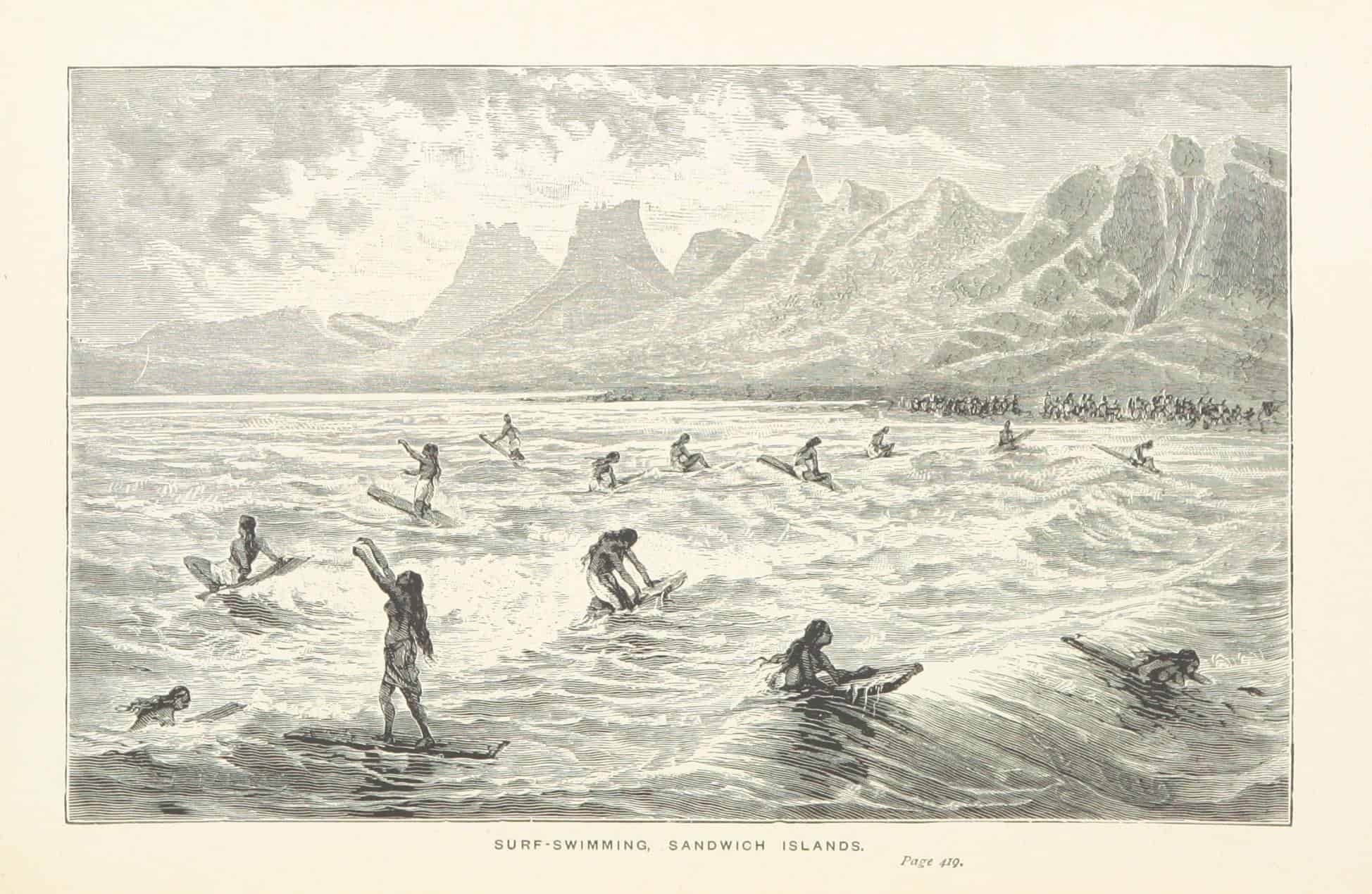Summer in Pittwater: places to stay, ways to play - some History
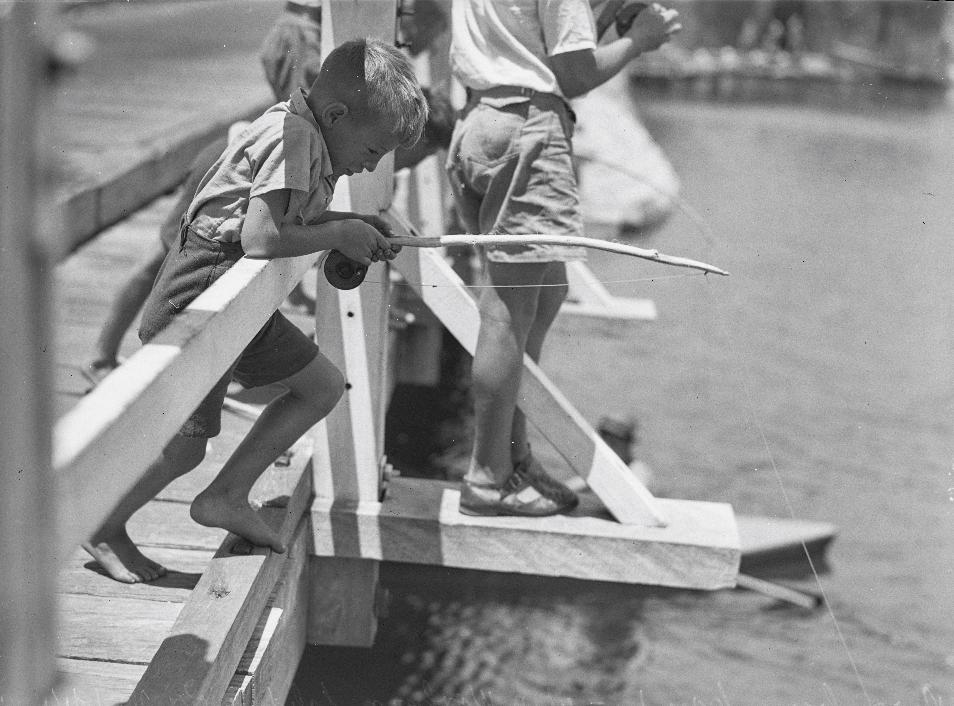
Little boy fishing on Narrabeen Bridge (beach end one) from Album 'Narrabeen camp war workers holiday', picture taken 26 January 1944 / photographed by Alec Iverson, Item: SLNSW_FL9550120 courtesy Mitchell Library, State Library of New South Wales and Courtesy ACP Magazines Ltd. Taken for, but not used in, Article: WAR WORKERS ON HOLIDAY, Pix Volume 13, No.6, February 5 1944 Retrieved from http://nla.gov.au/nla.obj-479760111
With the last weekend of Summer 2024/2025 upon us, the bumper-to-bumper stream of traffic to and from Palm Beach which fills the Barrenjoey road from Governor Phillip Park south to Mona Vale ended, and the first scents and cools of Autumn in the dawn over the past few weeks, one last celebratory dive into the history of what a Summer in Pittwater was once all about.
Summer in Pittwater is a peak ‘Season’, where the Barrenjoey peninsula, from Narrabeen to Palm Beach, becomes a place hosting thousands of visitors and holiday makers enjoying the best place on earth. Permanent residents are either taking to the beach and estuary at dawn or returning at dusk to have an hour or two of uncrowded water, bush and sand, or keeping a protective eye on visitors, and coming to their rescue when called to.
Although Pittwater was stated from the late 1860's on as the bound to be successful location of a 'future resort', and thousands of excursionists visited year round on paddle steamers and later, ferries, it was those making A Run to Pittwater aboard their own vessels or as a fleet from a yacht club, who then stayed aboard their yachts, that began the exodus to Pittwater from Sydney during Summer.
Once places people could stay in were built that the shift from being a food bowl for Sydney, and farmland, towards what would become a holiday area that offered the quieter waters of an estuary and lagoon, beaches and bushland, and abutting a National Park, a Summer in Pittwater became the break to have.
From Boxing Day on Pittwater Regattas brought crowds to the estuary. The first Pittwater Regatta was run in 1888, and aimed at bringing people into the area. The Basin Regattas of the 1890’s, led by the Royal Sydney Yacht Squadron with events for local fishermen when Pittwater was still mainly a farming and fishing food bowl for the colony of Sydney Town, continued this aquatics fun focus, including the RSYS looking at local sites for their 'Pittwater chapter'.
In 1906 two boys from Bayview, John Roche and P T Taylor's eldest son, William Donald Mawney Taylor, 'Don' Taylor, had a little race up the estuary and around Lion Island against a pair of Queenslanders, the Crouch brothers, and the love of sailing or rowing, and doing so competitively, shifted further down the estuary and attracted thousands by the time the post-WWI 1920's and Pittwater Regattas of the 1930's were taking place - the contrast between those struggling during this decade financially and those able on host visitors on yachts and motor launches featured in all Sydney newspapers - also came with pictures that show the still open fields in the background and the holiday homes now dotting the hills among the farm sheds.
Visitors went from camping at The Basin to ‘taking a cottage’ for a week, even during cooler months, or taking up the option of a boarding house, such as The Rock Lily, Collin’s Retreat, later Scotts’ ‘Bay View House’, on Crystal Bay and within a few years, the Newport Hotel, and then the Narrabeen Hotel, or the Mona Vale beachfront resort community envisioned in George Brock's 'The Oaks', although he did not benefit from all his hard work.
PITTWATER.
How this pleasant picturesque watering-places is advancing is well indicated by the opening of a telegraph station there the Saturday before Christmas, 'Our bachelor' and myself intended to be present at the ceremony. We were prevented by the temporary suspension of the vehicular traffic between Manly and there, owing to the supply not being equal to the demand. The extra demand on that day from visitors to Newport and holiday parties taxed the resources of the Manly coach proprietors; but by the exercise of a little patience and with the loss of a little time all were accommodated.
The road between the lagoon at Manly and Dee Woy Lagoon has been stripped of many of its charms. Formerly it was like a woody winding line odoriferous as a flower garden at dewy eve or early morn ; now it is tame and treeless, here and there shorn of most of its glory by bush vandals and land jobbers.
There are four public-house between Manly and Newport, two of which, I believe, have been built since the unemployed were set to work at Frenchs Forest and Narrabeen. How the tenants and owners of the houses can make a living is a mystery. Perhaps their owners are far-seeing men, who have speculated in anticipation of the Pittwater tramway (the bill for which was lately passed) being constructed.
When we arrived at Pittwater harbour the day was declining, but the gala remained in all its glitter. Mr. Cracknell, who performed the opening ceremony had departed with some others for Sydney ; but the notabilities of the locality were in no hurry to leave, having their gondolas at hand to convey them home.
A few years have made a great change in Pittwater. The western shore of the harbour is all under cultivation. Fruit trees of all kinds flourish there, and some vegetables can be produced a fortnight earlier than around Sydney. Fish is abundant in the harbour. We assisted at three hauls of the net of our host, Mr. Bulfin. 'Our bachelor' and another gentleman donned fishing garb for the occasion, put their shoulders to the wheel, or rather to the ropes and towed very well indeed for amateurs. Our labours were attended with but moderate success.
There is much inquiry for land in Pittwater now, the prospect of the tramway thither doubtless stimulating it. Scotland Island, in the middle of the harbour, area about 150 acres, has been sold to a Melbourne company for £2,500.There is some speculation as to what they are going to do with it. The impression prevails that it is to be utilized for a marine public resort.
It was also said down there that a that a well-known gentleman on the North Shore intends building a large marine hotel on the eastern shore of the harbour, between Stokes's Point and the new wharf. It is a very eligible site if trade could be commanded; but that, no doubt, would come to a well-conducted house.
A place there would be easy of access from the harbour, the new wharf affording facilities for landing found nowhere else in the Pittwater peninsula. The largest excursion steamers can come alongside it in all weathers, there being a depth of over 18 feet at low water.
The romantic marine retreat of the late lamented Mr. Dalley on Cabbagetree beach, underlying Bilgola head on the Pacific shore, has been purchased by Mr. Jackson. Mr. J. M. Taylor, our bachelor (so designated from having obtained his B.A. degree as an evening student at the University the morning of our visit), was delighted with Pittwater. As a holiday retreat he would prefer it to the mountains principally because 'There is a society where none intrudes By the deep sea, and music in its roar.' C. B. PITTWATER. (1889, January 12). Freeman's Journal (Sydney, NSW : 1850 - 1932), p. 17. Retrieved from http://nla.gov.au/nla.news-article115380870
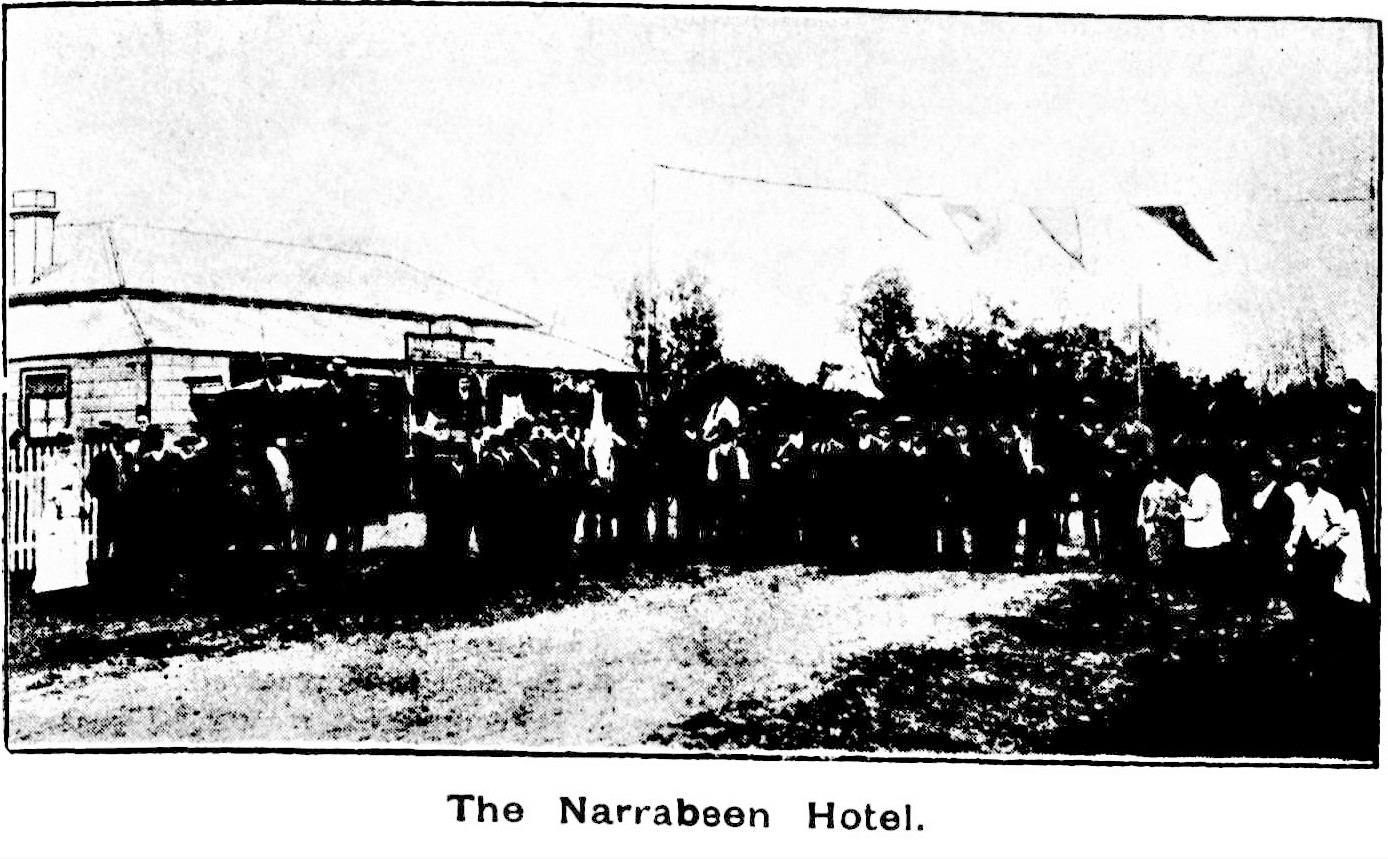
There is a stopping place at the Narrabeen Hotel, kept by Mr. Norris-a most charmingly situated hotel facing the road, the picture of which will give you a good idea of the number of travellers who frequent this place. Close to the hotel are the celebrated Narrabeen Lakes, where there is splendid fishing, shooting, and boating, to be had within a half-a-mile of the hotel. Mr. Norris makes a specialty of providing boats, camping outfits, lunches, etc., for parties coming from town to spend a day or two in this lovely district.: A Christmas Holiday Trip Narrabeen Hotel Picture: [No heading]. (1893, November 25). Illustrated Sydney News (NSW : 1853 - 1872), p. 15. Retrieved from http://nla.gov.au/nla.news-page4846491
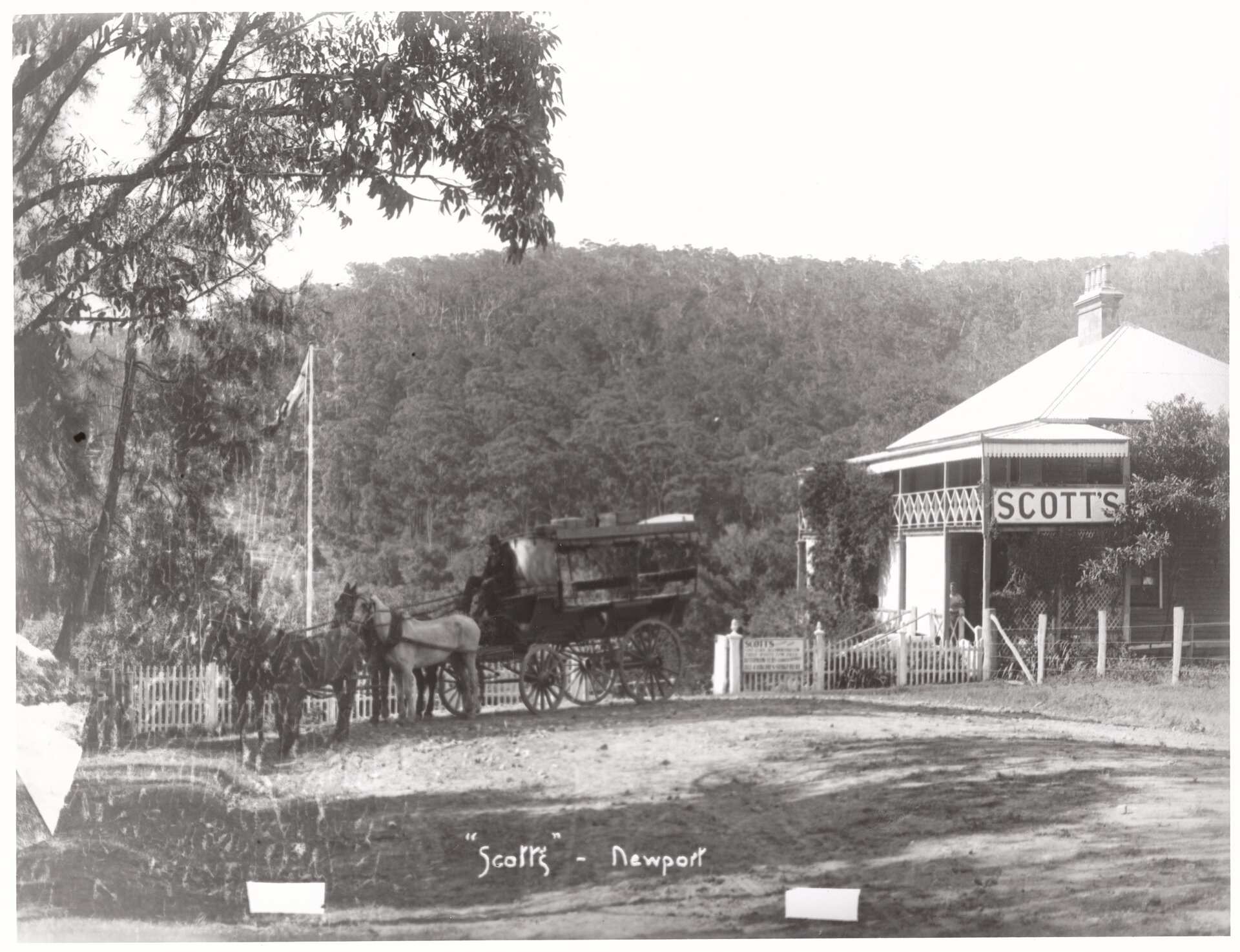
Scotts on Crystal Bay at Newport, circa 1899-1900 - Item: FL11283178, courtesy NSW State Records and Archives
Later premises along the 'restaurants you could also stay at' line were La Corniche and then The Pasadena Road House at Church Point, Barrenjoey House at Palm Beach, and Jonah's, overlooking Whale Beach. Many of these would provide entertainment in the form of music and cabaret
Between the early 'hotels' were boarding houses such as The Green Frog at Church Point, later there were the Palm Beach House and then Florida House at Palm Beach, Ocean Beach House at Newport and Ocean House at Narrabeen - both on the beachfront - as just a few examples of what was available.
One who stayed in a for hire Pittwater cottage in the early 1900's describes:
PITTWATER.
I will write and tell you about a delightful holiday Flo and I had a few weeks ago. We had grown rather tired of the Mountains, and thought a seaside place would be a change, so at last we decided on Pittwater. We started one Friday afternoon, and, catching the 3 o'clock boat to Manly, reached it in plenty of time for the Pittwater coach, which left Manly shortly after 4 o'clock, and arrived at Pittwater in time for dinner.
Although we had a 12 miles' drive by coach, still we did not find it a tiresome one, for the road was good all the way; besides, the scenery was so beautiful. All along the route there was something interesting to look at.
Now we were passing through a forest of tall trees and beautiful cabbage-tree palms, and wild flowers growing in great profusion; and then suddenly we were confronted in all its grandeur by the ocean itself. And so on we drove, until Church Point, which is as far as the coach goes, was reached, and we found ourselves on the shores of Pittwater.
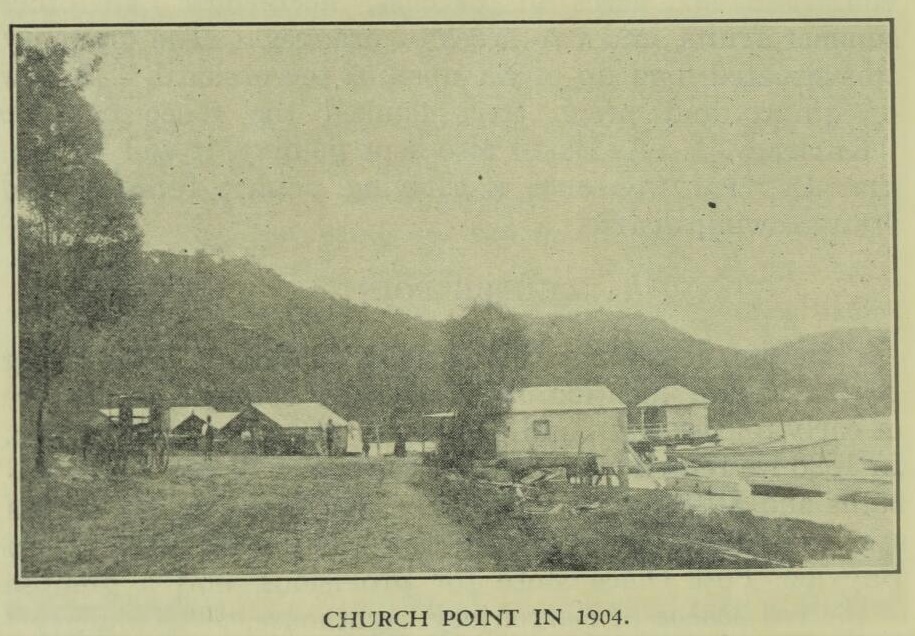
CHURCH POINT IN 1904.
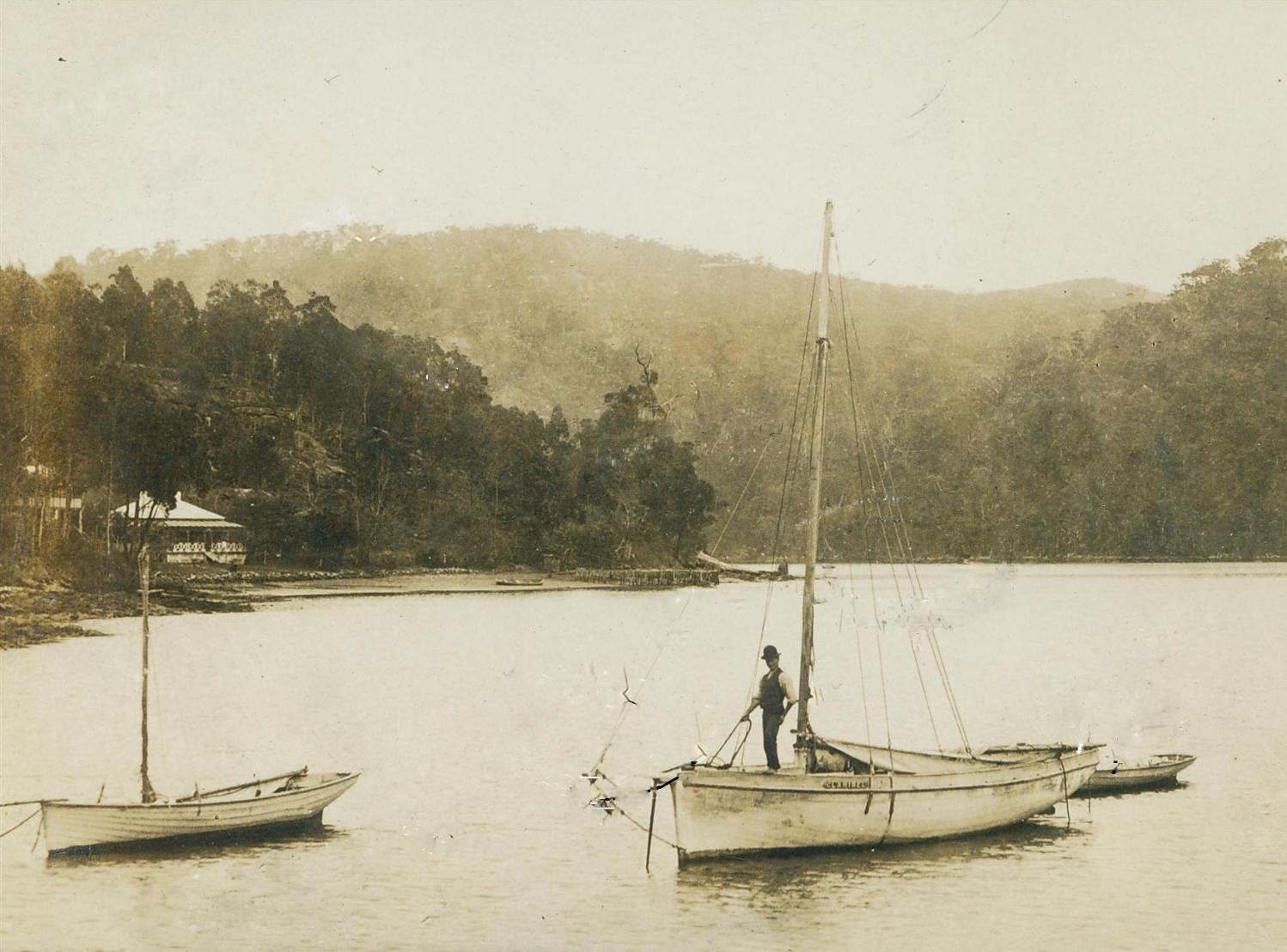
We had made arrangements beforehand as to what coach we would come down by, so we weren't surprised on leaving the coach to find a small motor launch waiting to convey us to our destination.
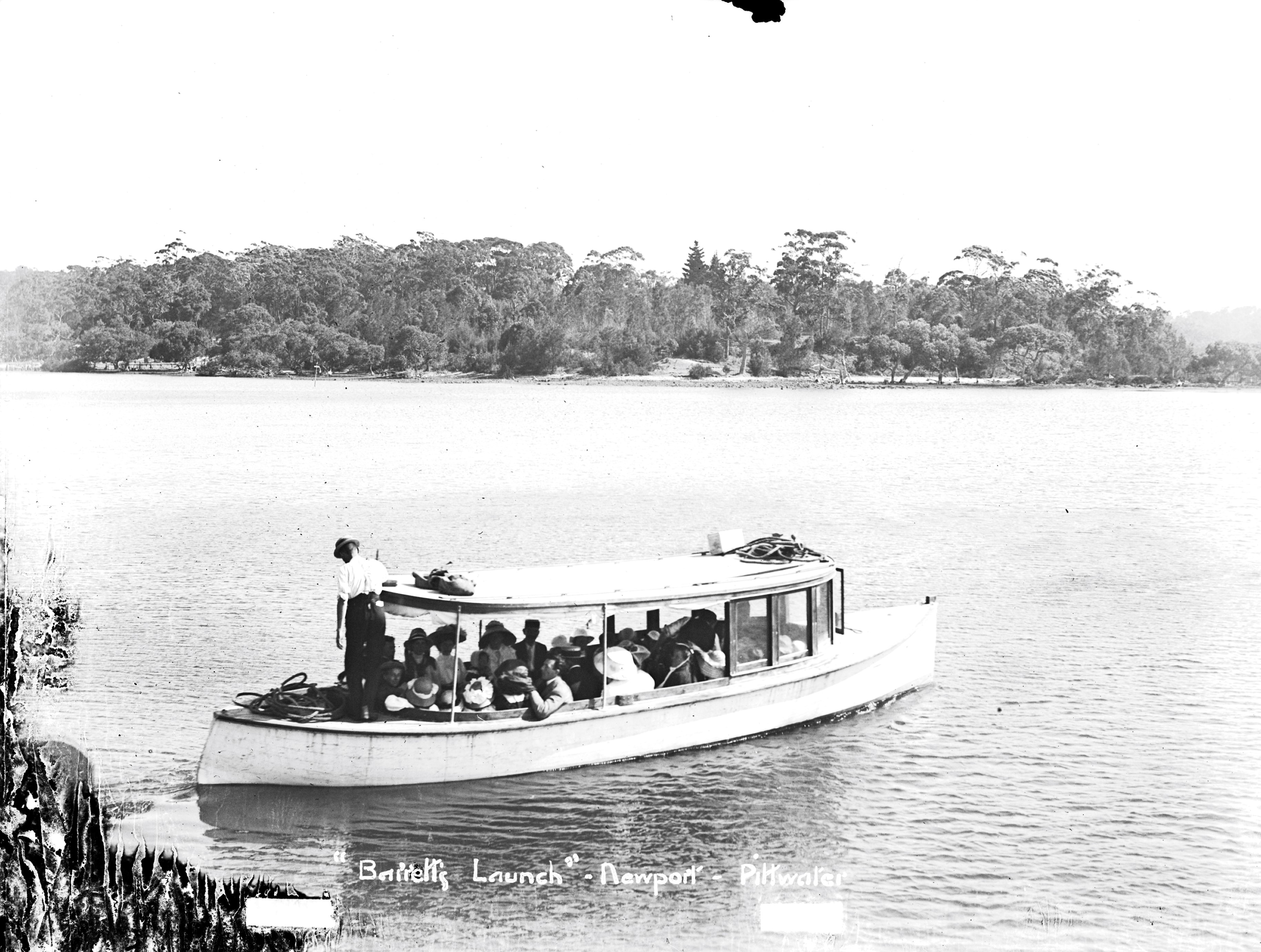
Above: Barretts' launch at Newport, Dated: circa 31/12/1908, Digital ID: 18526_a024_000028, courtesy State Records of NSW
After about 10 minutes in the launch we entered a pretty little bay surrounded almost by mountains, and picturesquely situated on the side of one of these was the cottage which was to be our abode for the next ten days.
Next morning we awoke early and made a tour of inspection, and were delighted with the place, for, besides having nice orchards, cows, poultry, plenty of milk, eggs, cream, and oysters, we discovered a bathing-place securely fenced off and boats if we cared to fish or row.
After break-fast the little launch in which we had come across in the previous evening, and which belonged to the house, was waiting at the pier to take us to see some of the beauty spots round about. That morning we went up as far as the Barrenjoey Heads, which are the entrance to it from the ocean side. On the South Head is the famous Barrenjoey lighthouse. Then we went round Lion Island into Brisbane Water, on to the mouth of the Hawkesbury River, and on our way back landed at Barrenjoey to inspect the light-house, and thence homewards, after having spent a most enjoyable day.
Next day we went in quite an opposite direction, and soon found ourselves in the Kuring-gai Chase. Leaving the launch, we followed the path up the mountain. At first we anticipated rather a dreadful climb, but soon the beauty of the flowers and ferns attracted our attention, and so onward we pressed until the summit was reached.
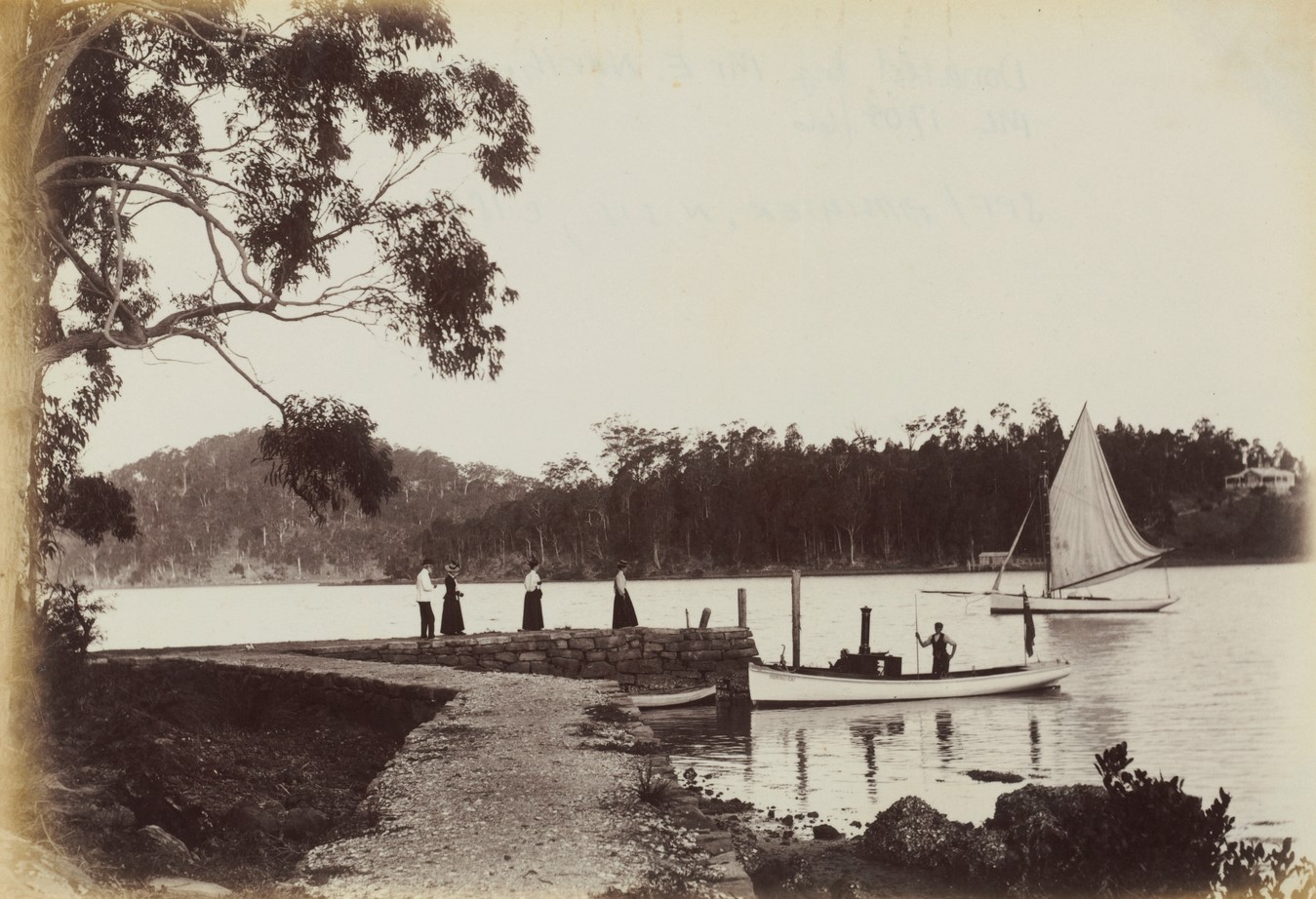
Lovett Bay and the Ku-Ring-Gai Chase Trust built causeway and the Trusts' launch, circa 1901-05. Image No.: a4367001h, courtesy State Library of NSW
Sitting down, we gazed on the surrounding scene — one of the most glorious I had ever looked upon. Down beneath us was the water sparkling like diamonds in the Summer sunshine, and jutting out into it a large isthmus richly clothed in all its beautiful verdure and foliage; whilst studded here and there among the trees were tiny cottages. Then further on Church Point, and Scotland Island appeared; and still further on Bayview and Newport.
And so our days were spent exploring new places, picnicking, and fishing, until at last the morning came for our departure homewards. And it was rather unwillingly that we bade farewell to beautiful Pittwater. Our board, which was very good indeed, cost us 30s a week; and as there were two of us, and we stayed ten days, it came to £4 6s, a slight reduction being made for staying over the week. The coach journey cost 6s return for the two or us, and out fares by tram and ferry 1s each, making in all £4 14s. This covered everything excepting tips, but as everyone has his or her idea on that subject I thought it best to leave that item out.— CONSTANCE (Enmore). PITTWATER. (1906, December 23). Sunday Times (Sydney, NSW : 1895 - 1930), p. 4 (The Sunday Times Magazine Section). Retrieved from http://nla.gov.au/nla.news-article126553173
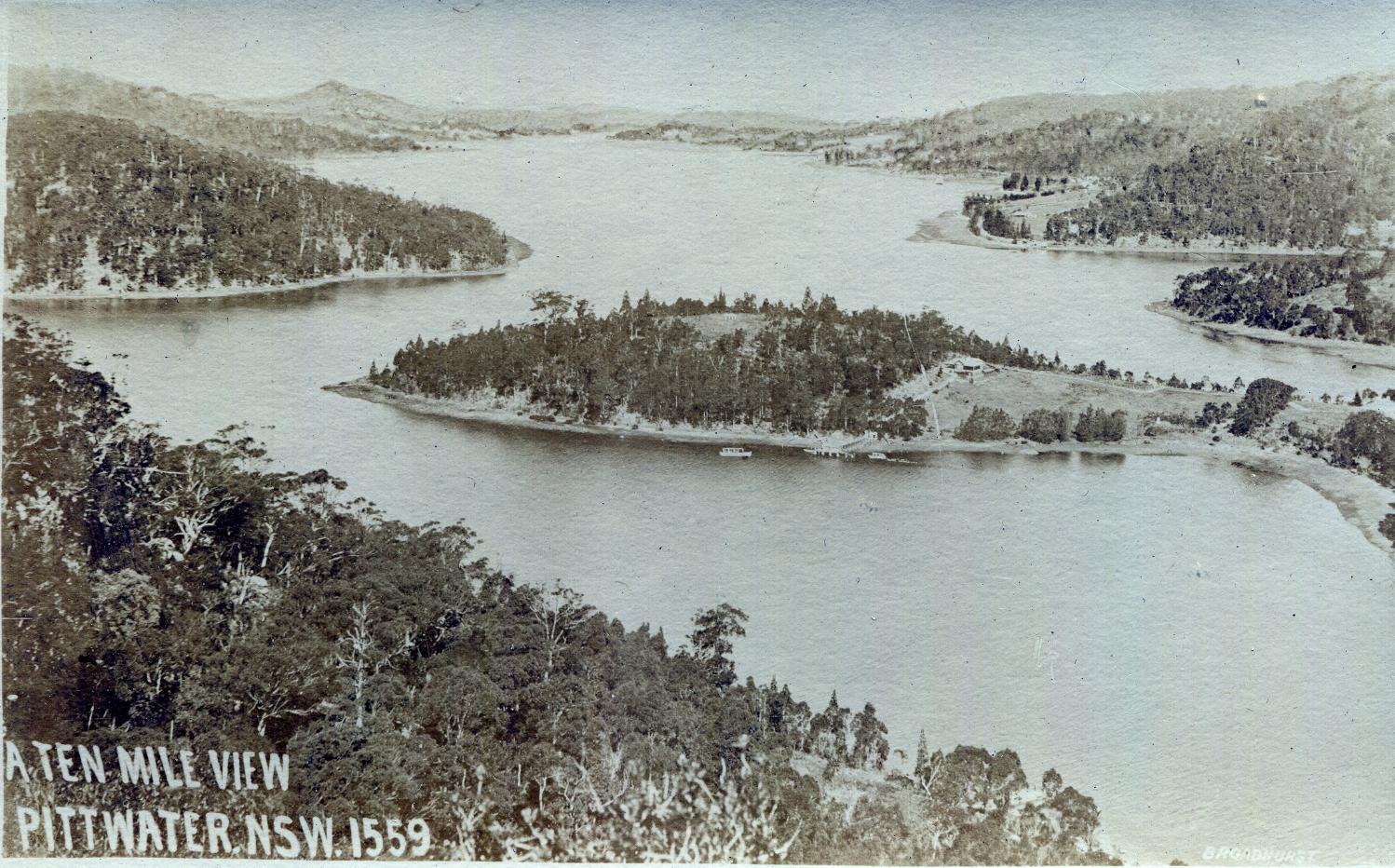
Within a few decades this became ‘taking a summer house’ or buying a block of land and building one at at Palm Beach, Careel Bay, Avalon, Narrabeen, Bayview and Mona Vale for a week or two or the whole ‘Season’ – many of these places the weekenders or Pittwater Summer Houses of some of Sydney’s then most successful doctors, industrialists, dam-builders, inventors and department store owners.
A few others runs this Season provide and insight into Pittwater's Summer Houses - those included:
- Pittwater Summer Houses: Florida House, Palm Beach
- Pittwater Summer Houses: Cooinoo Bungan Beach
- Pittwater Summer Houses: Bangalla, Scotland Island
These doyens of Sydney bought into Palm Beach from the 1912 land subdivisions on – all sold under the auspices of escaping the dusty hot town of Sydney during the hotter months to dwell in a place still untouched where they may connect with the green and blue and indulge in ‘surf bathing’ amid cool sea breezes or sail on the estuary while camping out on houseboats, steamers and their own yachts.
For others there was the tram that brought them to the edge of Narrabeen Lagoon. This was followed by motor camps and tent camp sites, and even those camping on a block of land they had bought, and ordered not to by the then Warringah Shire Council.
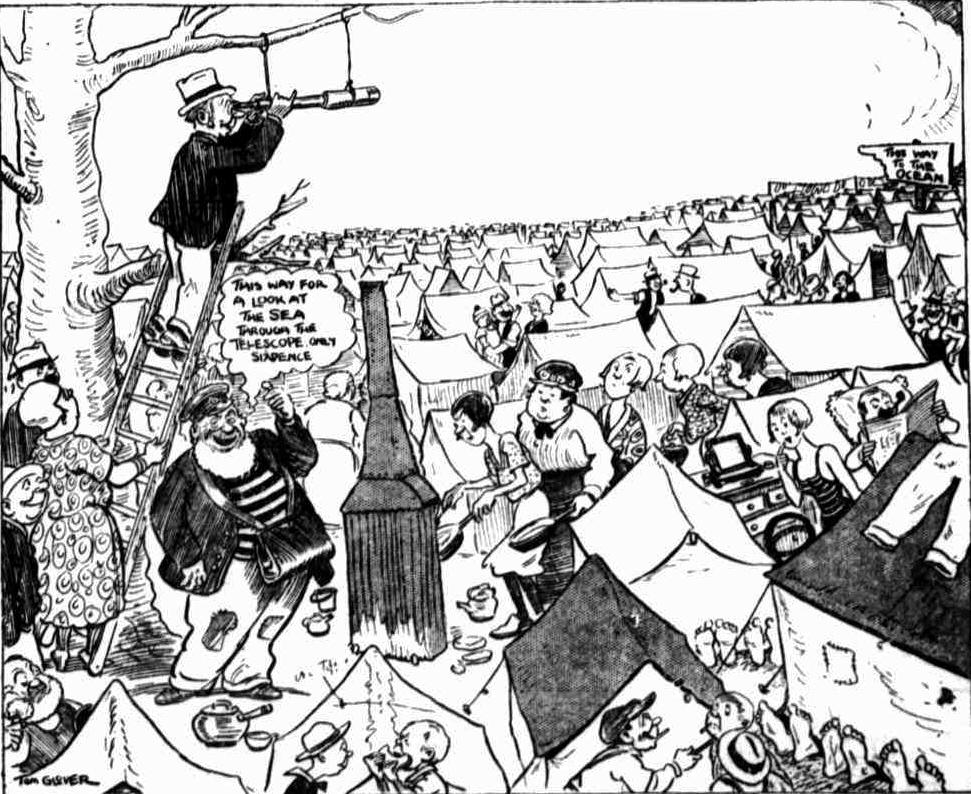
The Warringah Shire Council has received complaints about the crowded condition of the camping areas at Palm Beach. On some blocks more than 60 persons are living. Over 20,000 persons visit the beach on fine Sundays. What will it be like in five years' time? VISUALISING THE CAMPERS' PARADISE (1930, January 15). The Sun (Sydney, NSW : 1910 - 1954), p. 13 (LAST RACE EDITION). Retrieved fromhttp://nla.gov.au/nla.news-article226022076
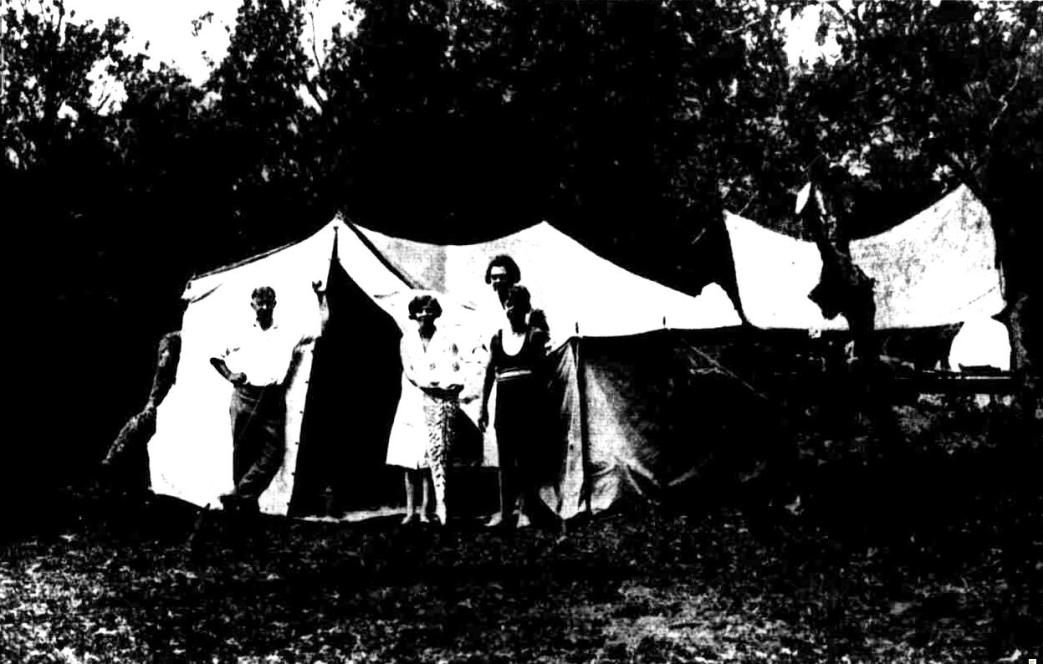
Monte Luke, le célèbre artiste photographe de Sydney, Madame Monte Luke et leur famille à Avalon Beach, près Sydney. LE "MOTOR CAMPING OUT." (1928, October 26). Le Courrier Australien (Sydney, NSW : 1892 - 2011), , p. 3. Retrieved from http://nla.gov.au/nla.news-article161724364
MOTOR CAMP AT AVALON
The N-R-MA has made arrangements for establishing a summer motor camp at Avalon Beach, 22 miles from Sydney, between Narrabeen and Palm Beach. There is a fine surf beach at 'Avalon, and a nine hole golf course, on which members of the association are entitled to play at a reduced fee. A tennis court is situated nearby. All stores and petrol supplies may be obtained at Avalon. Full details of the camp may be obtained from the N-R MA. Touring Department. MOTOR CAMP AT AVALON (1934, November 29). Glen Innes Examiner (NSW : 1908 - 1954), p. 9. Retrieved from http://nla.gov.au/nla.news-article183575064
Avalon Beach Reserve
THE Warringah Shire Council has ad1 vised the N.R.M.A. that action is to be taken to effect the resumption of the whole of the land between Avalon Beach reserve and the Old Barren joey road with the execution of a rectangular portion at the junction of Avalon Parade and Old Barrenjoey road, on which a shop is situated. The association, when advocating the resumption, pointed out that the existing reserve is narrow and sandy, and does not offer facilities for car parking. The area which it is proposed to resume is admirably suited for camping and picnicking. Avalon Beach Reserve (1936, May 13). Sydney Mail (NSW : 1912 - 1938), p. 44. Retrieved from http://nla.gov.au/nla.news-article160638679
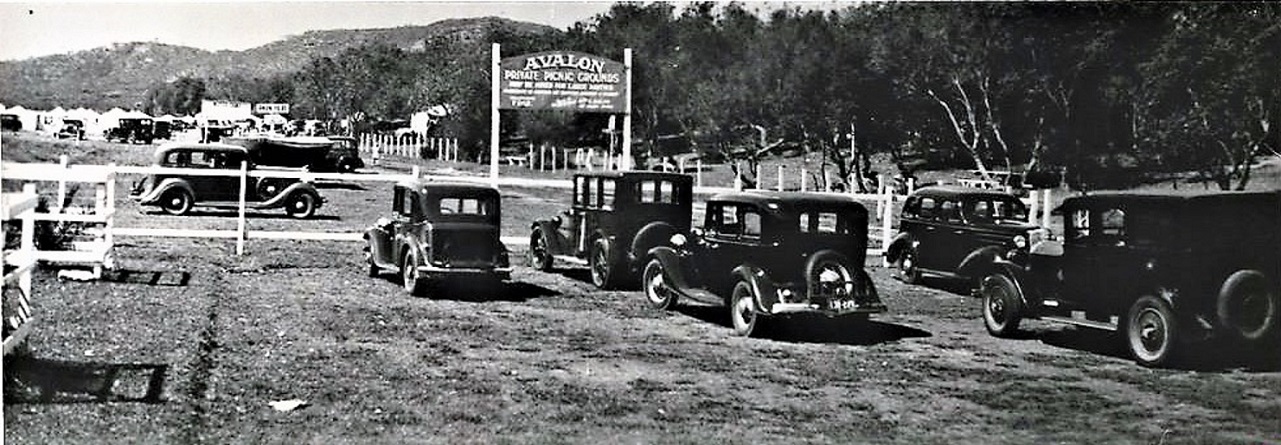
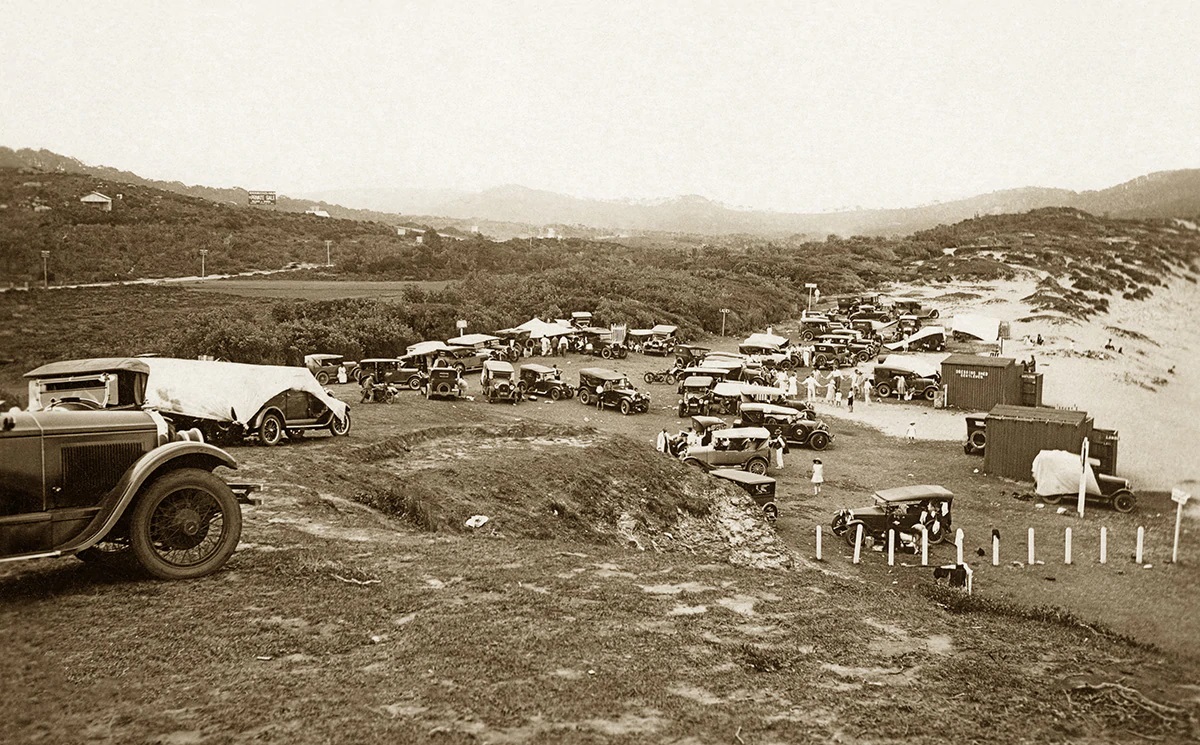
Avalon Beach and sand dunes circa 1931, courtesy National Library of Australia.
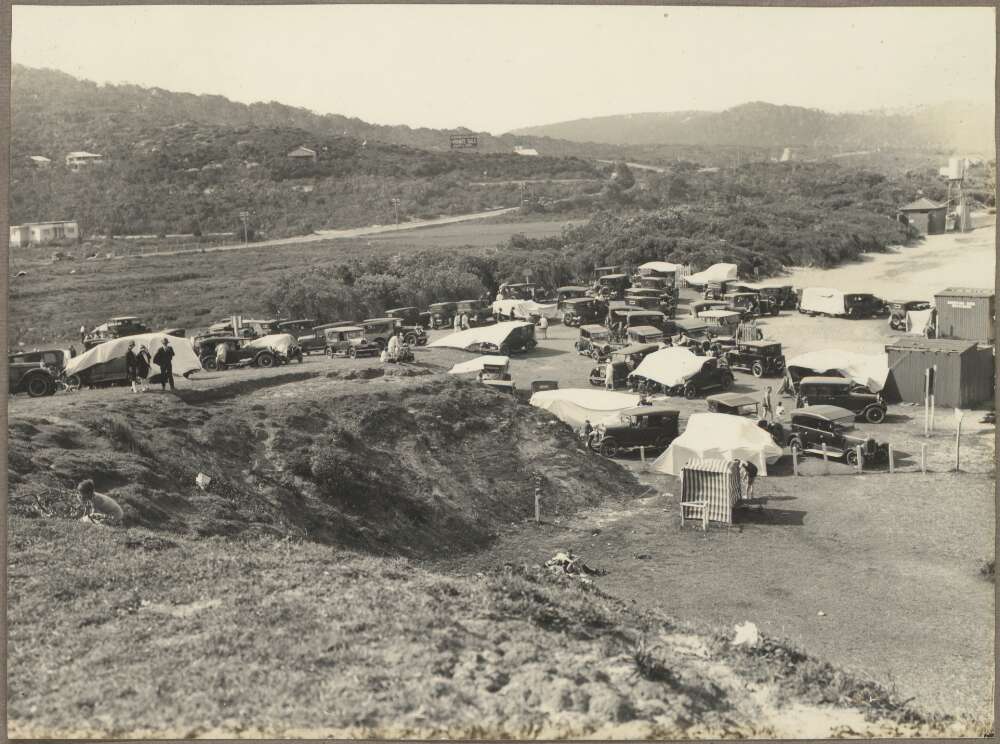
(1930). [Motor cars, some with tarpaulins attached, parked adjacent to Avalon Beach, New South Wales, 1930, 2] Retrieved from http://nla.gov.au/nla.obj-147290238 - and enlarged section from to show the Recreation Reserve as it was then
RECORD CROWDS. BEACHES THRONGED.
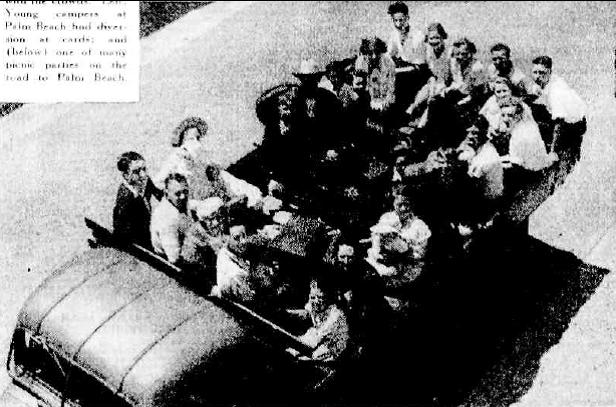
Trunks Generally Favoured by Bathers.
More than 100,000 people visited Sydney beaches yesterday. Five out of every six men bathed in trunks, in spite of regulations, and thousands of people travelled from their homes, on buses and trams, in shorts or playsuits over bathers, and dispensed with dressing sheds.
Figures for all beaches, based on turnstile figures at Coogee. Bondi, and Manly, where attendances reached record figures, were as follows:
Bondi . 30.000 Manly . 27,000 Coogee . 15,300 Bronte . 9,000 Clovelly . 8,000 Nielsen Park . 12,000 Balmoral . 9,000 Maroubra . 6,000 Palm Beach. 4,000 Newport 4,000 Deewhy . 4,000 Collaroy 5.000 From the point of view of styles In beach wear and beach customs, the day set a new standard in modernity.
THE SPEED LIMIT.
The 30 mile an hour speed limit did not apparently inconvenience the traffic to and from the beaches. Motorists in general seemed i to be travelling at the usual pace.
Clear skies and a fresh breeze early in the morning roused people from their beds, eager to get down to the beaches before the weather changed. Most of the beaches close to the city were crowded early in the morning. By 11 a.m. a steady stream of traffic was beginning to move out to the farther beaches.
PALM BEACH POPULAR.
Palm Beach was a popular goal for holiday-makers. Its usual holiday population of house parties was amplified this Christmas by an even larger 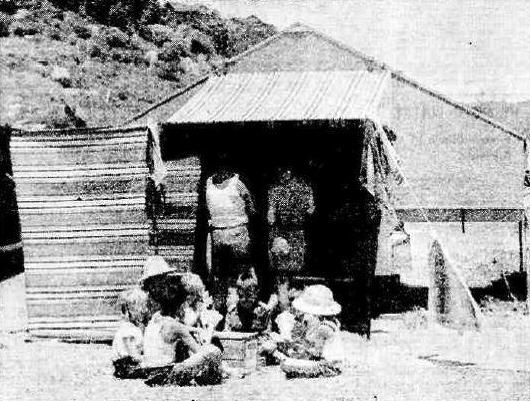 colony of trailers and camping motorists. Every site on the camping reserve was occupied. Some of the trailers and caravans were of remarkable design.
colony of trailers and camping motorists. Every site on the camping reserve was occupied. Some of the trailers and caravans were of remarkable design.
The scene, with the surrounding green country, the rich coloured sand, the gay parties of sunburnt people in bright swimming costumes under rainbow sunshades, and the background Of white and blue surf, was like something out of a well-produced revue.
Here, one felt, the holiday was more than a chance to Iie in the sun and swim in the surf. It was a fashion parade as well, and it was Sydney's first massed gala parade In the world's most, modern costumes.
ROLLICKING SURF.
By midday a brisk breeze had worked up a rollicking surf all along the coast. Rubber floats were at a premium. All the morning at Palm Beach, Newport, Avalon, and Deewhy, a steady Stream of traffic kept bringing more surfers. They arrived in every form of conveyance; there was even an odd sulky here and there on the road. There were several open lorries, their rattling boards populated by families out to have a good time at any price. There were cyclists by the hundred. Motor cycles flashed through the traffic with girls in shorts bouncing on the pillions. There were cars that could hardly crawl up the hills filled to capacity with family parties and everybody's luggage strung on the back. There were sleek, high-powered cars dashing In subversive spurts of 60 miles an hour through the 30-mile speed limit areas.
RECORD CROWDS. (1937, December 27). The Sydney Morning Herald (NSW : 1842 - 1954), p. 7. and p.10 photographs: (Titles: Young Campers at Palm Beach had diversion at cards and Above: one of many picnic parties on the road to Palm Beach) Retrieved from http://nla.gov.au/nla.news-article17439253

Narrabeen 27 December 1933 Lake Park store in background . Item: SLNSW_FL19127965, courtesy State Library of NSW
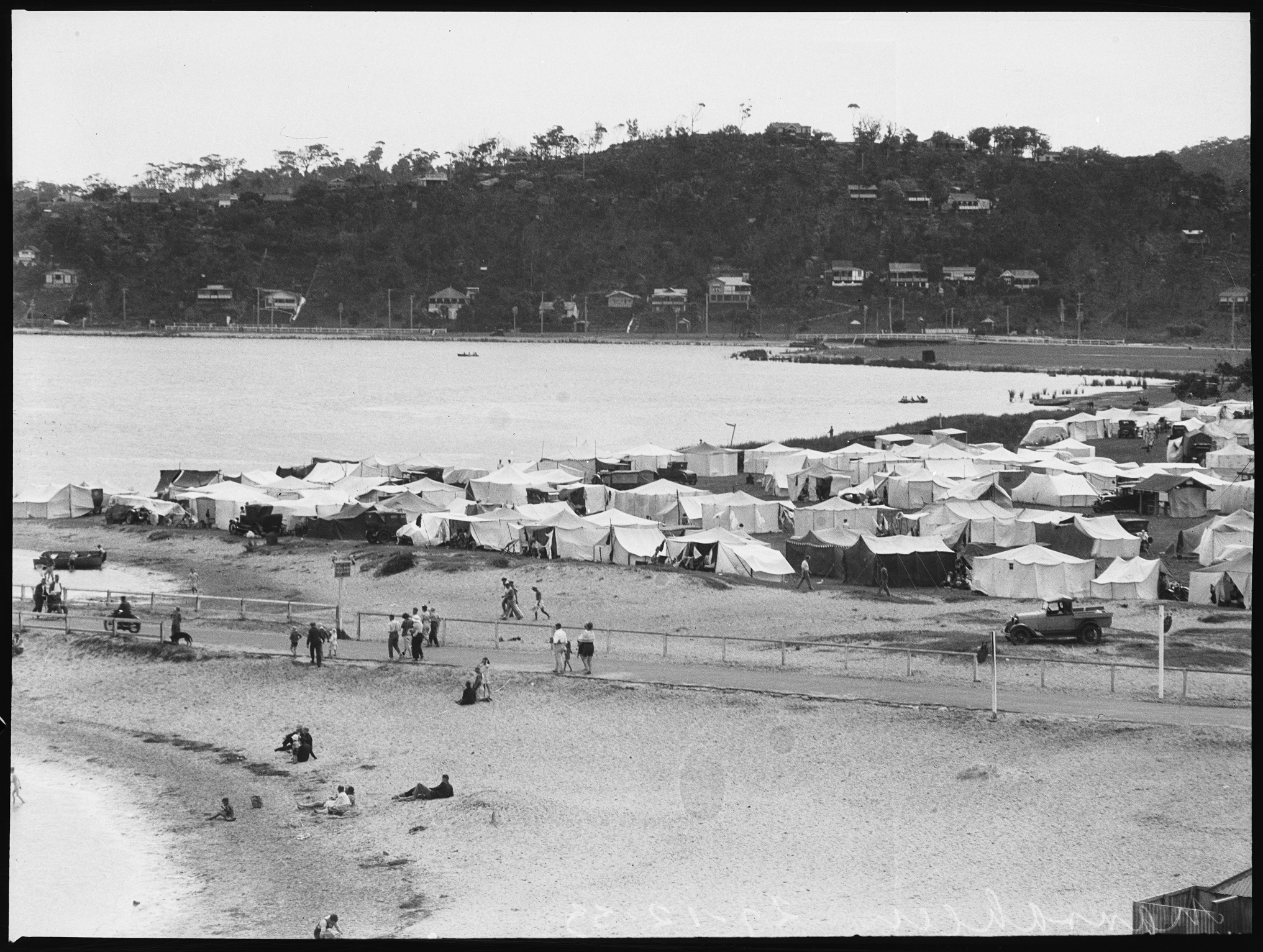
Narrabeen camp Lake Park - reclaimed oval in background 27 December 1933 Item: SLNSW_FL19127989, courtesy State Library of NSW
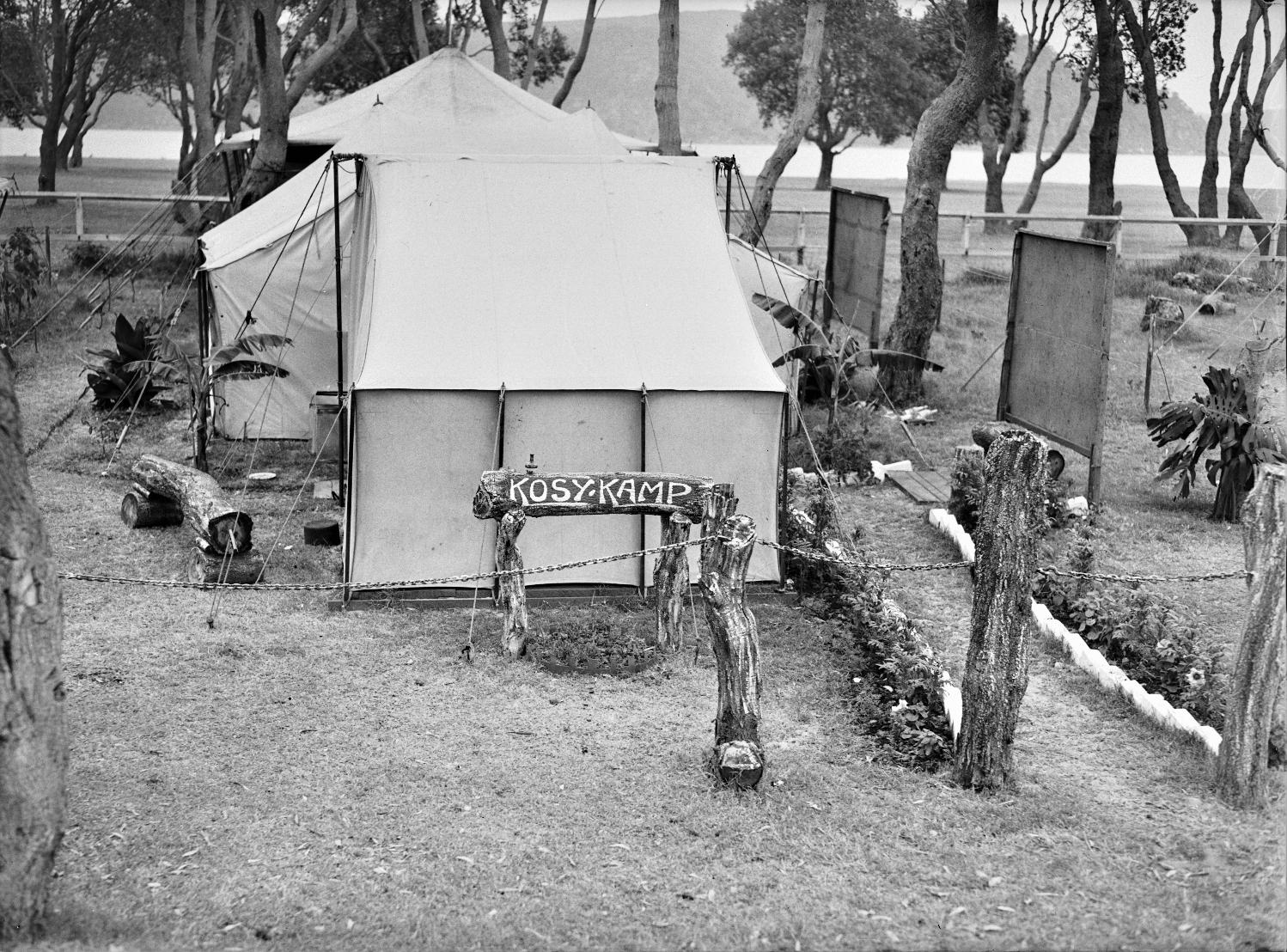
Narrabeen war workers holiday camp, 26 January 1944, by Alec Iverson for PIX magazine, from original negative, ON 388/Box 019/Item 001 archival.sl.nsw.gov.au/Details/archive/110588546, courtesy State Library of New South Wales. The article that ran these, retrieved from the National Library of Australia's digitised archives shows:
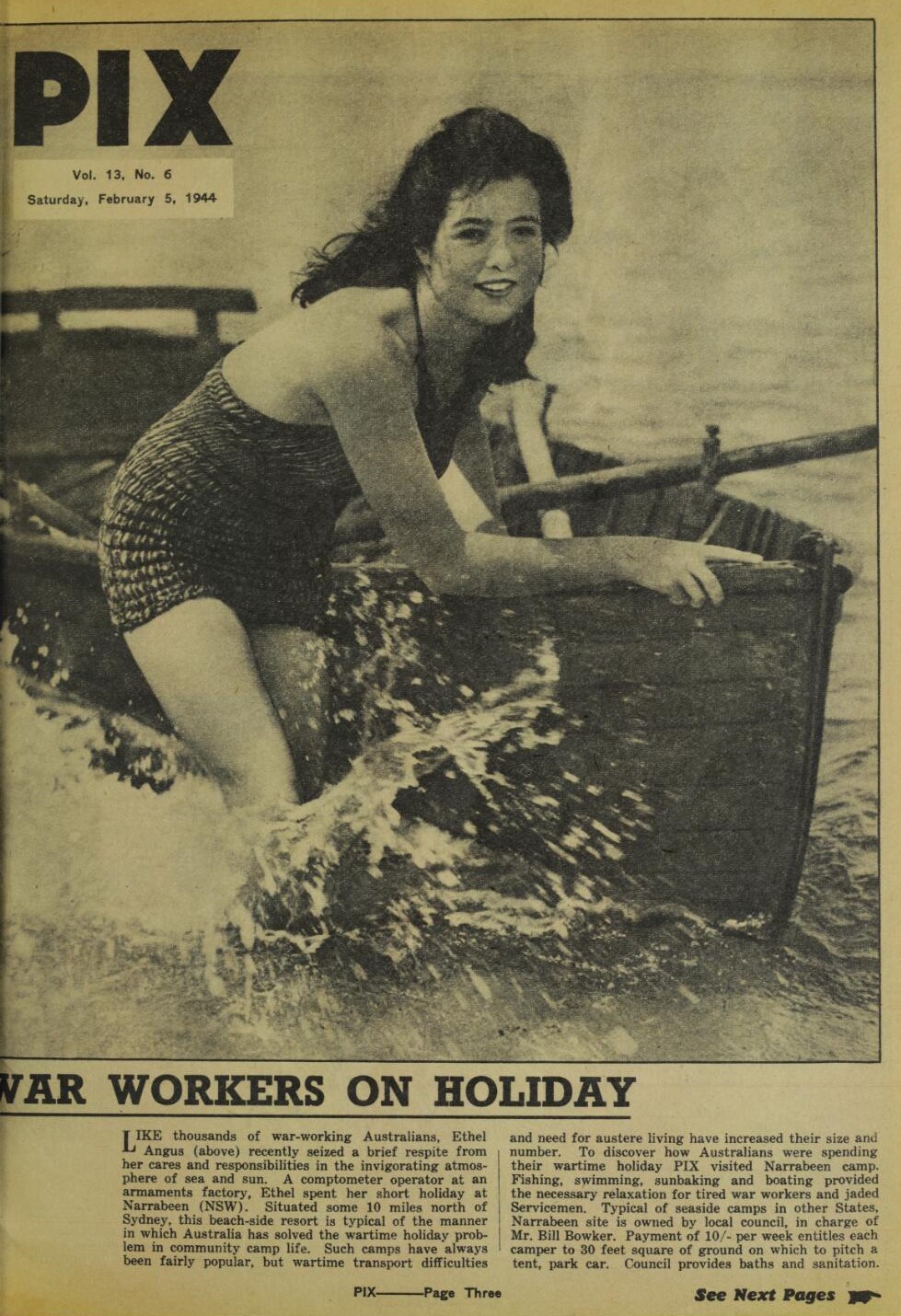
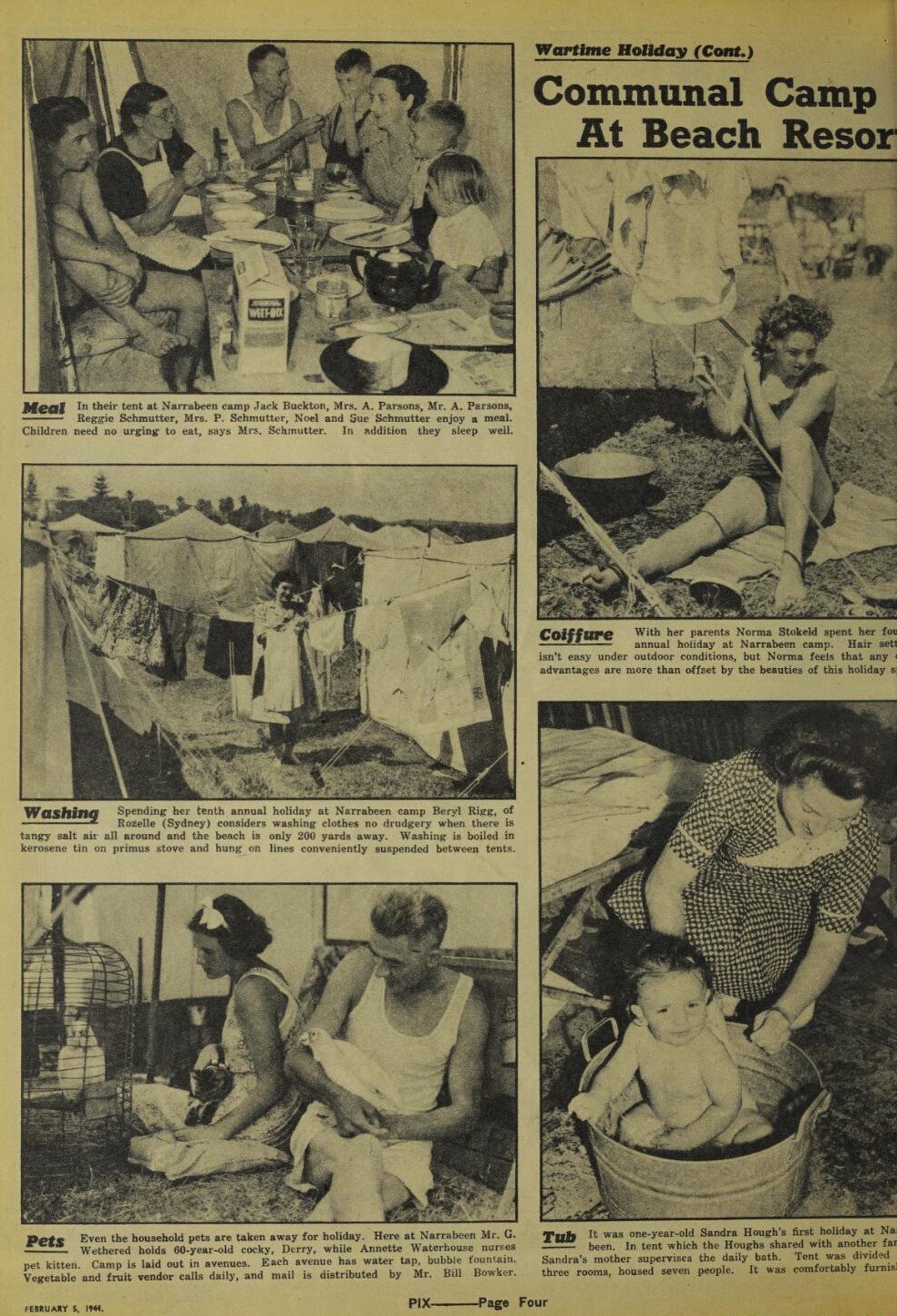
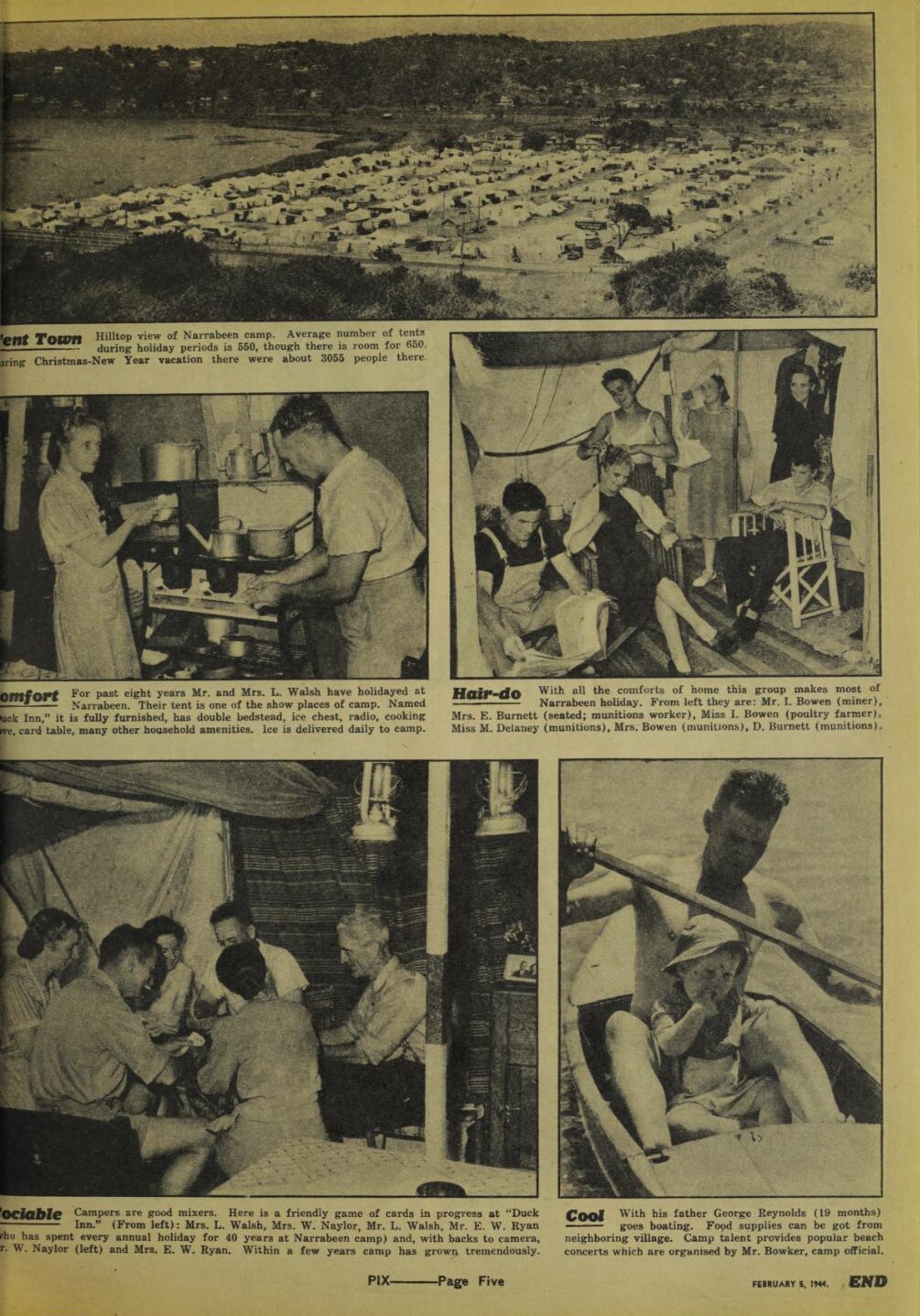
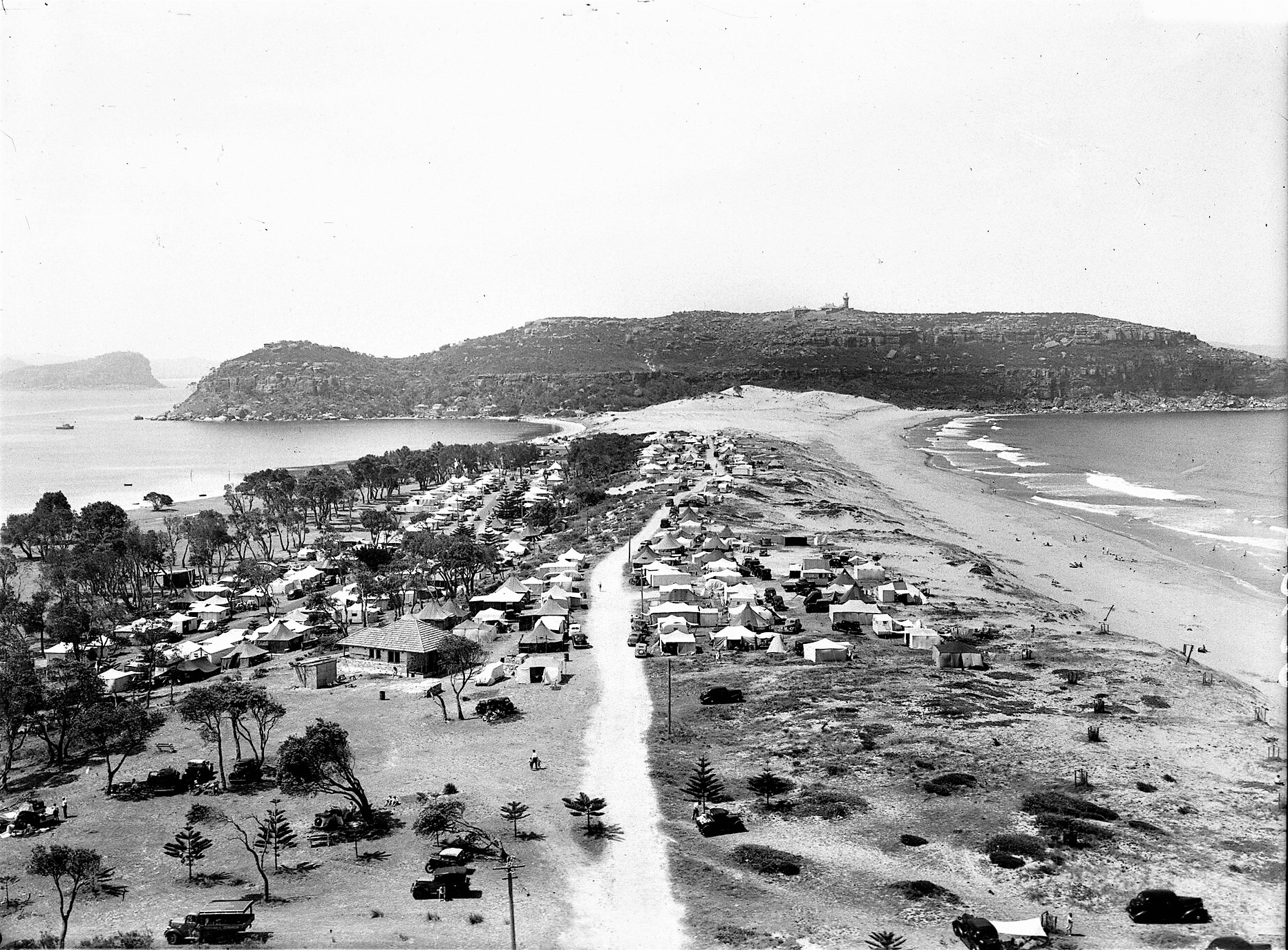
Palm Beach 1946. From NSW Government Printer series: Pittwater, courtesy NSW State Records and Archives. Item: FL3733992
Even for those not made homeless during the Great economic Depression of the 1930’s, Pittwater attracted thousands for their spot of sand on a local beach or aboard everything from a tinny to a cruiser on the estuary or camping out at The Basin. With the advent of a public transport system where they could catch a bus and then ferry, or all pile into a truck and head to Pittwater to camp out in cars or in these campsites, and experience that ‘democracy on the sand’, Pittwater became the place to be.
.jpg?timestamp=1706738681565)
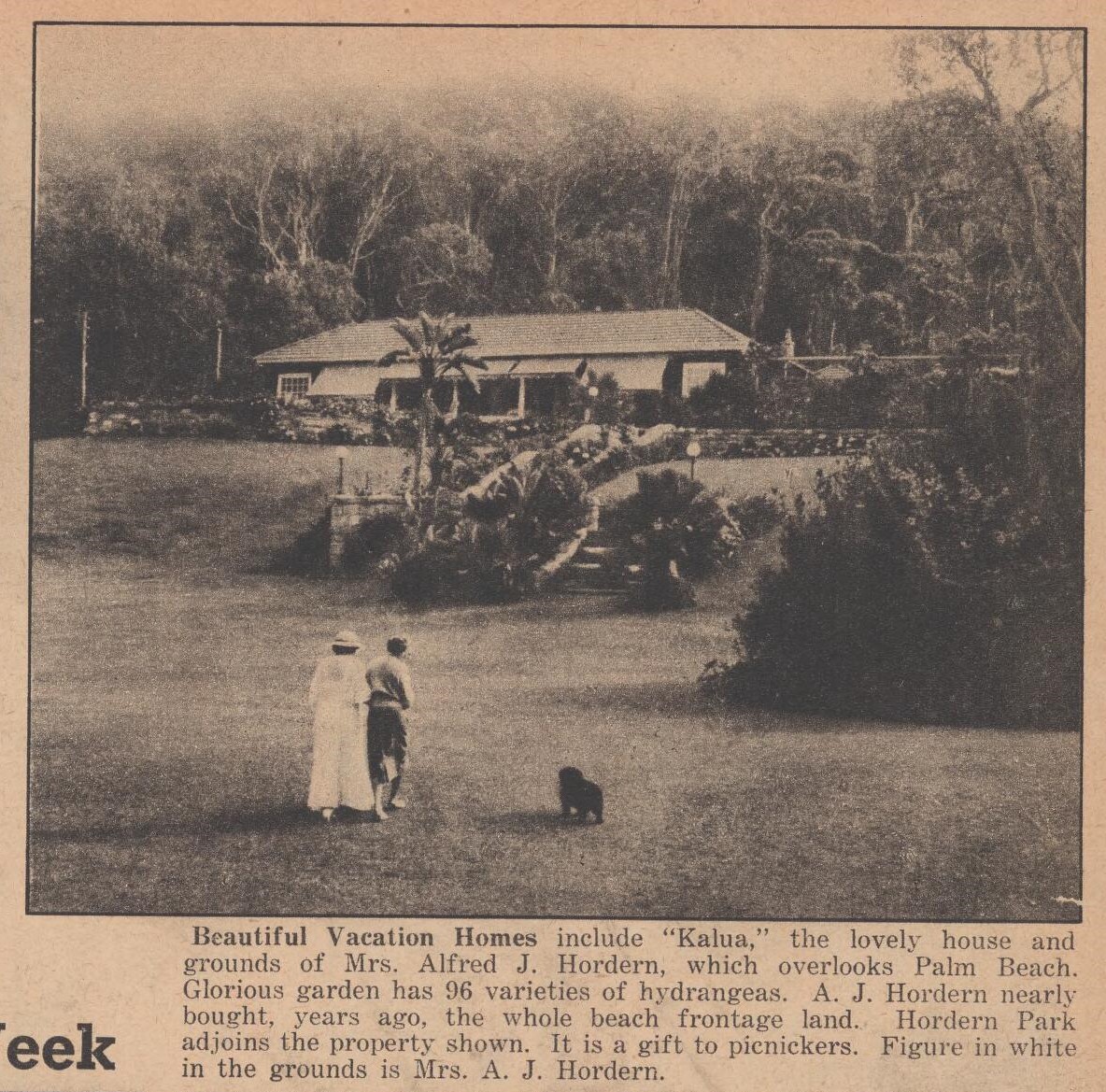
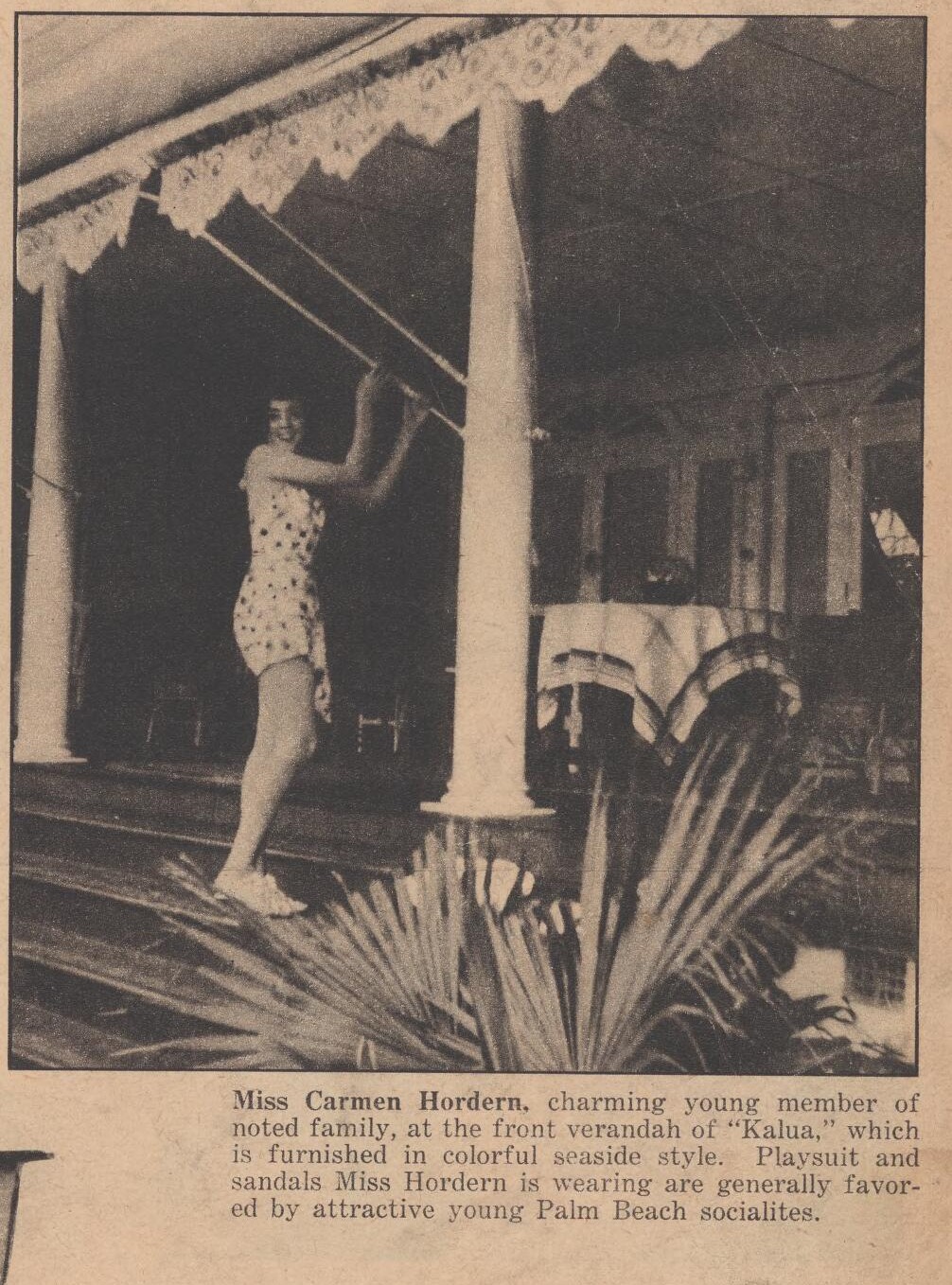
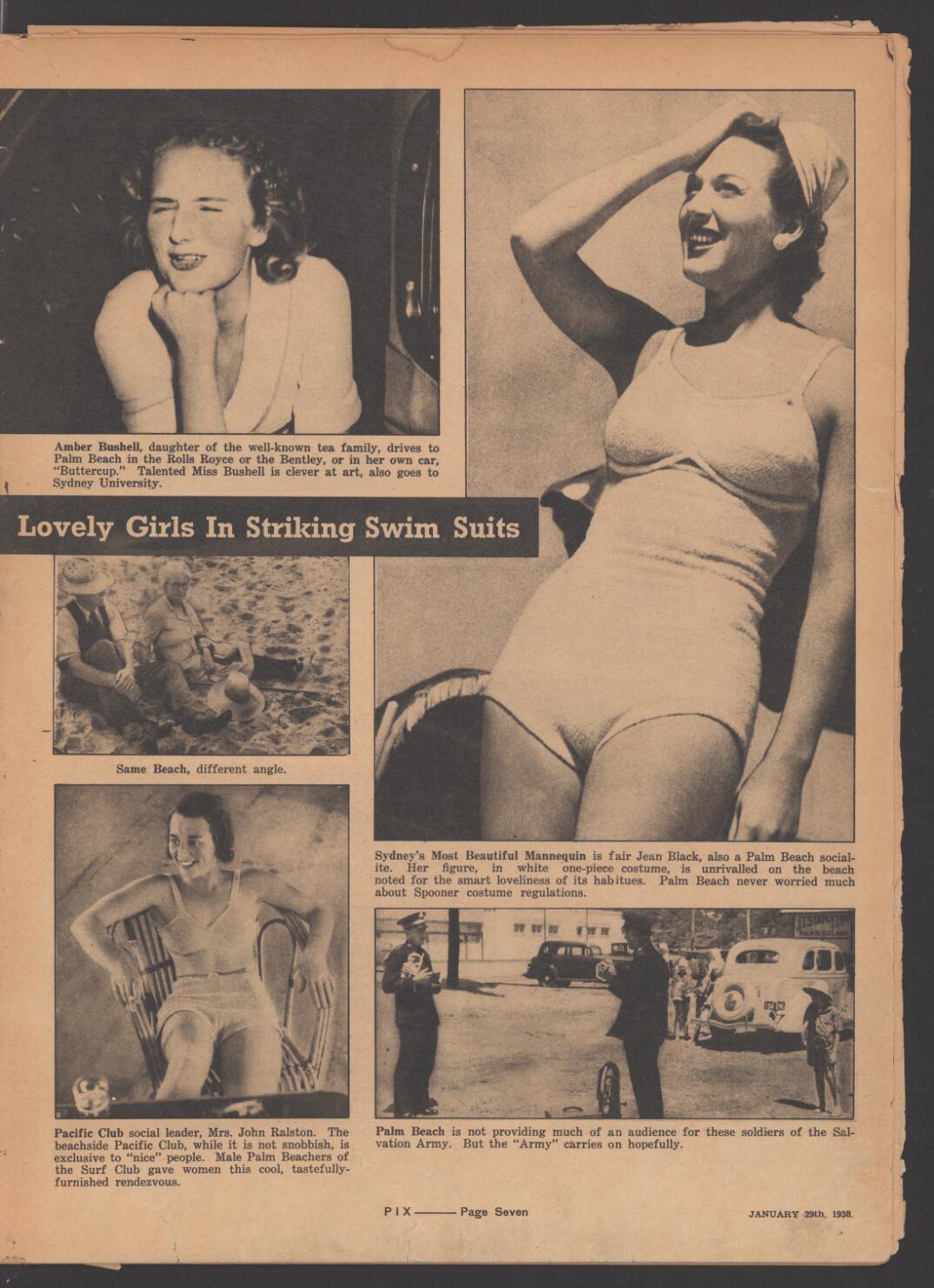
%20larger.jpg?timestamp=1706738732948)
A few more from that the Album 'Palm Beach, December 1 1937 and January 6 1938' and photographed by Ray Olson, more photos of Kalua and Hordern Park. These are Pix magazine photographs, and 'taken or published in 1937 and 1938', courtesy Mitchell Library, State Library of New South Wales and courtesy ACP Magazines Ltd.
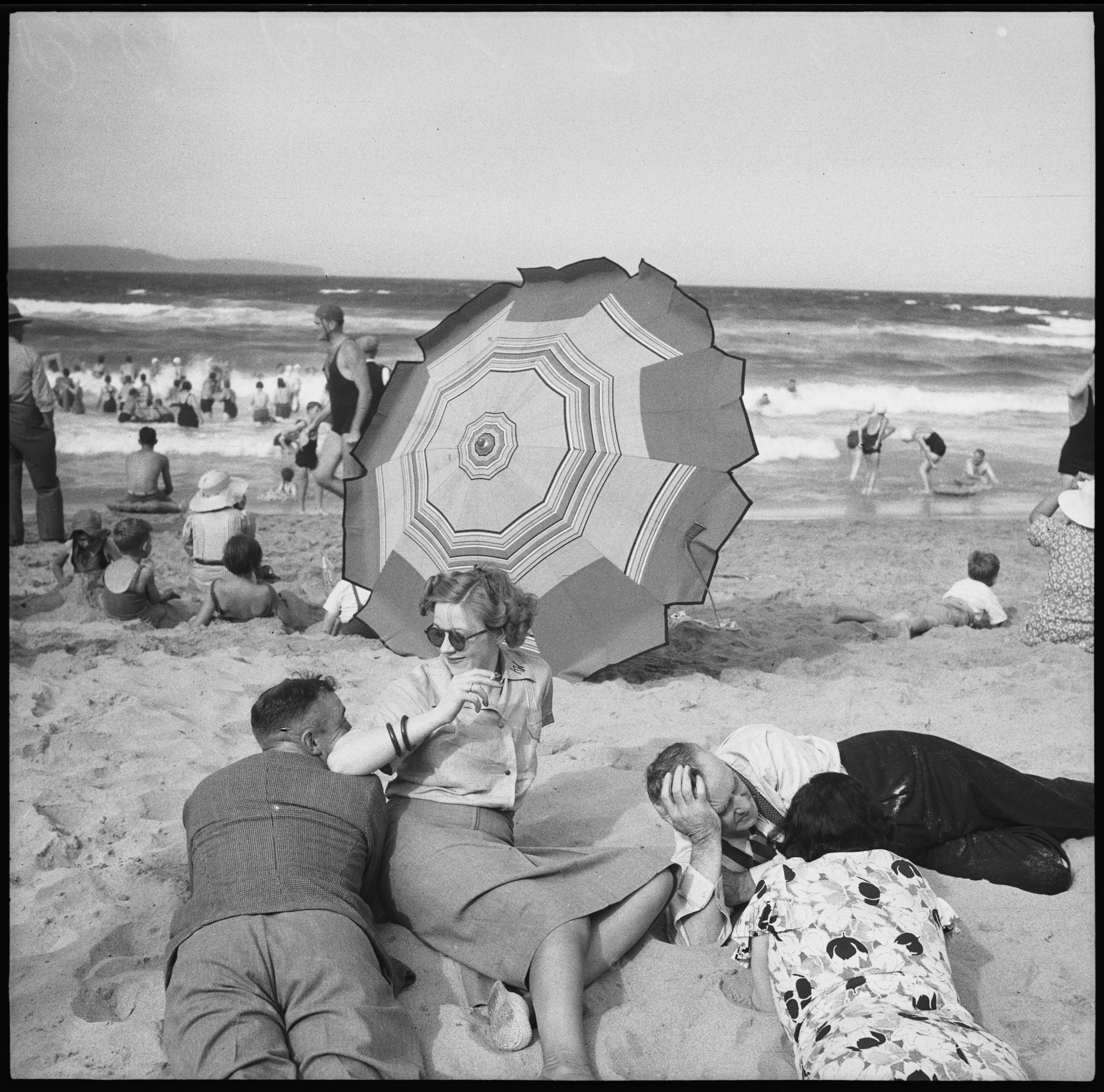
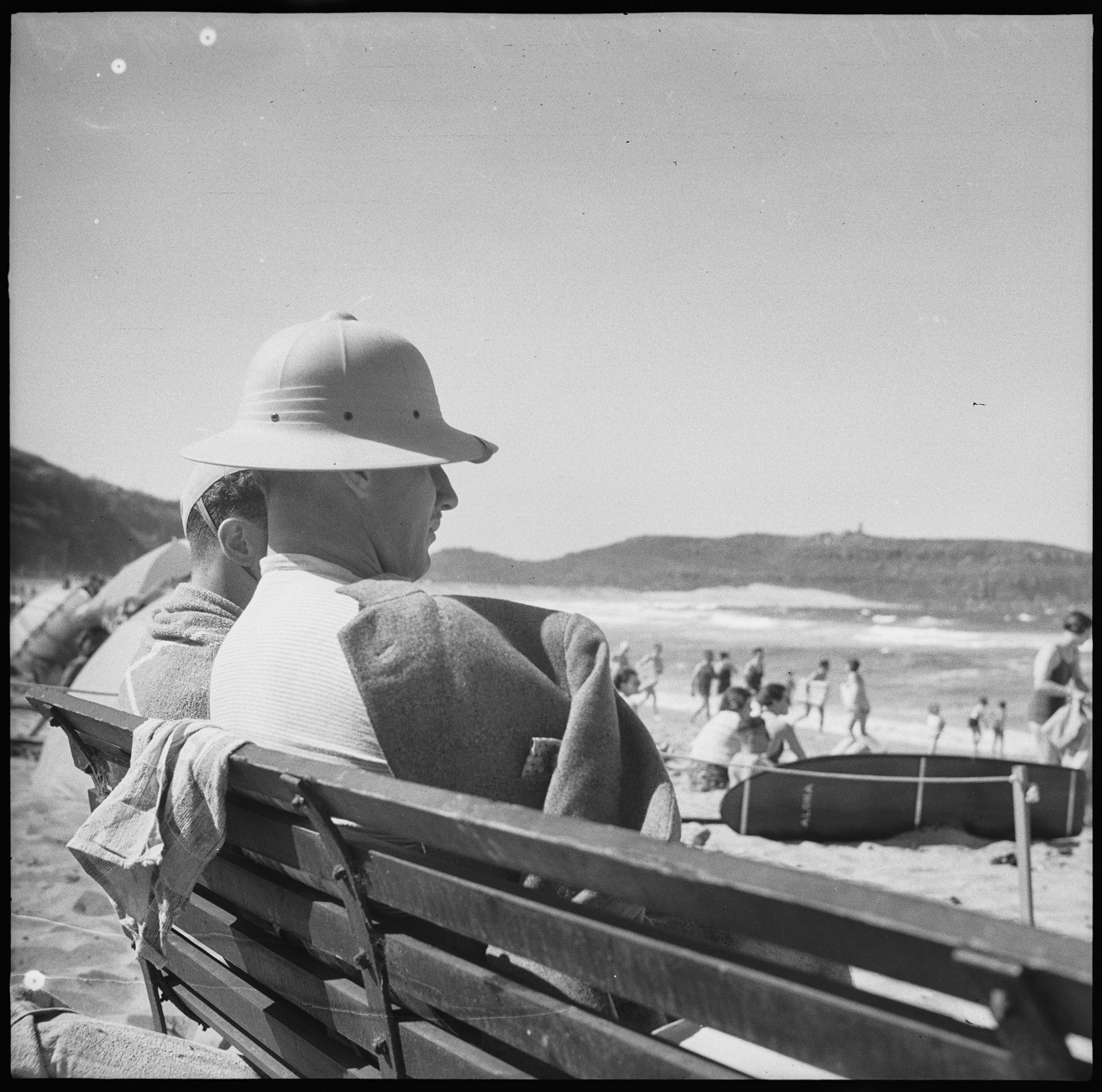
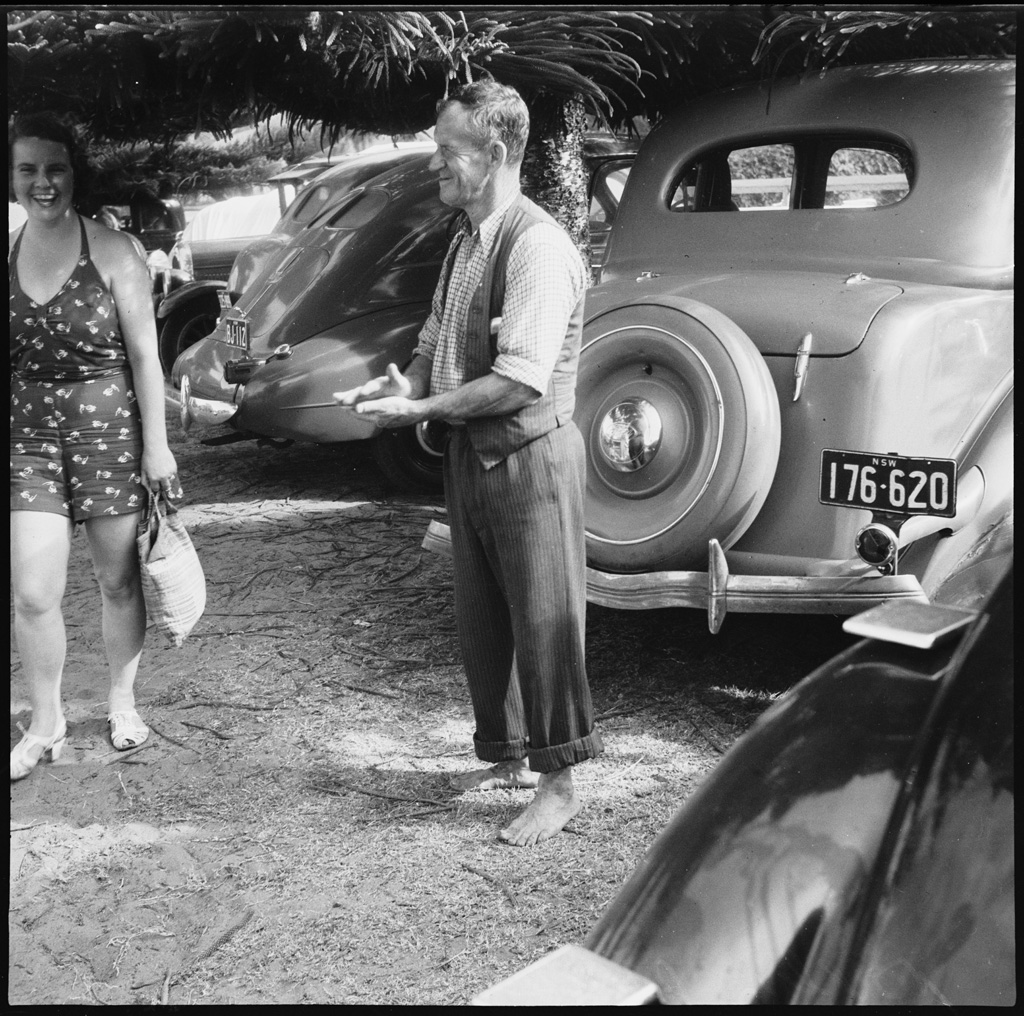
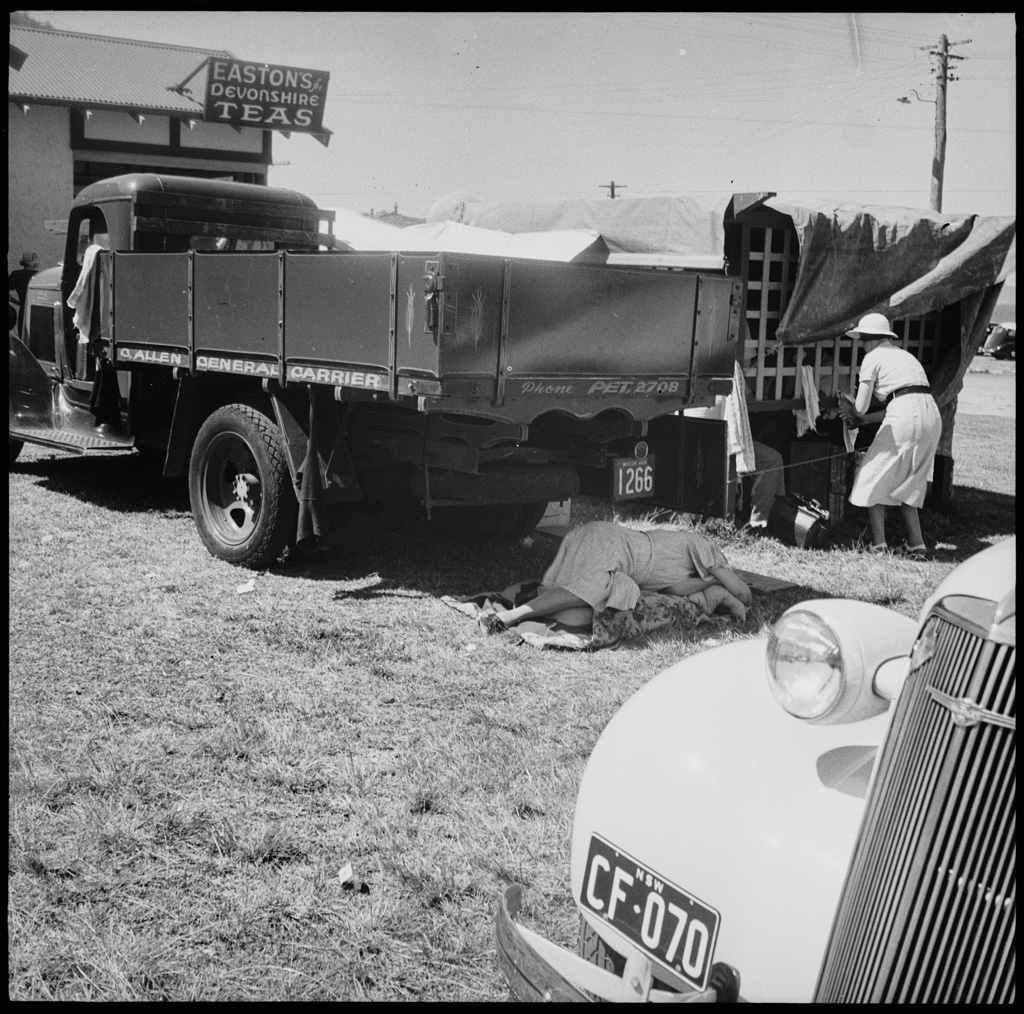
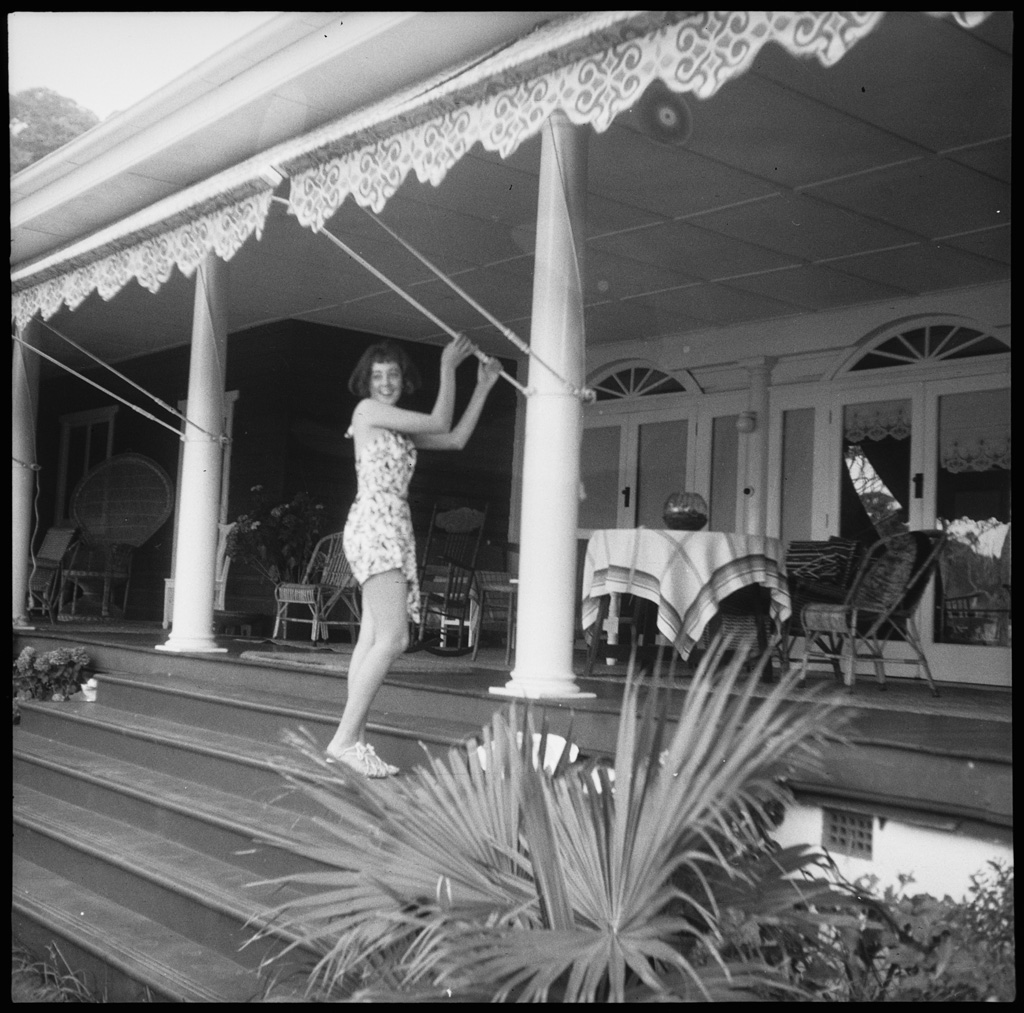
Something good to eat
Where the best milk is; who had the healthiest cows, while fathers shared where the most sheltered and affordable camping spot can be found, where the oysters were and when the fish or prawns will be running and hired out themselves and their boats to take them to these piscatorial grounds.
James Wheeler's sense of ownership of the lagoon and all in it surfaces shows up even before the first bridge across the Narrabeen lagoon had been built:
The case against Joseph Forester and George Sly for a breach of the Fisheries Act Amendment Act, 81 Vic, No. 10, section _, was resumed at the Water Police Court, yesterday, before Messrs. Marsh and Field. Water police constable Turner gave evidence corroborative of that of constable Skinner, and sketches of the lagoon wore produced. Mr. J. M. Curtis, for the defendants, took an objection that Narrabeen Lagoon, where the offence was alleged to have been committed, was not an estuary according to the real definition of the term; but the Board overruled the objection. The point had been decided in a previous case in the affirmative. Mr. Curtis also raised the question of title. Mr. Wheeler was the owner of the lagoon, and the defendants were employed by him, and had a perfect right to fish in the lagoon with any sized nets they chose to use. At this stage the case was again postponed for a week. NEWS OF THE DAY. (1880, December 10). The Sydney Morning Herald (NSW : 1842 - 1954), p. 5. Retrieved from http://nla.gov.au/nla.news-article13484199
The Fisheries Act referred to in the above item stems from:
THE FISHERIES BILL.
The following is the bill, brought in by Mr L. L. Smith and Mr Nicholson, for the purpose of amending the law for the protection of the fisheries of the colony of Victoria : —Whereas, it is expedient to amend the law for the protection of the fisheries in the waters of Victoria. Be it therefore enacted by the Queen's Most Excellent Majesty, by and with the advice and consent of the Legislative Council, and Legislative Assembly of Victoria, in this present Parliament assembled, and by the authority of the same, as follows, that is to say —I. An Act passed in the twenty-second year of her present Majesty’s reign, intituled 'An Act for the Protection of the Fisheries of Victoria,' shall be and is hereby repealed. II. That, for the purposes of this act, the year shall be equally divided into winter and summer months, whereof the winter months shall comprise the period extending from and inclusive of the first day of April to and inclusive of the thirtieth day of September, and the summer months shall comprise the period from and inclusive of the first day of October to and inclusive of the thirty-first day of March in every year. III. It shall not be lawful for any person, during the said winter months in any year, to use in any bay, estuary, or other inflexion of the sea, or in any river in Victoria, for the purpose of catching any fish therein, any net or nets the centre of which shall exceed ten fathoms in length, and the meshes in the bunt of which shall be less than one inch or whereof each wing shall exceed ten fathoms in length, and the meshes of which respectively shall be leas than one inch and a half inch, and the meshes of the remainder whereof shall be less than one inch and three-quarters of an inch; nor during the said Summer months in any year to use, for the purpose aforesaid, any net or nets the meshes in the bunt of which shall be less than one inch and three-quarters of an inch, and whereof the meshes in the remainder shall be less than two inches: and it shall not be lawful for any person, at any time, to fix or stake any net within one mile of the shore, or at the mouth of any river, and any person committing any such offence shall on conviction in a summary manner before any two justices of the peace forfeit and pay a penalty not exceeding five pounds; and such justices may order every such net or any portion thereof to be destroyed. IV. Every person using any net in any of the waters aforesaid for catching fish for the purpose of sale or barter, shall once in every year register his name, place of residence, and every place where he shall intend to keep any such net or nets, with the clerk of petty sessions which shall be holden nearest to the place at which such person shall so reside ; and for every such registration the fee of one shilling shall be paid to such clerk of petty sessions, who shall thereupon give such person a certificate in the form contained in the schedule hereto. V. If any person shall catch or attempt to catch any fish for sale or barter, as aforesaid, without having obtained such certificate, as herein provided, every such person being duly convicted thereof before any two justices, in a summary manner, shall forfeit and pay a penalty not exceeding £5.VI. And be it enacted that any person who shall feel aggrieved by any fine or penalty, where the fine, forfeiture, and costs shall exceed the sum of £5, may appeal against the same to the Court of Quarter Sessions, according to the provisions of the law which shall be in force for the time being, for the general regulation, of appeals of such or the like nature. VII. This Act shall commence I hereby certify that A. B. his this day registered with me his name, place of residence, and places where he intends to keep a net, for the purpose of catching fish within Victoria, as under, namely : Places where nets are. Name. Residence. to be kept. And further, that the said A. B. has also paid the sum of one shilling for such registration. Dated . 18 Clerk of Petty Sessions. THE FISHERIES BILL. (1862, May 5). The Age (Melbourne, Vic. : 1854 - 1954), p. 5. Retrieved from http://nla.gov.au/nla.news-article154847523
In New South Wales the protection of oysters against net and nets being dragged in their beds frames:
A BILL FOR THE REGULATION OF OYSTER FISHERIES.
Whereas it is expedient to promote the growth of oysters and the improvement of oyster fisheries Be it therefore enacted by the Queen's Most Excellent Majesty by and with the advice and consent of the Legislative Council and Legislative Assembly of New South Wales in Parliament assembled and by the authority of the e & me as follows : -
1. It shall be lawful for any person under a lease from the Governor which he may with the advice of the Executive Council grant for any term not exceeding years as shall be thought fit to form or lay down any artificial oyster bed or to improve any natural oyster bed on the shore adjacent to any Crown lands bordering on the sea or any estuary-and also for the owner or occupier of any lands bordering on the sea or any estuary under a like lease or for any other person with the consent in writing of such occupier and under a like lease-to improve form or lay down any such oyster bed on the shore adjacent to such lands And every such lease shall set forth the boundaries and limits of the oyster bed leased thereby and shall be in or to the effect of the schedule hereto.
2. Every person holding any such lease his executors administrators and assigns paying towards the Consolidated Revenue Fund such yearly rent for the same as the Governor with the like advice shall by such lease reserve shall hold the same as tenant for the term so granted and subject to this Act shall be entitled to use or sell all oysters the produce of such bed-but the holding of such bed shall not give any exclusive right or title to the occupation of the shore or sea ground except for the purposes of this Act nor interrupt the free exercise and enjoyment of any other light possessed by any other person in or along such shore or sea ground.
3. Every person who shall wilfully interfere with or remove oysters from oyster beds so under lease without the consent of the lessee shall be liable to a penalty not exceeding fifty pounds and shall in addition thereto pay to the lessee such sum not exceeding fifty pounds as shall appear to the convicting Justices a reasonable compensation for any injury done.
4. Every person except the lessee or some person acting under his written authority who shall within the limits assigned by any such lease by any means take or catch any oysters or oyster brood or dredge for oysters or oyster brood or use any oyster dredge or any net instrument or engine for the purpose of taking or catching oysters or oyster brood although nonesuch shall be actually taken-or with any net instrument or engine drag upon the ground or soil of any oyster bed so under lease shall be liable to a penalty not exceeding ---pounds.
6. Every person who shall during the months of January October November or December in any year sell or offer for sale any oysters shall be liable for every such offence to a penalty not exceeding ------- pounds.
All penalties under this Act may be recovered in a summary manner before any two Justices and all sums by way of compensation there under may be recovered and payment thereof may be enforced in like manner as any such penalty.
7. One half part of every penalty imposed under this Act shall be paid to the informant unless compensation shall have been awarded to him under this Act and the other half part or the whole as the case may be shall be paid into the Consolidated Revenue Fund.
8. Every conviction or order against any person under this Act shall be a full release to him from any other proceeding civil or criminal for the same cause' and may be pleaded in bar of such proceeding.
9. Every person convicted of a second or subsequent offence against this Act shall be liable at the discretion of the convicting Justices and on their order to forfeit any lease or permission granted under this Act and shall thereupon become incapable of holding any like lease or permission for five years.
10. This Act shall be styled and maybe cited as the “Oyster Fisheries Act of 1862." A BILL FOR THE REGULATION OF OYSTER FISHERIES. (1862, May 30). The Sydney Morning Herald (NSW : 1842 - 1954), p. 2. Retrieved from http://nla.gov.au/nla.news-article13229398
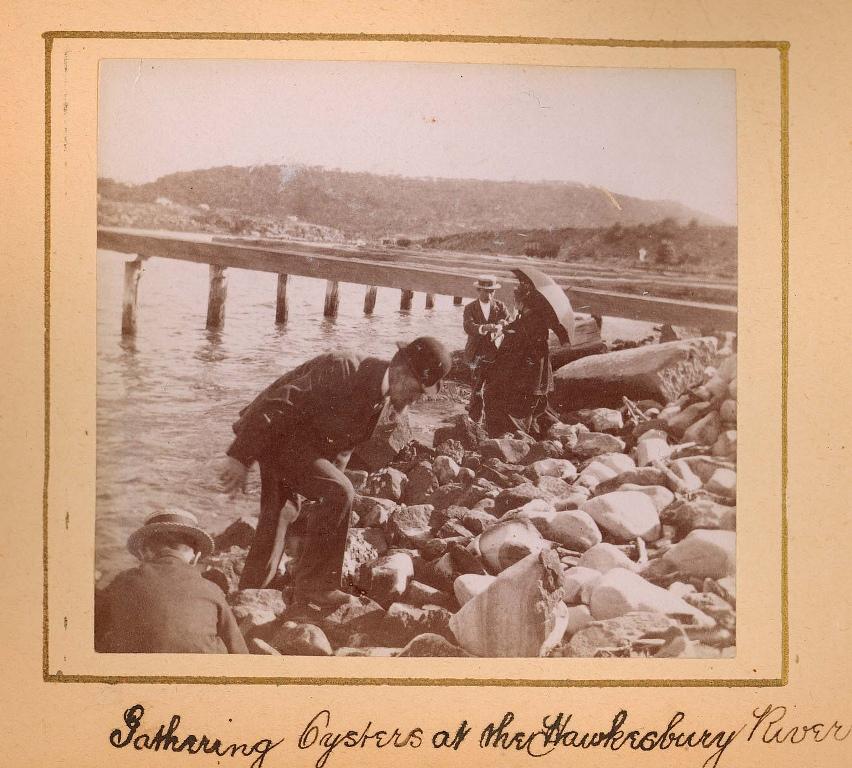
This image is from a leather photograph album dating to the late 1800s (circa 1880). The album contains sepia prints of a voyage from Melbourne to Sydney on SS ARAMAC as well as various sights around Sydney Harbour and the Hawkesbury River. The provenance of the album and the identity of the photographer is unknown. - from the collection of and courtesy of the Australian National Maritime Museum: Object number 00036455_25
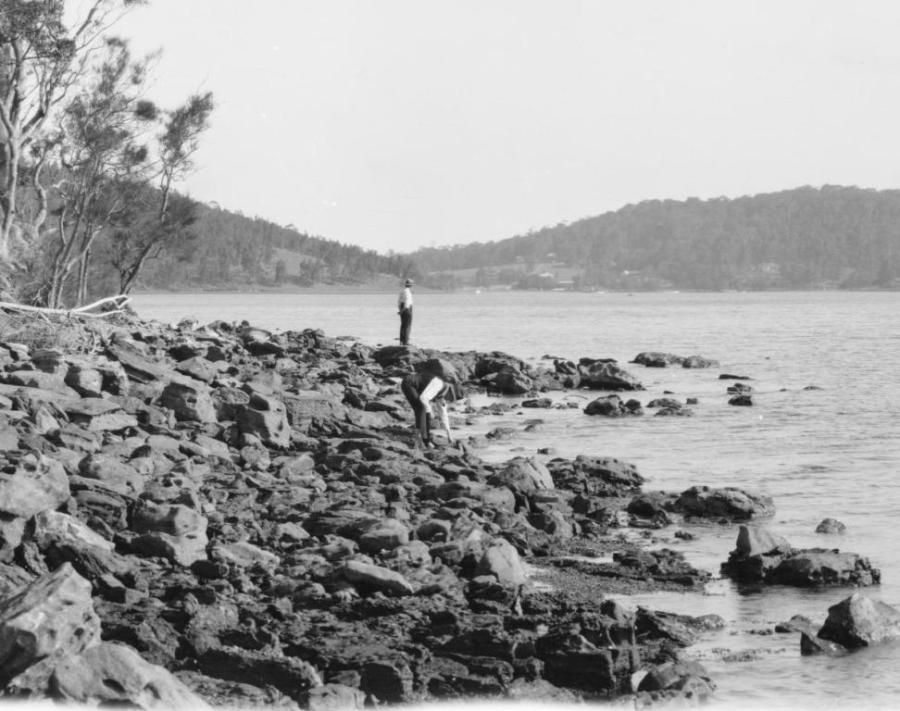
Section from: Panorama of Taylors Point with real estate sign advertising upcoming land subdivision, Pittwater, New South Wales [picture] circa 1921, image no: nla.pic-vn6149436, courtesy National Library of Australia
There is also some indication in this December 1880 mention of ongoing disputes between George Sly and James Wheeler that people were beginning to realise that the lagoon can, with so many fishing with large nets, be reduced of fish as a resource for catching and move past a point of recovery for fish abundance in future seasons too. Lagoons, the nurseries of so many aquatic crustaceans, molluscs and fish, are vital for all they are connected to.
The shift towards commercialisation also meant the beds were placed off limits to people who lived here or who may have holidayed in the area or came here as excursionists to fish and 'oyster', as shown in many of the old articles we've run on steamers visiting the area where the mention of 'parties fishing successfully' frequently appears. At Narrabeen the resource had been reduced so much bans were put in place and renewed annually:
Oysters. — For the term of one year from the date hereof the natural oyster beds in the Narrabeen Lagoon, county of Cumberland, are closed. Government Gazette. (1879, May 24). The Sydney Mail and New South Wales Advertiser (NSW : 1871 - 1912), p. 817. Retrieved from http://nla.gov.au/nla.news-article162808811
OYSTER BEDS.— By proclamation the natural, oyster beds within the Narrabeen Lagoon, county of Cumberland, are closed for the term of one year. Government Gazette. (1880, May 26). Evening News (Sydney, NSW : 1869 - 1931), p. 3. Retrieved from http://nla.gov.au/nla.news-article108733312
Prawning at Narrabeen Lagoon, particularly when the mouth of the lagoon is opened to the sea, has taken place across over a hundred years and several generations of locals and visitors:
A Valuable Prawn Fishery.-Mr. H. Fanning, one of the members of the Fisheries Board, sought yesterday to induce the board to re-open Narrabeen Lake to prawning during the summer. He submitted a statement by letter to the effect that the value of the prawns netted in the lake during 1907 was £565, and he gave the names of those who had participated in the hauls. But Mr. Fanning received a shock when the secretary of the department, Mr. J. A. Brodie, pointed out that two of the names given as amongst the principal sharers in the wealth of the lake were not the holders of Fishing licenses during 1907. Mr. Fanning subsided, and the board decided to secure further information, possibly with a view to the prosecution or those who had netted without a license. The lake last year yielded a moderate quantity of prawns to amateur parties, who used small hand scoop-nets to secure the crustaceans, but towards the close of the summer hardly a prawn could be caught, and It was the opinion of many who live near the lake or who visit it for week-ends that the supply had been greatly reduced. INTERSTATE PRODUCE TRADE. (1909, August 24). The Sydney Morning Herald (NSW : 1842 - 1954), p. 6. Retrieved from http://nla.gov.au/nla.news-article15093684
Remarkable Scene. When the waters of the Narrabeen Lake were opened to the sea on Sunday by volunteer workers and the men of the local shire council, some remarkable scenes were witnessed. There was an immense volume of water in the lake, and when the channel was cut with shovels the outrush of water tore a wider channel along which thousands of fish were hurried to the sea. Many mullet about 18 inches long leaped high out of the water as they neared the spray of the waves of the ocean beach, their object being to avoid the attacks of huge tailer, which were waiting for them outside the bar. The tailer came right up into the wave roll to take the fish from the lake, and snapped viciously at their prey. Men rushed into the current and threw hundreds of fish out on to the sand with prawn nets and their hands. One sportsman grabbed a mullet at the same time as a tailor, and each got half the fish. Another man had a tailer seize his coat, and he emerged from the channel with the fish hanging to it Whiting proved the most elusive fish to catch, but the mullet wore bewildered, and were easily secured with the hand by hundreds of people on the lake beach and in the channel entrance. MINES AND RAILWAYS. (1910, March 15). The Sydney Morning Herald (NSW : 1842 - 1954), p. 6. Retrieved fromhttp://nla.gov.au/nla.news-article15153991
Prawners at Narrabeen have made an early start at the sport, which is usually only engaged in during the summer. The crustaceans made their appearance a week or two ago, and people were soon out for them at night with fine meshed scoop nets and lamps. The lake is now cut off from the sea by the usual sand bar, but a good body of water is showing. A shark was harpooned near the bridge a couple of weeks ago. This is the first record of a shark in the lake. ANGLING. (1911, October 4). The Sydney Morning Herald (NSW : 1842 - 1954), p. 9. Retrieved from http://nla.gov.au/nla.news-article15279201
To have access to a feast table – not just the fishing but a place of open fields outside the bush areas where visitors could purchase farm gate milk, have bread and meat delivered via horse and cart or boat - was part and parcel of what made Summer in Pittwater a healthy place to be.
In the 1920’s these smaller farmlets offered through the office of Sunter and MacKenzie, with offices at the Tram Terminus, Narrabeen, lends us an insight into what these by then established small acreages were growing and offering:

FARMS AT NARRABEEN FOR SALE (1923, June 12). Goulburn Evening Penny Post (NSW : 1881 - 1940), p. 4 (EVENING). Retrieved from http://nla.gov.au/nla.news-article102875519
As these local farmers thrived and produced the most sumptuous fruits and vegetables in Sydney the Summer vsiitors, and being allowed to sell to the same in camping areas - with the council providing the permission - added a boon to their annual income.
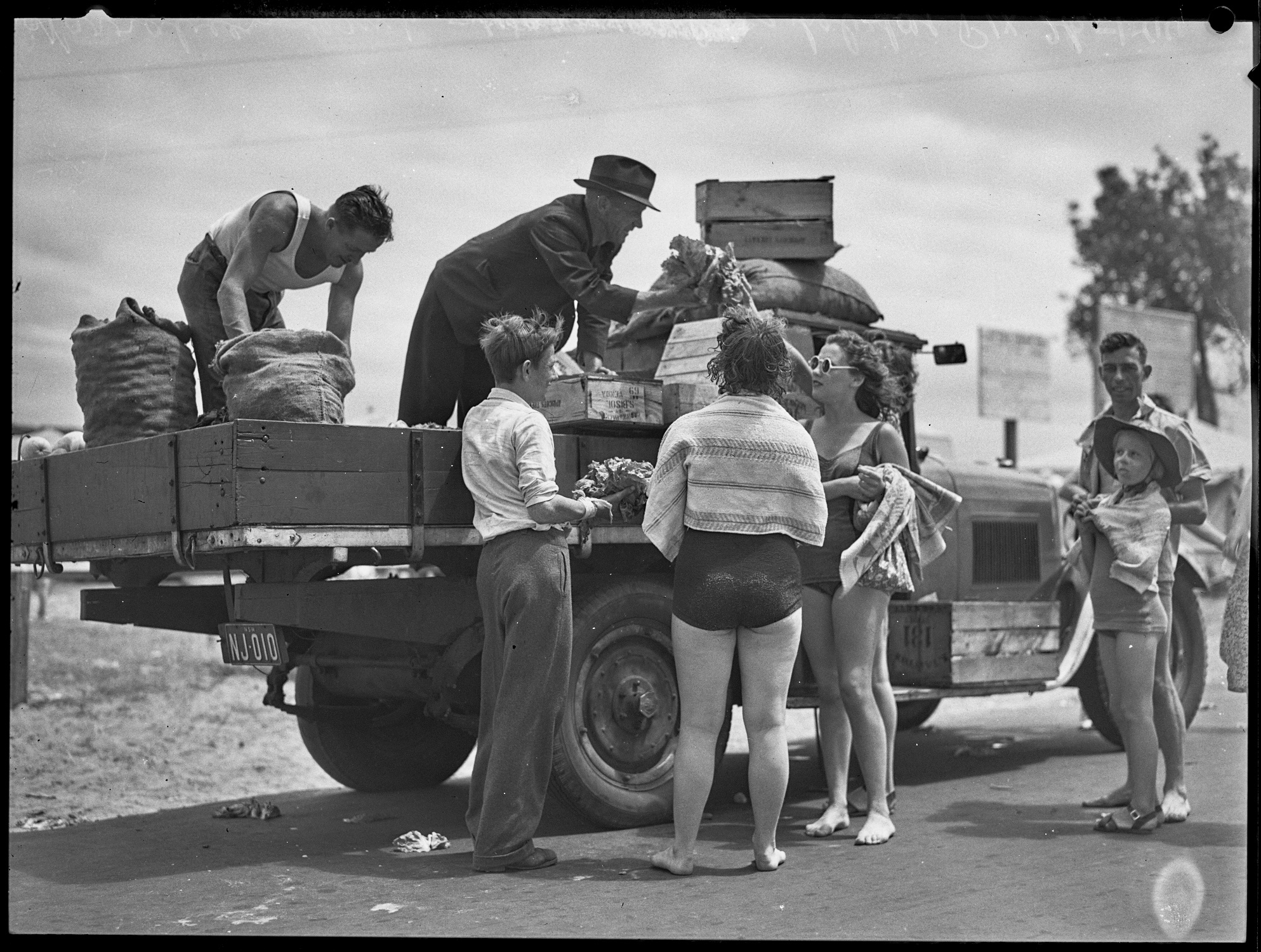
Narrabeen Farm Produce off back of local truck at North Narrabeen Lake Park camping area in January 1945. Item: SLNSW_FL9550118, courtesy State Library of NSW
Ways to Play
Sailing, along with fishing, was, of course, what first brought people to Pittwater to play during the Summer months. This was also a year-round playtime but during Summer the raft-up of yachts and the eventual commencement of Pittwater Regattas, still being run annually during the Summer by the Royal Prince Alfred Yacht Club, was among the first ongoing recreational activities associated with the Barrenjoey Peninsula.
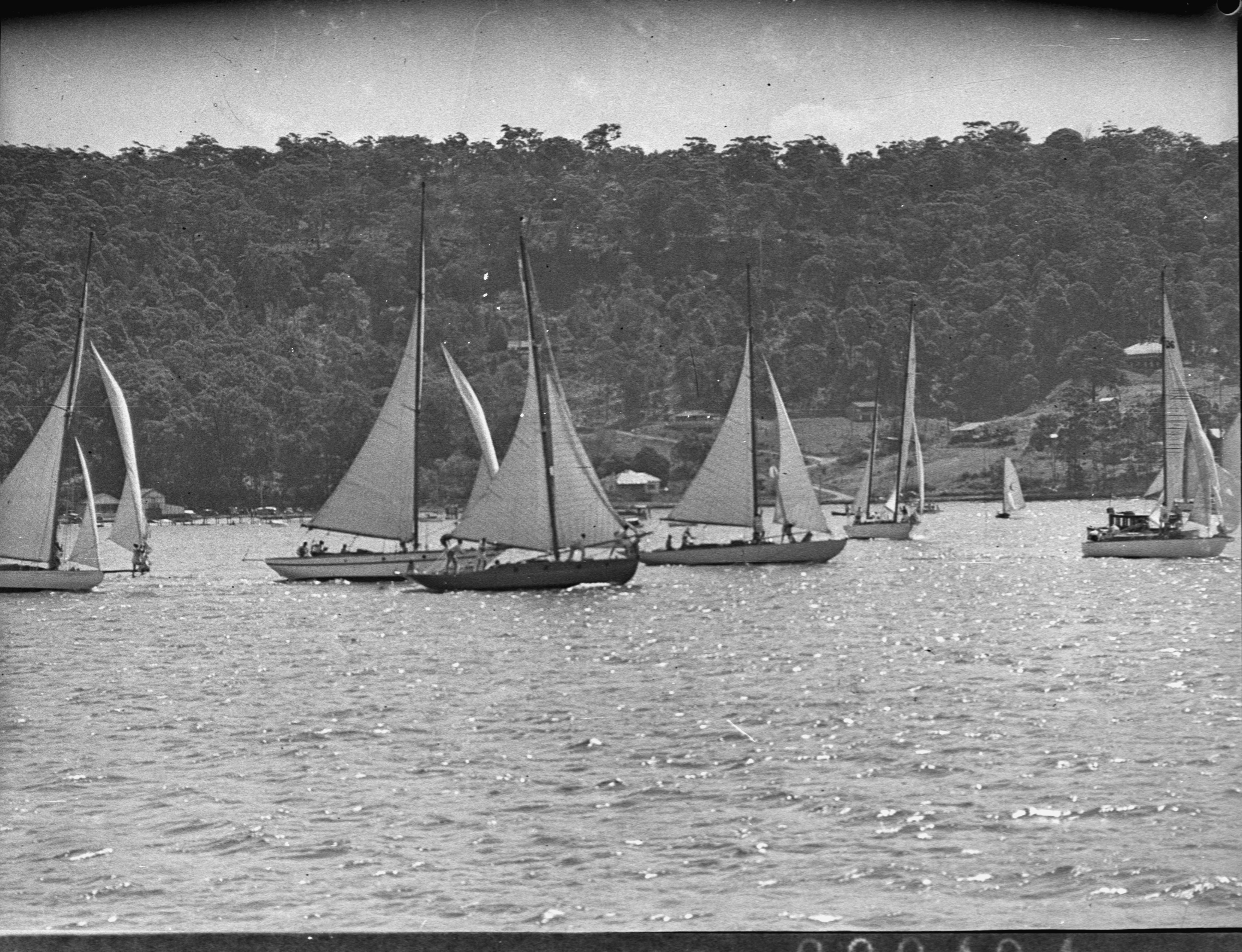
Pittwater Regatta, 1933-1937 pics courtesy of State Library of NSW, Hood pics.
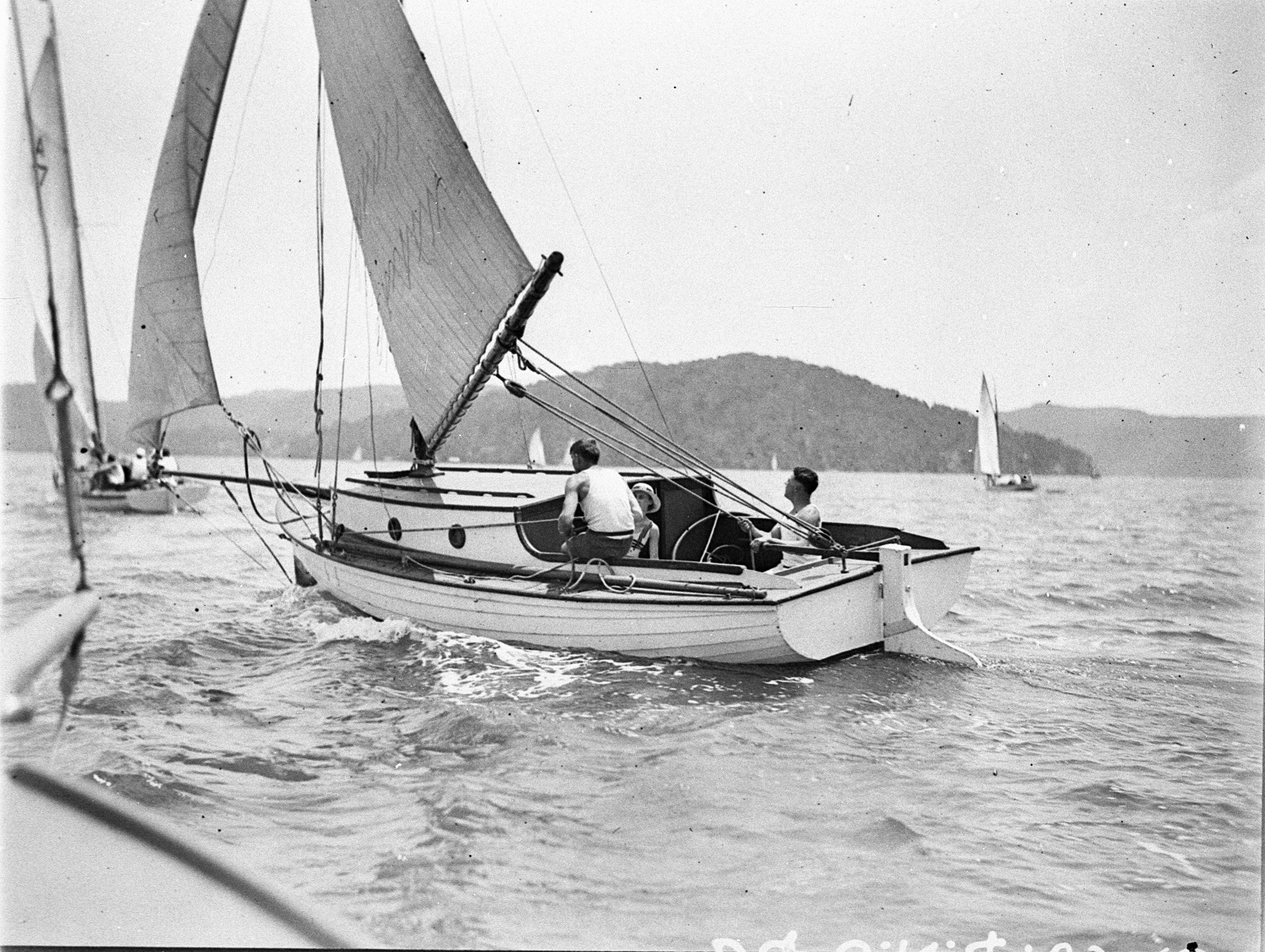
Even though European colonists bathed in saltwater as a means to keep clean from the outset of settlers living here, it wasn't until formalised permission to swim for fun, first at Manly, and then everywhere, and prescribed neck to knee bathing suits to maintain a veneer of proprietary, that the boon of water sports, and the cooling dip in the ocean among refreshing sea breezes only experienced on the coast, established over 120 years ago what all take for granted today.
The air is free, the waters open to all too.
Manly Council was among the first to protect surf bathers, employing two fishermen, the Sly brothers, to patrol offshore in one of the first versions of a surfboat, and, in 1905, employed a lifeguard, Edward ‘Happy’ Eyre.
One of Palm Beach SLSC’s founding members Adrian Curlewis, the ‘father of surf lifesaving in Australia’ and President of SLSA from 1934 to 1975, (with the exception of four years’ service during WWII as a POW) gave all the idea of ‘swim between the flags’ at a patrolled beach, (if we can’t see you we can’t save you) while the club itself, during this same 1930’s era, championed using surfboards as lifesaving equipment. These boards are now a feature of every patrol Season on every Australian beach.
This had been preceded in the 1923/4 Season with Patrol signs developed. Blue and white = safe. Red flags = danger.
The 1920's New Years Eve parties held by the Royal Motor Yacht Club were synonymous with living an aquatic life during Summer. The same parties, hosted by Palm Beach SLSC during the 1930's, were major fundraisers for this surf club. Organised by early lady surfer Alrema Samuels (nee Becke), whose father, the popular early Australian adventure writer Louis Becke would have witnessed surfing at Fiji during his sojourns between the Pacific Islands, New Zealand and Australia in the 1880’s, these additions to the Pittwater Summer calendar, although used by some news outlets to cast aspersions on Palm Beach visitors, or undermine what these volunteers were doing, in giving up their Summers to keep others safe, simply brought more visitors to Palm Beach to try and see these people and their antics taking place.
Many of these were held in the Palladium at Palm Beach. Palladium interiors for this 1938 End of Summer dance from 'Palm Beach, 6 January 1938' photographed by Ray Olson, courtesy Mitchell Library, State Library of New South Wales and Courtesy ACP Magazines Ltd. that ran and didn't run in that Issue of the PIX Magazine:
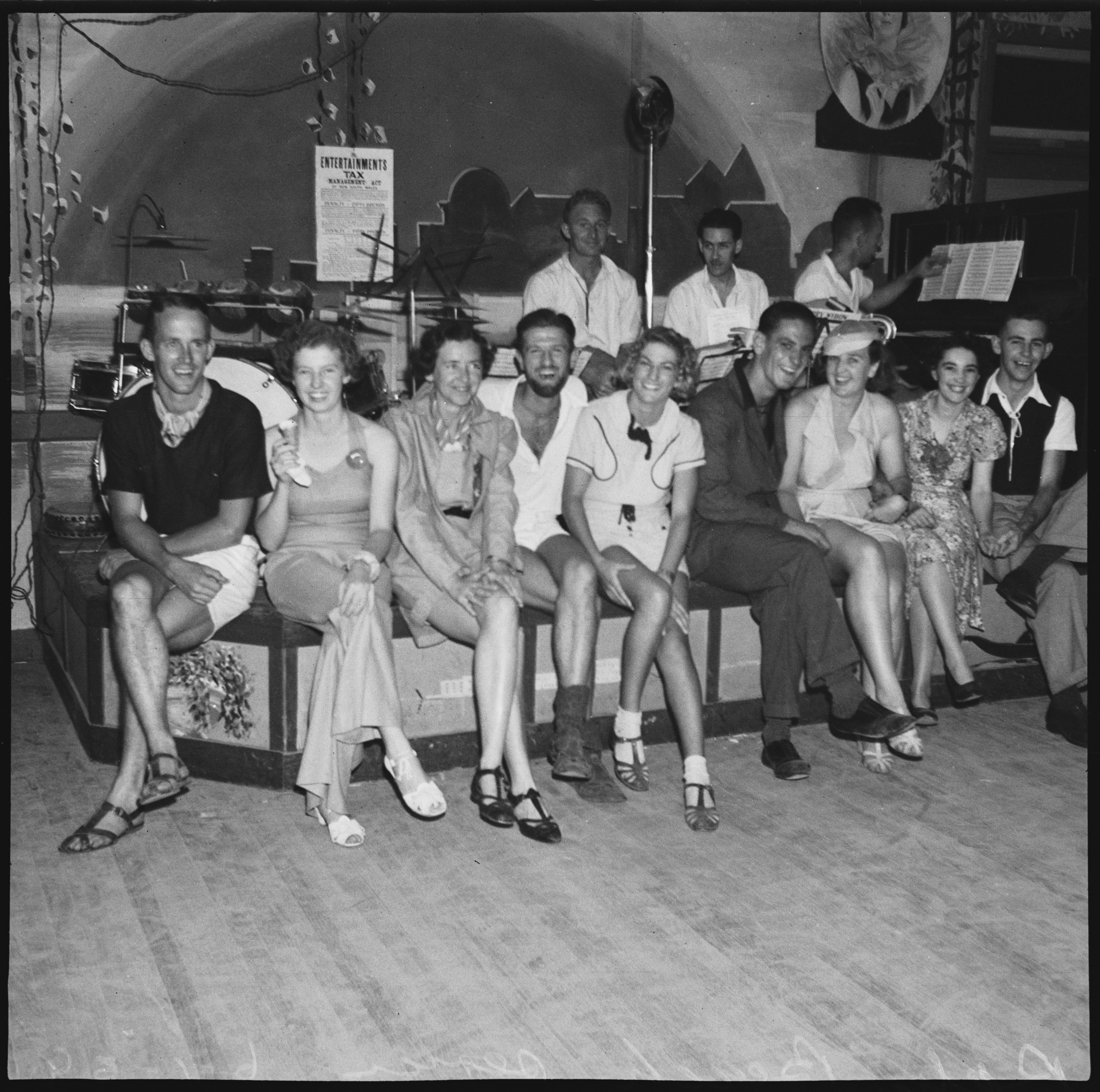
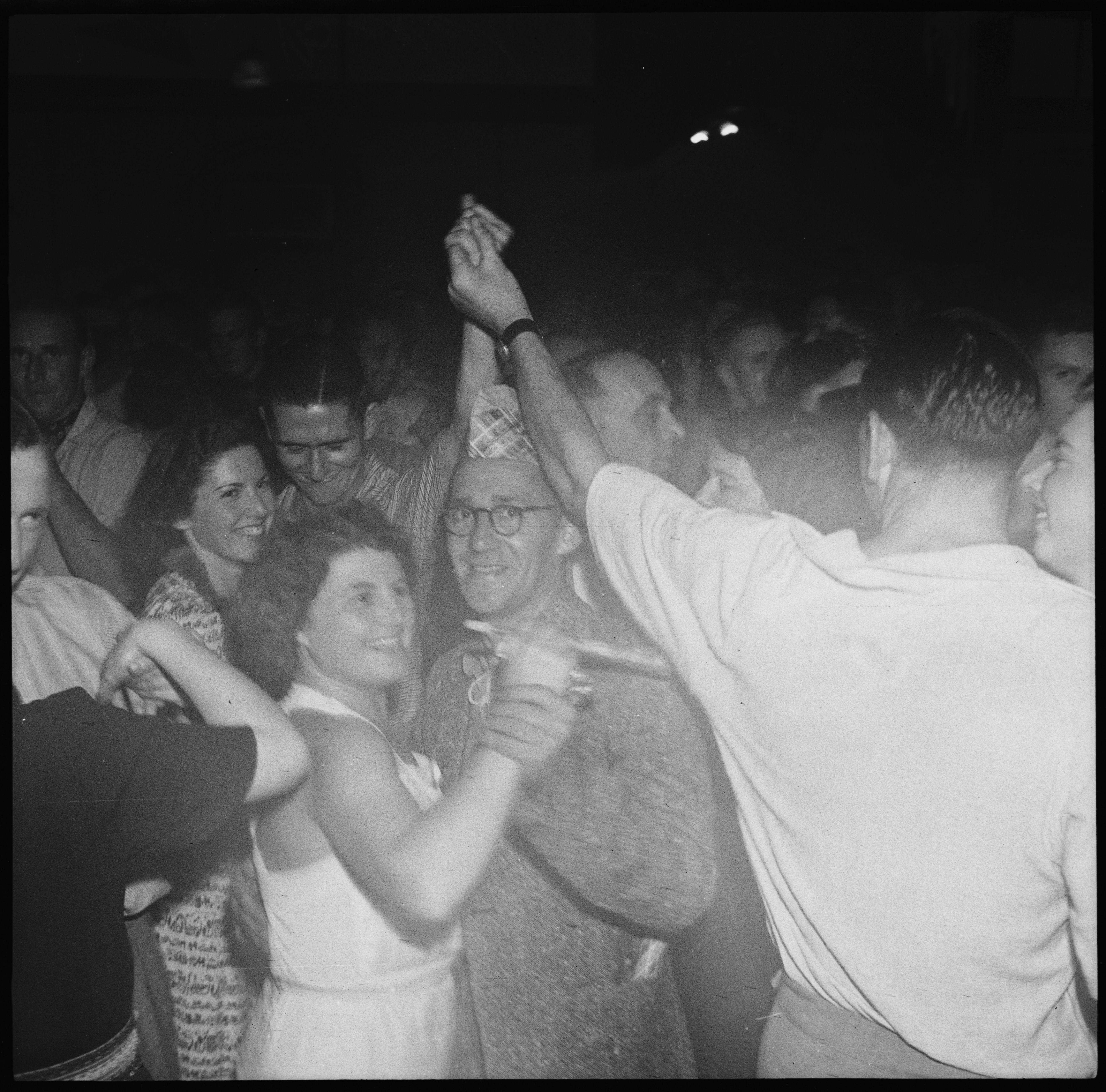
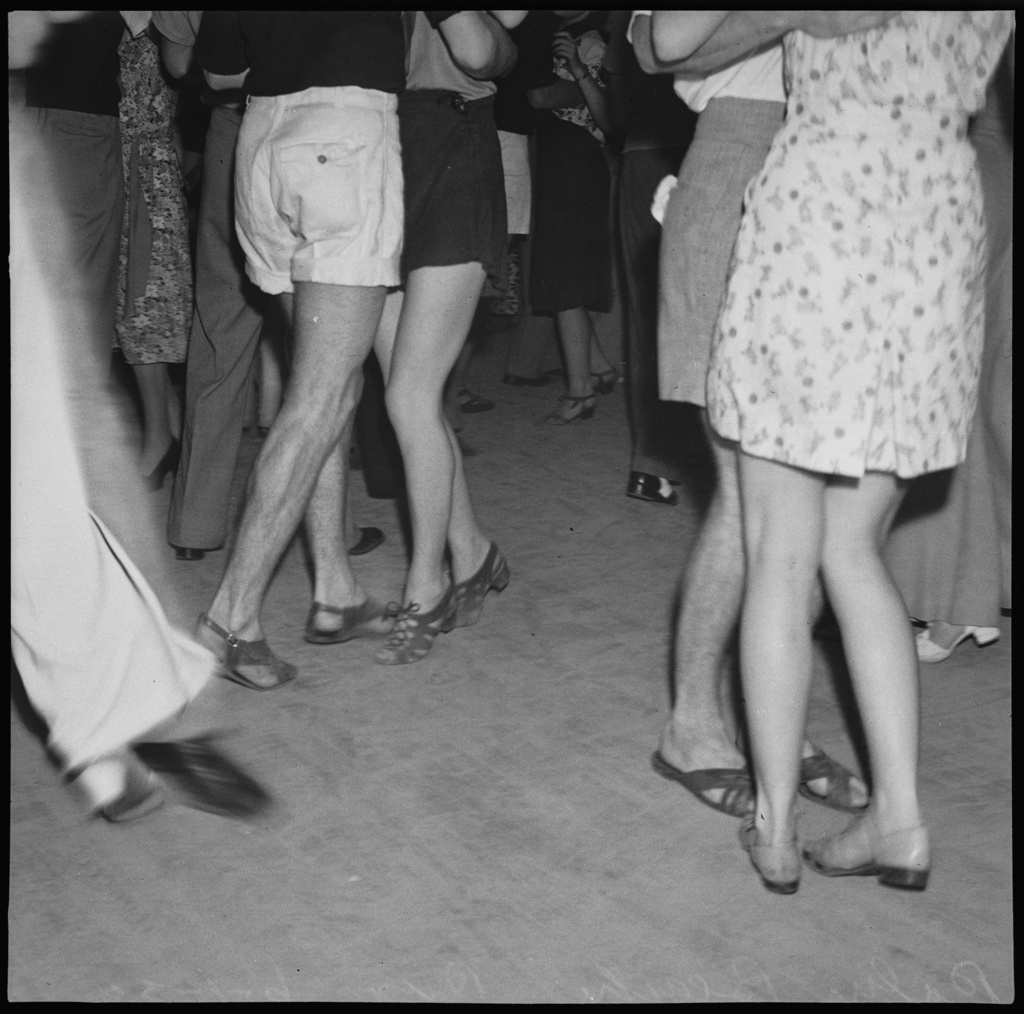
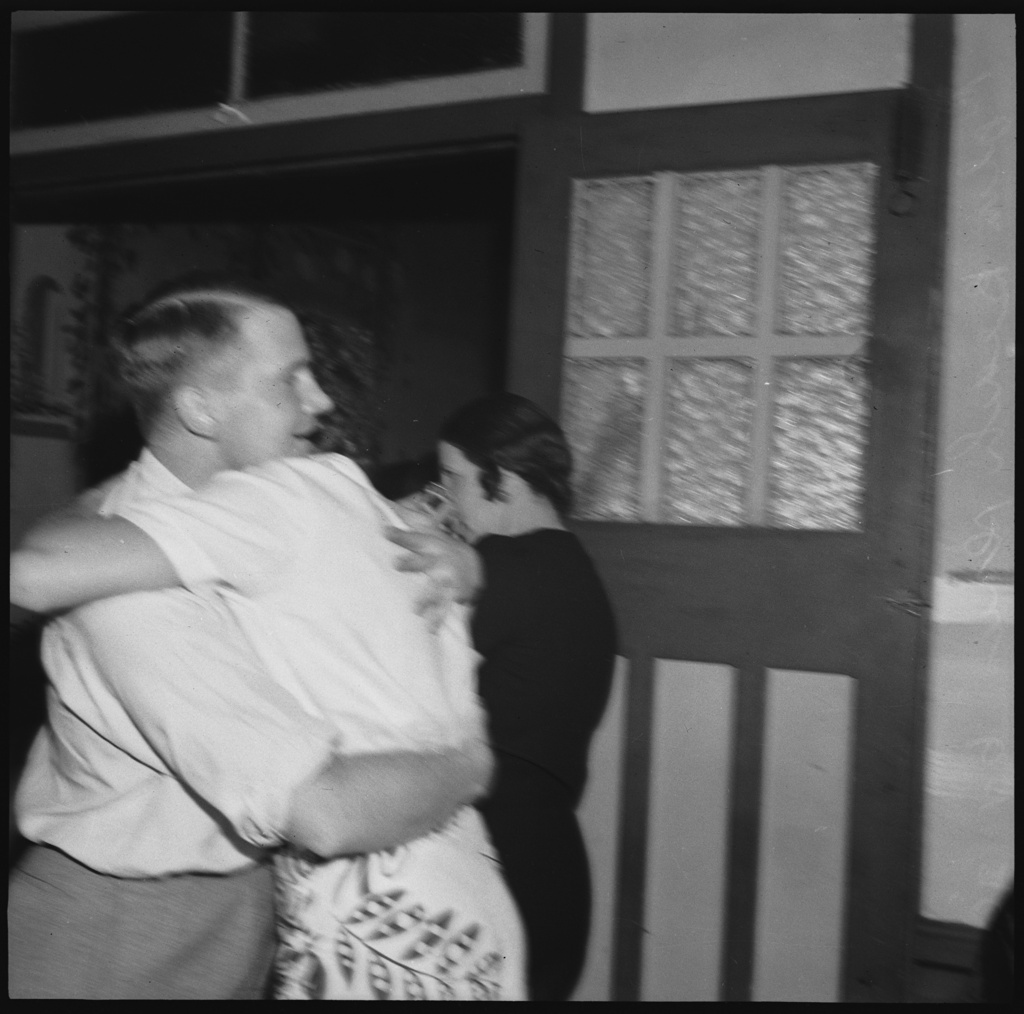
This 1930’s evolvement of the 1920’s ‘watching society’ aspect to local newspapers, with some of these ‘weekenders’ ‘society’ filled at Palm Beach, Careel Bay, Clareville, Newport, Mona Vale and Elanora Heights marking the previously all-bush terrain with large villas, and contrasting sharply with those who had been made homeless and were camping, in some cases, at sites from Palm Beach to Scotland Island, Clareville and Manly where they could at least put a canvas roof over the head of loved family members and catch fish with which to feed them and join the work gangs building pools and roads locally.
Australia's fascination with flying, which commenced at North Narrabeen with George Taylor making the first official flight, became a means to make a show of these during the Pittwater Regattas of the 1930's and offer joy flights on the Narrabeen lagoon itself during a drought period, and even being able to do this at Palm Beach.
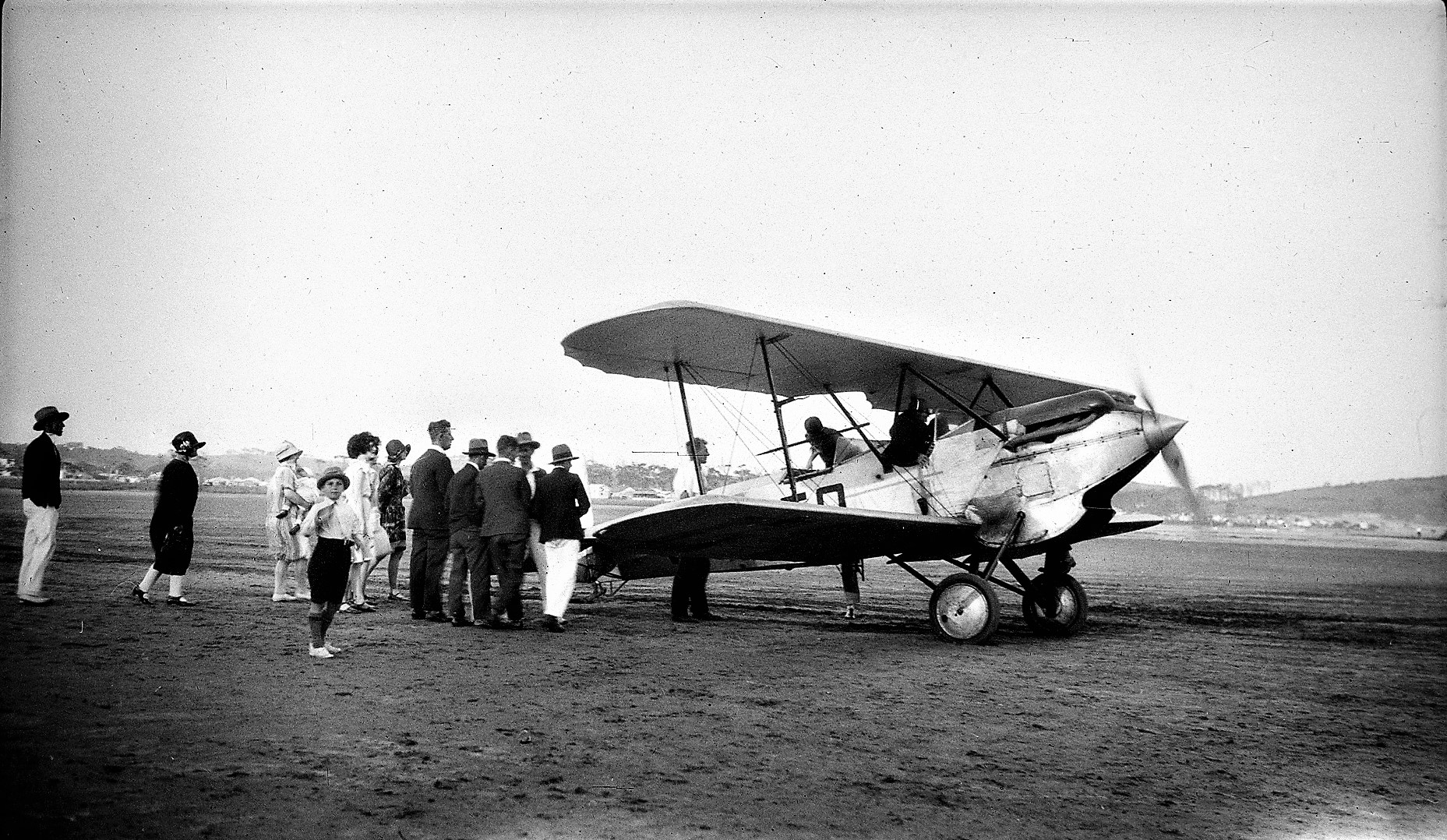
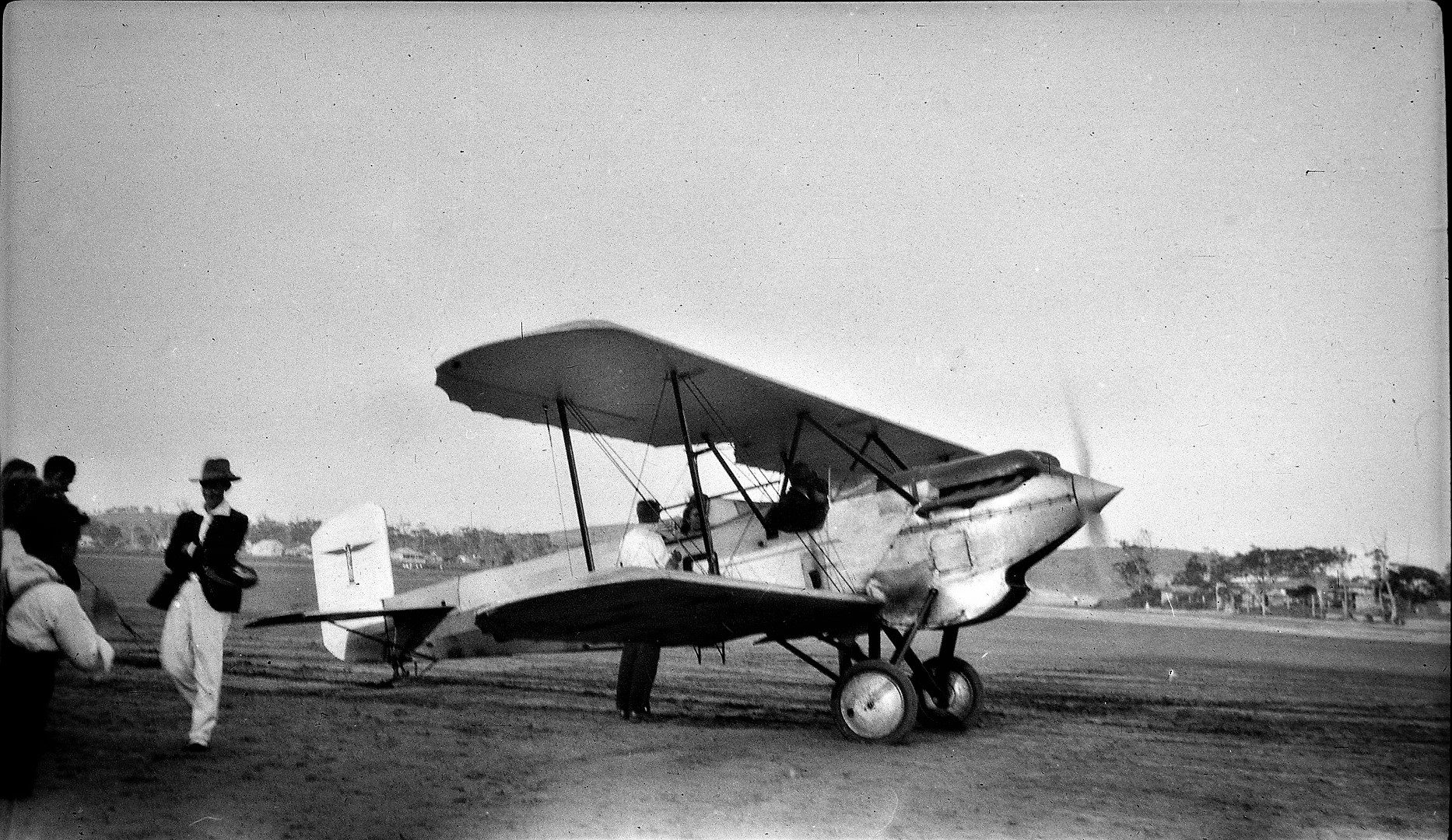
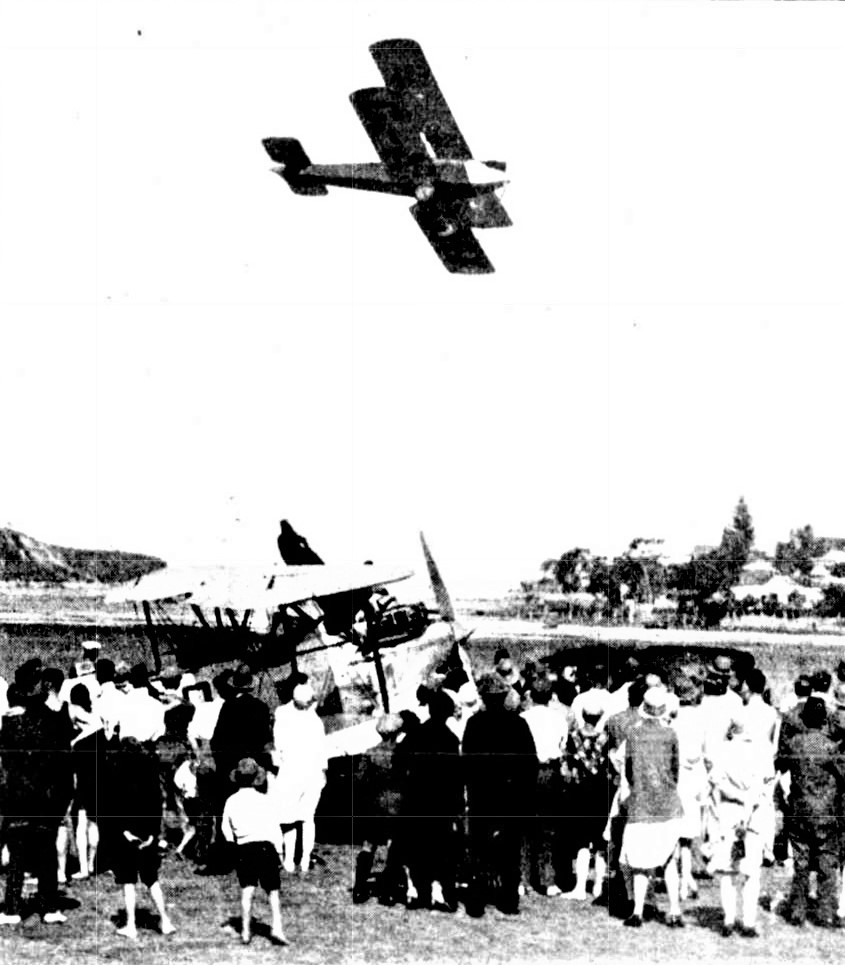
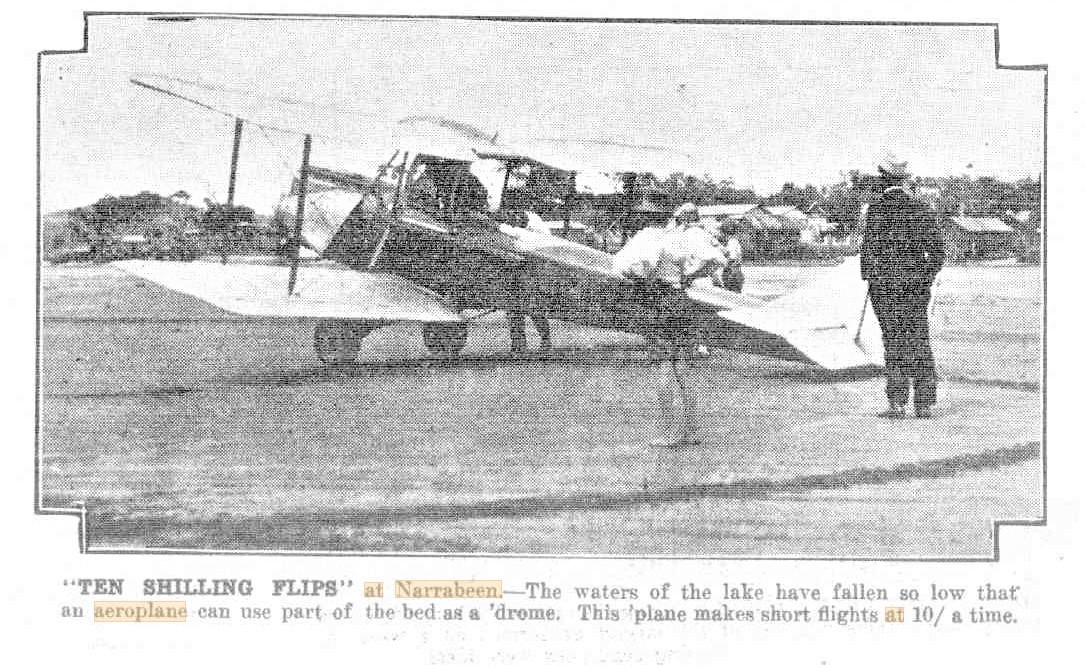
Here too the first surf lifesaving carnivals took place, showcasing the skills and knowledge through a series of events that demonstrated how people who consider themselves quite ordinary rose to do acts that were extraordinary, and saved lives. Imagine learning, like an Olympic athlete, how to swim or paddle so you can negotiate the channels and rips to quickly reach a person drowning, or learn the knowledge and skill of how to, like a nurse or a doctor, resuscitate someone who has had a heart attack or stopped breathing because their lungs are full of water.
These carnivals became and remain features of the surf lifesaving ‘Season’ when volunteers are on patrol on our beaches; these too raised funds to buy the equipment and pay for the first aid courses that would save more lives, and have been doing so until this present day, over 120 years on.
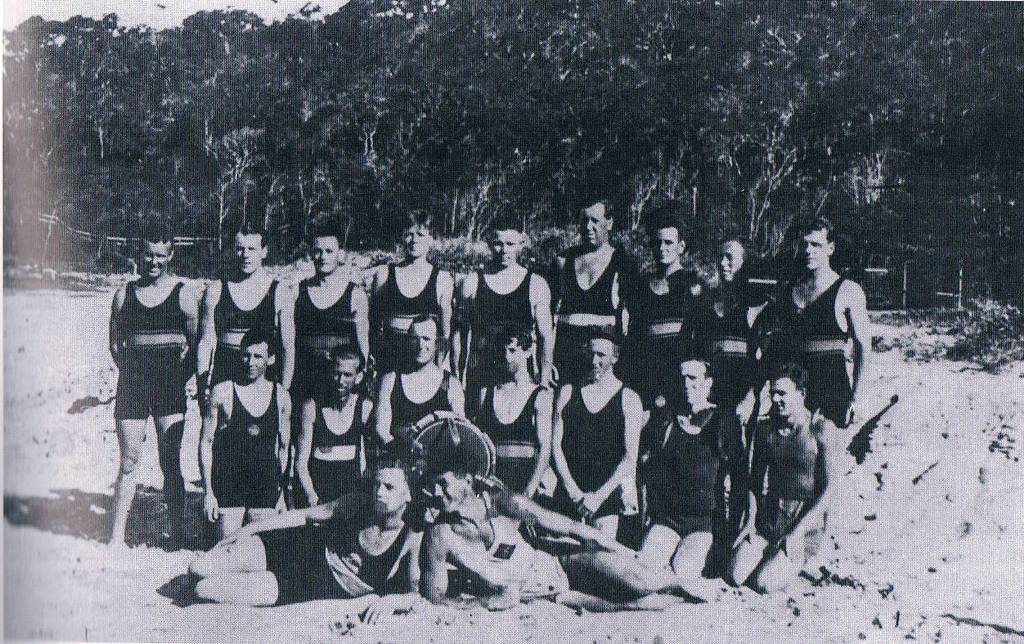
First PBSLSC Bronze examinations and Members squad, 1922. Standing (l to r) Adrian Curlewis, A. Oatley, A. Hopkins, Walter Rayner, C. Larsen, Eric Ayres, p. M. Shaw, Geoffrey Oatley. At Front: F. Larkin, Harry Ayres, Keith Oatley, B. Ellis, C. Sheedy, Laurie Gallagher, Harry Amplett. Front: Len Palmer and Austin Dellit. Photo: Curlewis family.
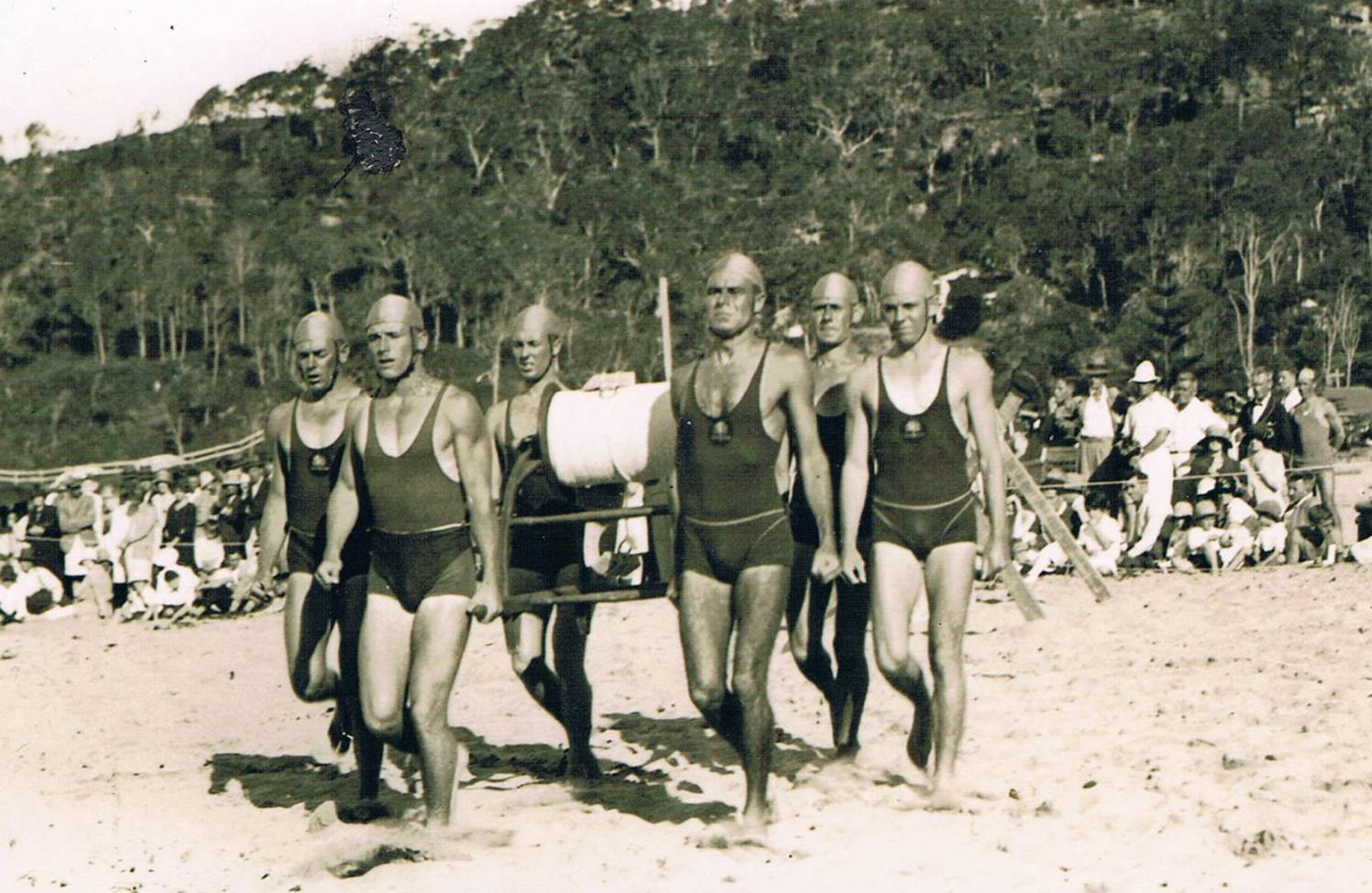
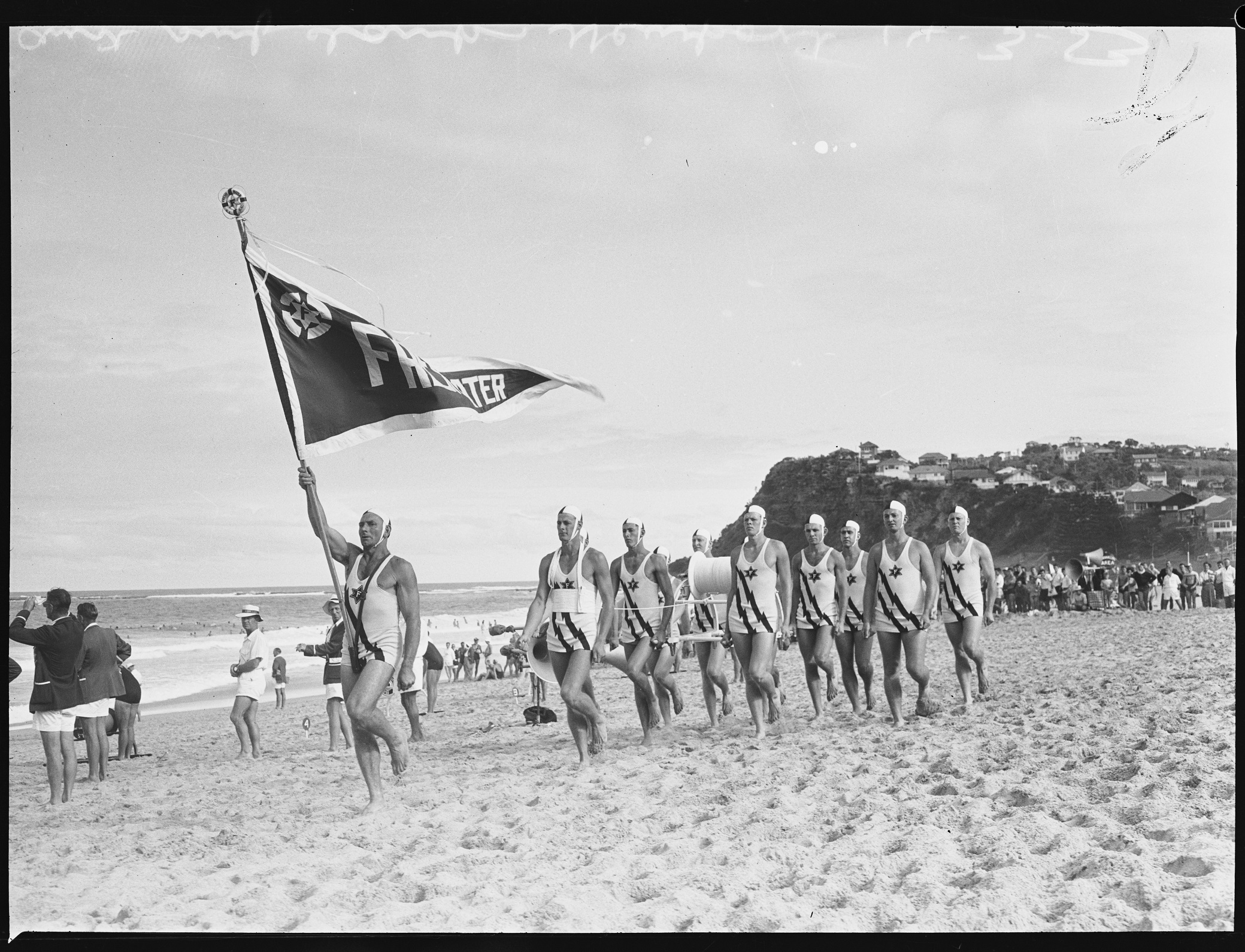
The introduction of the board as a surf rescue equipment option can be traced to surfboard happy Palm Beach SLSC, who had among their early membership John 'Jack' Ralston.
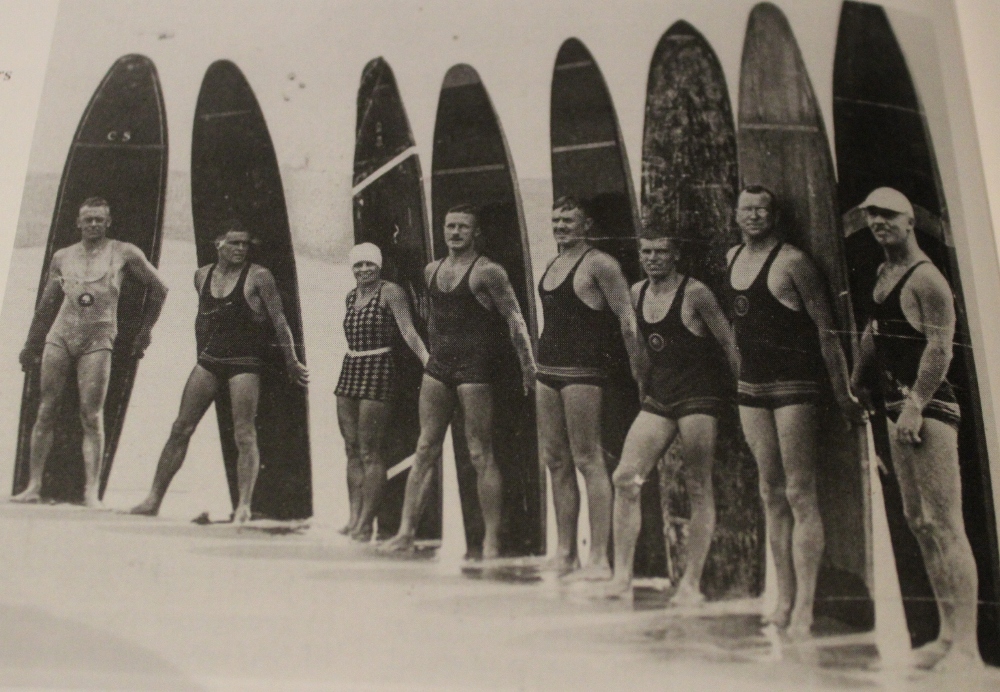
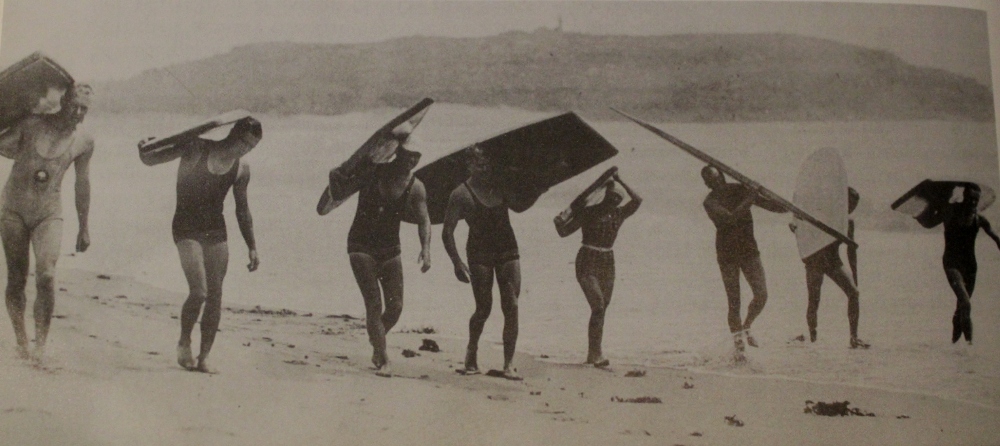
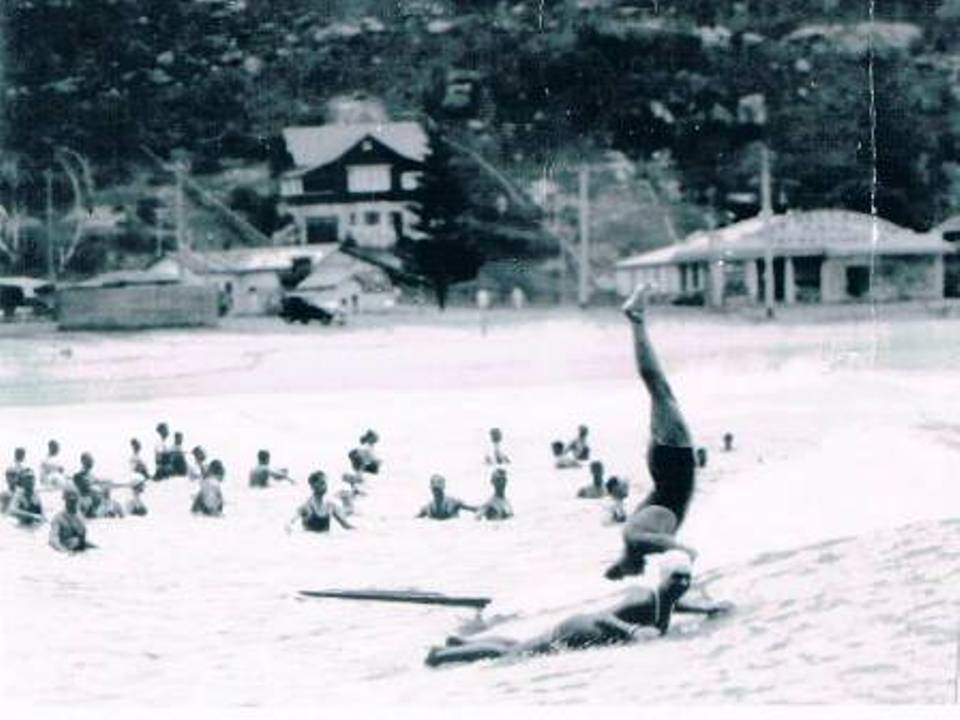
Adrian Curlewis, circa 1930 doing a headstand at Palm Beach - photo courtesy Philippa Poole, daughter of the 'Father of Surf Life Saving'
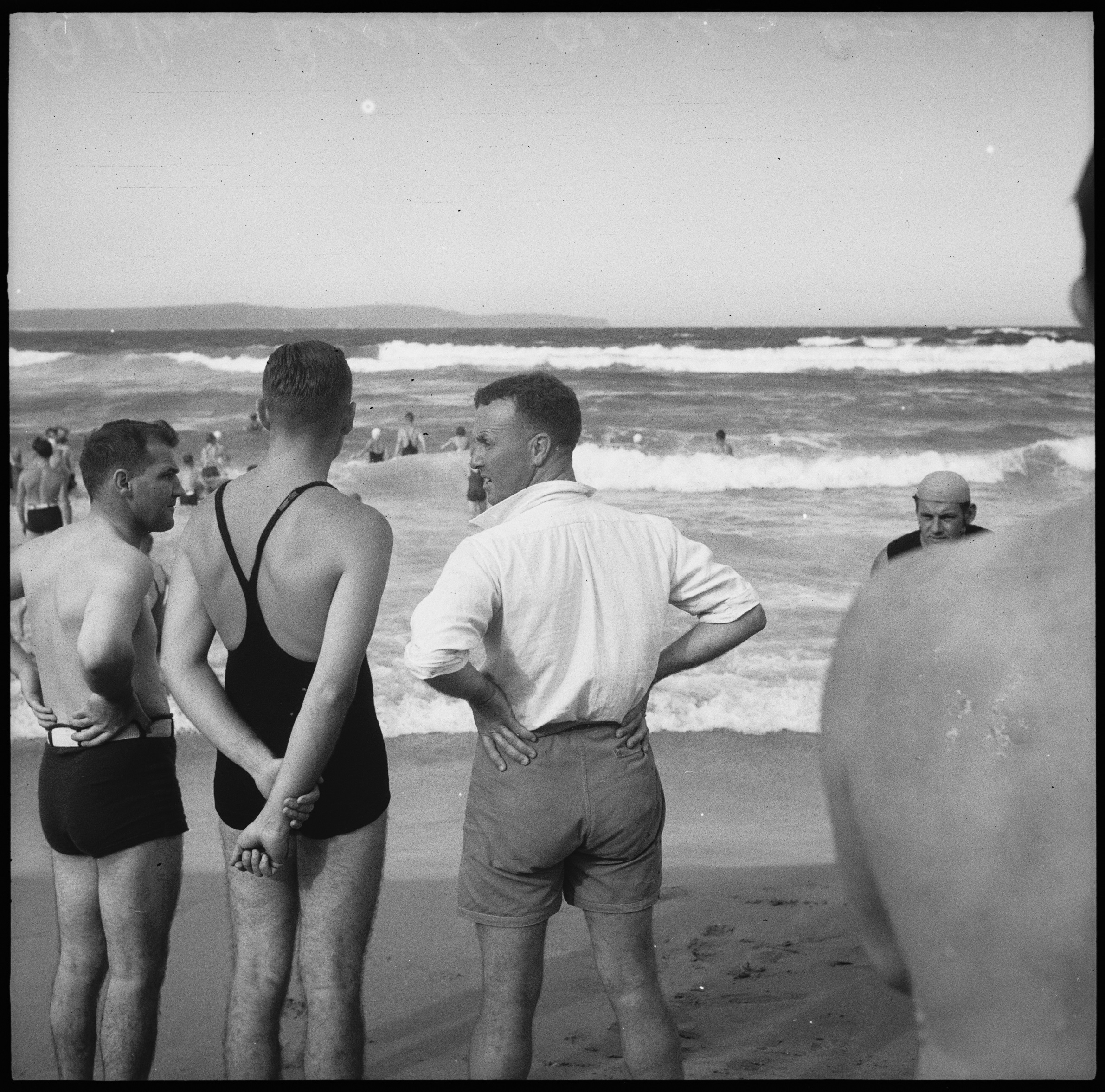
Adrian in kiddies corner during a very busy day at Palm Beach, talking to fellow PBSLSC Members. Photo taken January 6 1938 according to the State Library of NSW records, image courtesy State Library of NSW
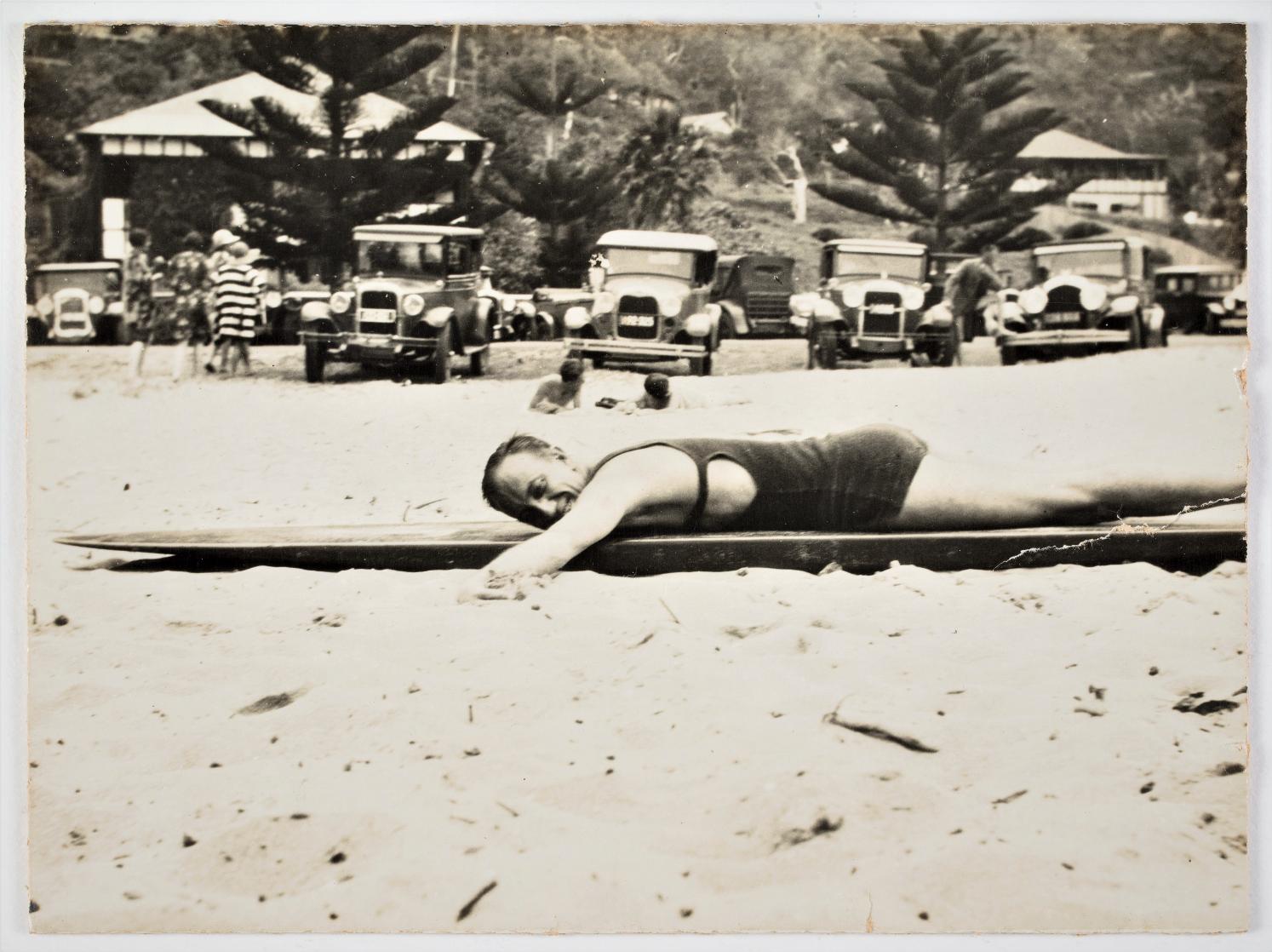
The story of surf board riding commences at Manly. There remains some contention as to whom brought a surf board here for use as surf life saving equipment, one recorded Surf Life Saving entry holding C D Paterson did as a surf life saving device in 1909, another that a Tom Walker did around the same time.
North Narrabeen can also lay claim to having early surfers among surf life saving members with Toby Hynard, a North Narrabeen SLSC member, apparently being taught board riding by the Duke while on a holiday to Hawaii and had brought a board back to Australia around 1911-12.
Australian legend of board riding, Snowy McAlister, also remembered someone from Narrabeen having a surfboard around that same time. Stan Exton, a pioneer and Life Member, always maintained that he brought the board to Narrabeen prior to 1915 and that he and his friend Toby used to share it. This is substantiated by a photo taken outside a cottage owned by Stan:
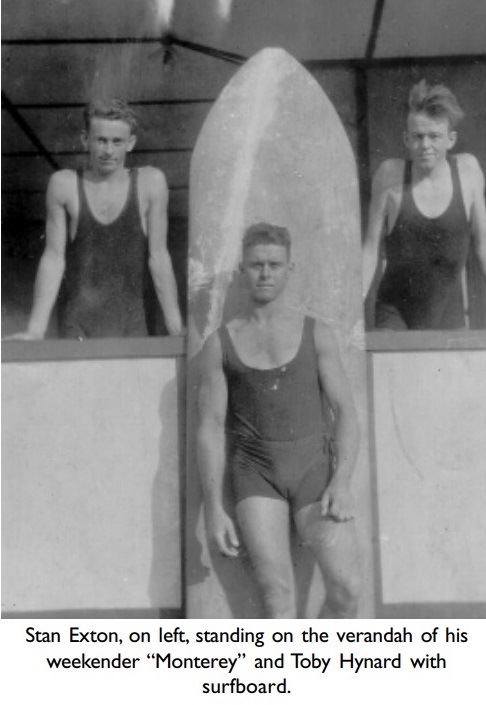
%20Tony%20Hynard%20surfboard.jpg?timestamp=1633629764832)
photos from and courtesy, The Beach Comes First, North Narrabeen SLSC history
This was followed by:
DUKE KAHANAMOUKU
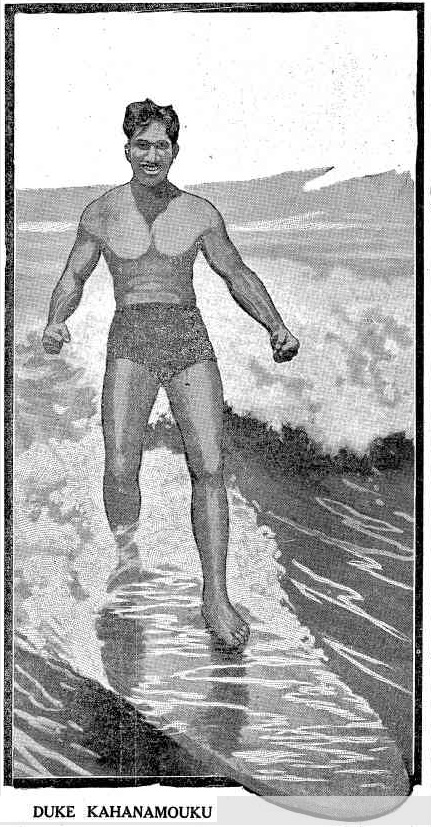
The marvellous Hawaiian, undisputed champion sprint distance swimmer of the world, some of whose natatorial feats are said to have astounded the fishes, as did the exploits of Pegoud, the French aviator, in the clouds, cause wonderment amongst the birds of the air. He is here seen performing one of his famous surfing accomplishments. This is not by any means his most daring achievement. Whilst dashing forward at an incredible speed, he stands on his head and does other things of an acrobatic description. Similar boards to the one he is shown using have been imported into Australia, but so far none of our surfing experts have been able to imitate his sensational deeds.
It is supposed, however, that the breakers that roll in on our shores are of a different formation, and not suitable for the purpose. All doubts on that subject would have been set at rest had Kahanamouku visited here this Summer, as was supposed to have been his intention. He has on several occasions expressed his willingness to come, but the time he originally offered to make the trip was regarded as inopportune by the officials of the Swimming Association who were carrying on the negotiations, and they fell through, owing to the date they suggested as a substitute clashing with the great water festival that is to be held at Honolulu on February 18 and 24 next. Visitors from all parts of the world have been known to go to Hawaii merely to witness Kahanamouku shoot the waves in the extraordinary fashion depicted above. DUKE KAHANAMOUKU (1913, December 14). Sunday Times (Sydney, NSW : 1895 - 1930), p. 20 (SUNDAY TIMES GLOBE PICTORIAL). Retrieved from http://nla.gov.au/nla.news-article126315151
And he following year, on Christmas Eve, Thursday December 24th, 1914:
JUST as my wild-eyed, touzle-headed Gilbert Island cook brought me my early coffee and hard ship biscuit, Toria and Vailele, brown-skinned brother and sister peeped in through the window, and in their curious bastard Samoan said 'twas a glorious morn to fahaheke.Now I had learned to fahaheke (use a surf-board), having been instructed therein by the youths and maidens of the village individually and collectively. And when you have once learned surf-swimming the game takes possession of your innermost soul like unto cycling and golf. So I said I would come, and instantly my young friends handed me in a surfing costume, a highly indecorous looking girdle of thin strippings of the leaf of the pandanus palm.This I blushingly declined, preferring a garment of my own design; a pair of dungaree pants razeed from the knees down. Then, bidding me hurry up and meet the swimming party on the beach, Toria and his sister ran back to the village to attend early morning service, to which the wooden cylinder that did duty for a church bell was already summoning the people.Now, in some of the Pacific Islands surf-swimming is one of the forbidden things, for many of the native teachers hold the sport to savour of the po uli – ie; of the heathen days - and the young folks can only indulge in the innocent diversion away from the watchful eye of the local Chadband and his alert myrmidons, the village police, among whom all fines are divided. But in this particular little island we had for our resident missionary a young stalwart Samoan, who did not forbid his flock to dance or sing, nor prohibit the young girls from wearing flowers in their dark locks. And he himself was a mighty fisherman and a great diver and swimmer, and smoked his pipe and laughed and sang with the people out of the fulness of his heart when they were merry, and prayed for and consoled them in their sorrow. So we all loved loane, the teacher, and Eline, his pretty young wife, and his two jolly little muddy brown infants ; for there was no other native missionary like him in all the wide Pacific.The simple service was soon over, and then there was a great scurrying to and fro among the thatched houses, and presently in twos and threes the young people appeared, hurrying down to the beach and shouting loudly to the white man to follow. A strong breeze had sprung up during the night, and the long rolling billows, which had sped waveringly along for, perhaps, a thousand miles from beyond the western sea-rim, were sweeping now in quick succession over the wide flat stretch of reef that stood out from the northern end of the island like a huge table. Two hundred yards in width from the steep-to face it presented to the sea, it ceased, almost as abruptly as it began, in a bed of pure white sand, six feet below the surface of the water ; and this sandy bottom continued all the way from the inner edge of the reef to the line of coco-palms fringing the island beach. At low tide, when the ever-restless rollers dashed vainly against the sea-face of the reef, whose surface was then bared and shining in the sun, this long strip of sheltered water would lay quiet and undisturbed, as clear as crystal and as smooth as a sheet of glass ; but as the tide rose the waves came sweeping over the coral barrier and poured noisily over its inner ledge till the lagoon again became as surf-swept and agitated as the sea beyond. This was the favoured spot with the people for surf-swimming, for when the tide was full the surf broke heavily on the reef, and there was a clear run of half-a-mile from the starting-point on the inner face of the coral table to the soft, white beach. Besides that, there was not a single rock or mound of coral between the reef and the shore upon which a swimmer might strike with fatal effect if the danger were not perceived in time.The north point was quite a mile from the village, and, the tide being very high, we had to follow a path through the coconut groves instead of walking along the beach, for the swirling waves, although well spent when they reached the shore, were washing the butts of the coco-palms, whose matted roots protruded from the sand at high-water mark. In front of us raced some scores of young children ranging from six years of age to ten, pushing and jostling each other in their eagerness to be first on the scene. Although the sun was hot already, the breeze was cool and blew strongly in our faces when we emerged from the narrow leafy track out upon the open strand. Then with much shouting and laughing, and playful thumping of brown backs and shoulders, Timi, the master of ceremonies for the occasion, marshalled us all in line and then gave the word to go, and with a merry shout, mingled with quavering feminine squeaks, away we sprang into the sea, each one pushing his or her surf- board in front, or shooting it out ahead, and trying to reach the reef before any one else.And now the slight regard for the conventionalities that had been maintained during the walk from the village vanished, and the fun began ducking and other aquatic horseplay, hair-pulling, seizing of surf-boards and throwing them back shorewards, and wrestling matches between the foremost swimmers. The papalagi (white man), swimming between the boy Toria and a short, square-built native named Temana, had succeeded in keeping well in the van, when he was suddenly seized by the feet by two little imps, just as a sweeping roller lifted him high up. And down the white man went, and away went his surf-board shoreward amid the shrieking laughs of the girls." Never mind," shouted Temana, shaking his black curly head like a water-spaniel ; and seizing a board from a girl near him, and pushing her under at the same time, he shot it over towards me ; and then Toria, with a wrathful exclamation, caught one of the imps who had caused my disaster and, twining his left hand in her long, floating hair, pitched her board away behind him. This little incident, however, lost us our places, and amid the merry gibes of some naked infants who were in the ruck, we swam on in face of the slapping seas, and at last gained the edge of the reef, which was now alive with nude, brown-skinned figures, trying to keep their position in the boiling surf for the first grand " shoot " shoreward.Between the lulls of the frequent seas the water was only about four feet deep, and presently some sort of order was formed, and we awaited the next big roller. Over the outer reef it reared its greeny crest, curled and broke with thundering clamour, and roared its mile-line length towards us. Struggling hard to keep our feet on the slippery coral against the swift back-wash, we waited till the white wall of hissing foam was five feet away, and then flung ourselves forward flat upon our boards.Oh, how can one describe the ecstatic feeling that follows as your feet go up and your head and shoulders down, and you seem to fly through the water with the spume and froth of the mighty roller playing about your hair and hissing and singing in your ears ? Half a mile away lies the beach, but you cannot see it, only the plumed crowns of the palms swaying to and fro in the breeze ; for your head is low down, and there is nothing visible but a wavering line of shaking green.Perhaps, if you are adept enough to turn your head to right or left, you will see silhouetted against the snowy wall of foam scores and scores of black heads, and then before you can draw your breath from excitement the beach is before you, and you slip off your board as the wave that has carried you so gloriously in sweeps far up on the shore, amid the vines and creepers which enwrap the sea-laved roots of the coco-palms.Then back again, up and down over the seas, diving beneath any that are too high and swift to withstand, till you reach the ledge of the reef again and wait another chance. Not all together do we go this time, for now the swimmers are widely separated, and as we swim out we meet others coming back, flying before the rollers under which we have to dive. Here and there are those who from long practice and skill disdain to use a board ; for springing in front of a curling sea, by a curious trick of hollowing in the back and depressing the head and neck, they fly in before the rolling surge at an amazing speed, beating the water with one hand as they go, and uttering wild cries of triumph as they pass us, struggling seaward. Others there are who with both hands held together before them, keep them-selves well in position amid the boiling rush of waters by a movement of the legs and feet alone.But, that day, to my mind the girls looked prettiest of all when, instead of lying prone, they sat upon their boards, and held them-selves in position by grasping the sides. Twice, as we swam out, did we see some twenty or thirty of them mounted slopingly on the face of a curling sea, and with their long, dark locks trailing behind them, rush shoreward enveloped in mist and spray like goddesses of the waves. Their shrill cries of encouragement to each other, the loud thunder of the surf as it broke upon its coral barrier, the seething hum and hiss of the roller as it impelled them to the beach, and the merry shrieks of laughter that ensued when some luckless girl over-balanced or misguided herself in the midst of the foam, lent a zest of enjoyment to the scene that made one feel himself a child again.For two hours we swam out again and again to fly shoreward ; and at last we met together on the beach, to rest under the shade of the palms, the girls to smoke their banana-leaf sului of strong negro-head tobacco, and the men their pipes, while the younger boys were sent to gather us young drinking-coconuts.
Those not into tossing themselves around in the water or on a wave could play golf, with a number of golf courses opening locally from the 1920's on at Mona Vale, Bayview, Avalon Beach and Palm Beach:
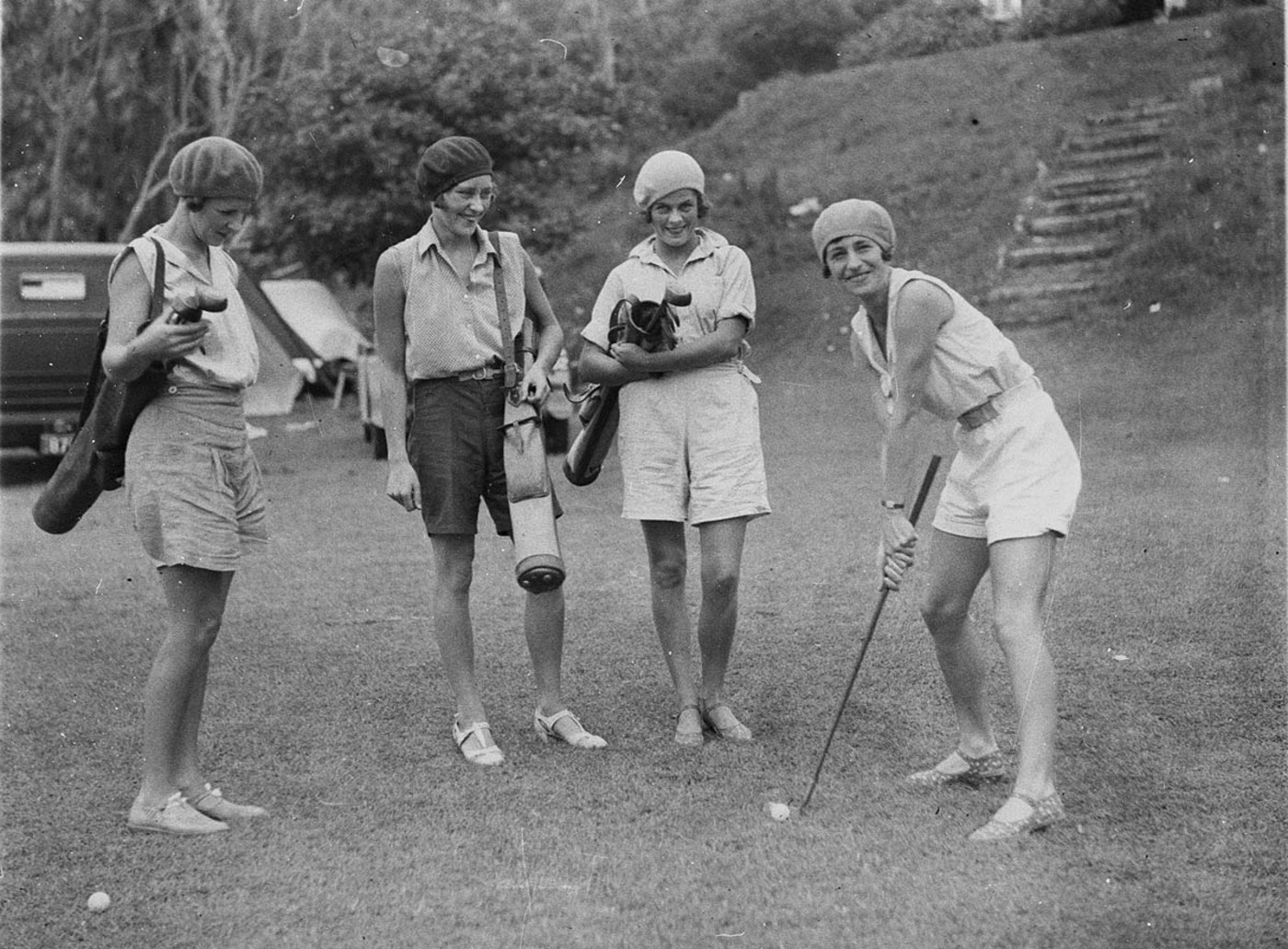
Palm Beach Again
PALM BEACH is setting new fashions in all directions, and the vogue is not confined to bathing togs alone. Sydney shrugged its shoulders when it learnt that society danced in. shorts during the season, and now comes word that the "gay young things" are sporting diminutive trousers on the golf links, in place of the usual very smart sports suit. Last week some very "fetching" ones made their appearance on this exclusive sports ground, and the fair wearers could not have been unconscious of the effect, when, in between dips they strolled to the links and played a round or two. Fancy! (1930, March 10). Daily Pictorial (Sydney, NSW : 1930 - 1931), p. 19. Retrieved from http://nla.gov.au/nla.news-article246125223

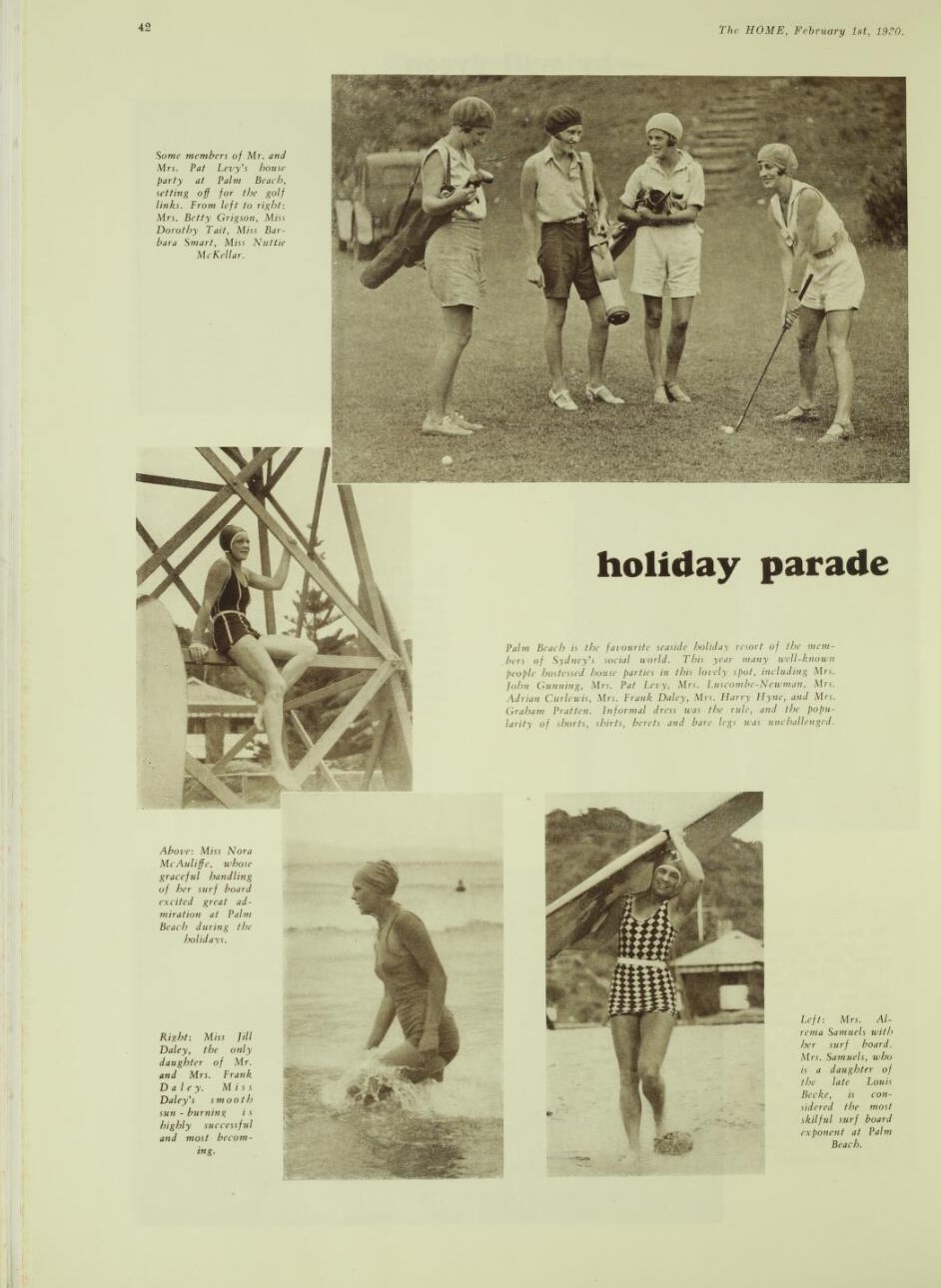
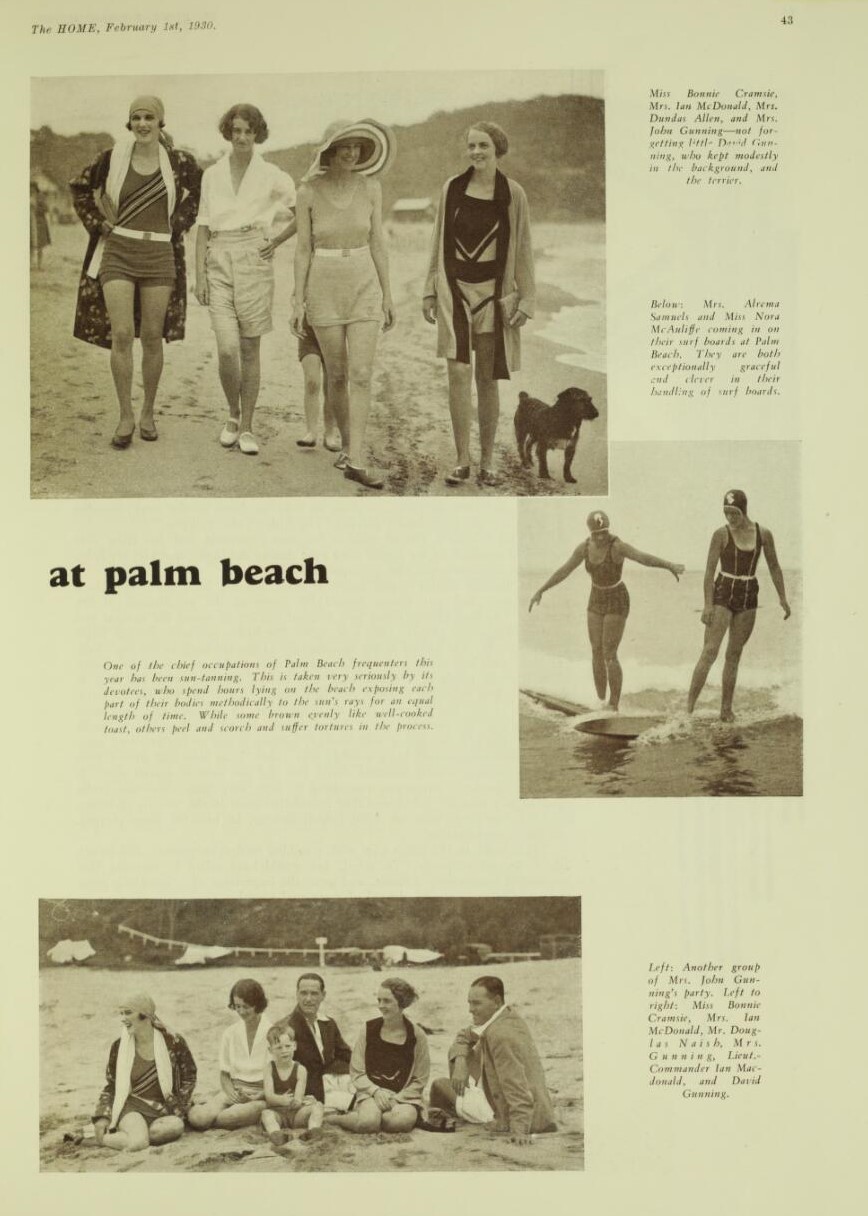
holiday parade at palm beach, The Home : an Australian quarterly. Vol. 11 No. 2 (1 February 1930) Retrieved from http://nla.gov.au/nla.obj-389238046
In the early 1930's the surfoplane, the idea of a Dr. Ernest Smithers who would also patent a design for the jaffle iron in 1949 and come up with many other brilliant ideas to make life easier or better, began to appear. Newspaper reports from then state it took eight years to develop.
A patent application (#9929 Class 3) for a "Surf plane" by E. E Smithers and C. D. Richardson was lodged on the October 7th 1932. - Official Journal of Trade Marks and Designs, Volume 3, Number 13, 1933, page 432.
Warringah shire council records that at the Meeting held December 19th, 1932:
Krapehide Rubber Products Co. 14/12/32, requesting permission to-hire out on beaches air inflated surfoplanes. Council Resolved: That they be granted permission provided the spaces to be used by them be allotted by the Inspectors.-,
Krapehide were concerned with replacement soles for shoes prior to this.
On December 14th 1933 the Patent Office accepted a Trade Mark design for the "Surfo-plane": "CLASS 49 (Games of all kinds and sporting articles not included in other classes.) 61,515 Rubber surf board. ERNEST ERIC SMITHERS, and CARL WORDSWORTH RICHARDSON, of 193 Macquarie-street, Sydney, NSW, Australia, manufacturers, - 11th March, 1933.". Official Journal of Trade Marks and Designs Volume 3, Number 13, 1933, page 1421.
Then a company was registered, which included an apparent friend of Dr. Smithers and possible inspiration for the name:
SURFOPLANES, LTD.—Reg. 6/4/34. Cap.: £20,000 in 10,000 cumulative preference, 2500 ordinary, and 7500 £1 shares to be issued at the discretion of the directors. Objects: To adopt an agreement dated 17/3/34 between Ernest E. Smithers, of Macquarie-st., Sydney, medical practitioner, and Sir Charles Kingsford Smith, of the one part, and T. H. Wynne-Lewis, as trustee for the company, of the other part, and to carry on the business of vendors, hirers and manufacturers of the invention known as Surfo Planes, etc. Subscribers: Ernest E. McLachlan, Percy A. Hocking, Alfred S. Smithers, Athol J. Sutherland, Alexander J. Nathan, Thomas H. Wynne-Lewis and Sir Charles Kingsford Smith (1 share each). First directors: Dr. Ernest E. Smithers and Sir Charles Kingsford Smith. Reg. office: 18 Martin-place, Sydney. (1909 – April 16, 1934 Issue). Dun's gazette for New South Wales Retrieved from http://nla.gov.au/nla.obj-819668581
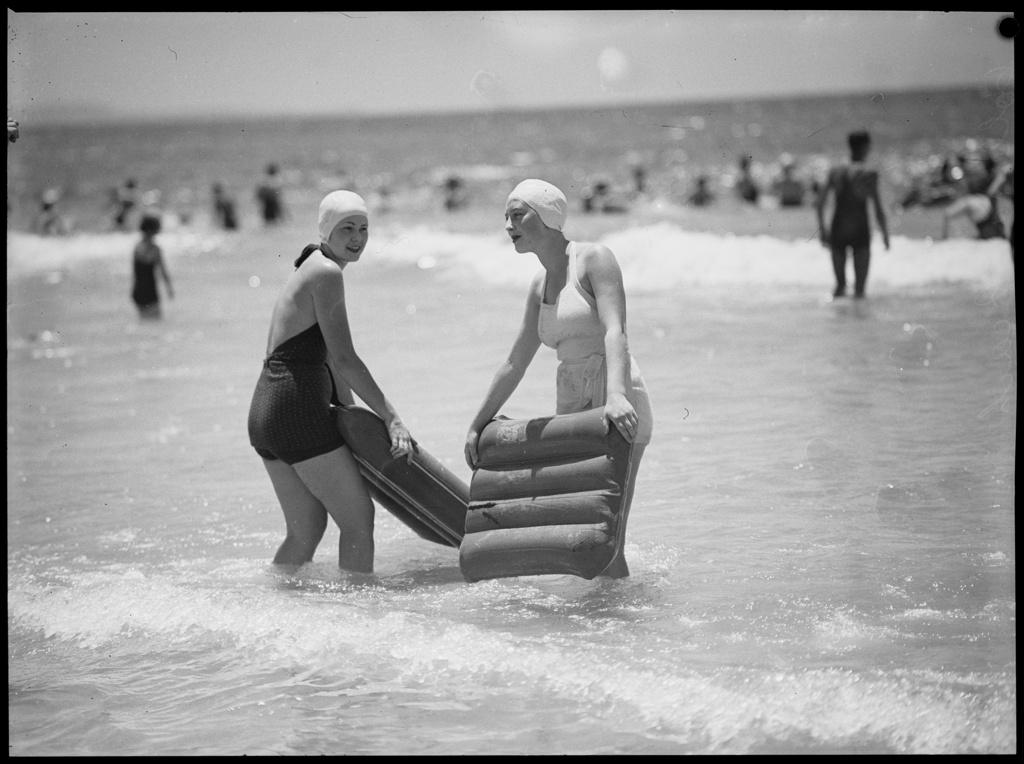
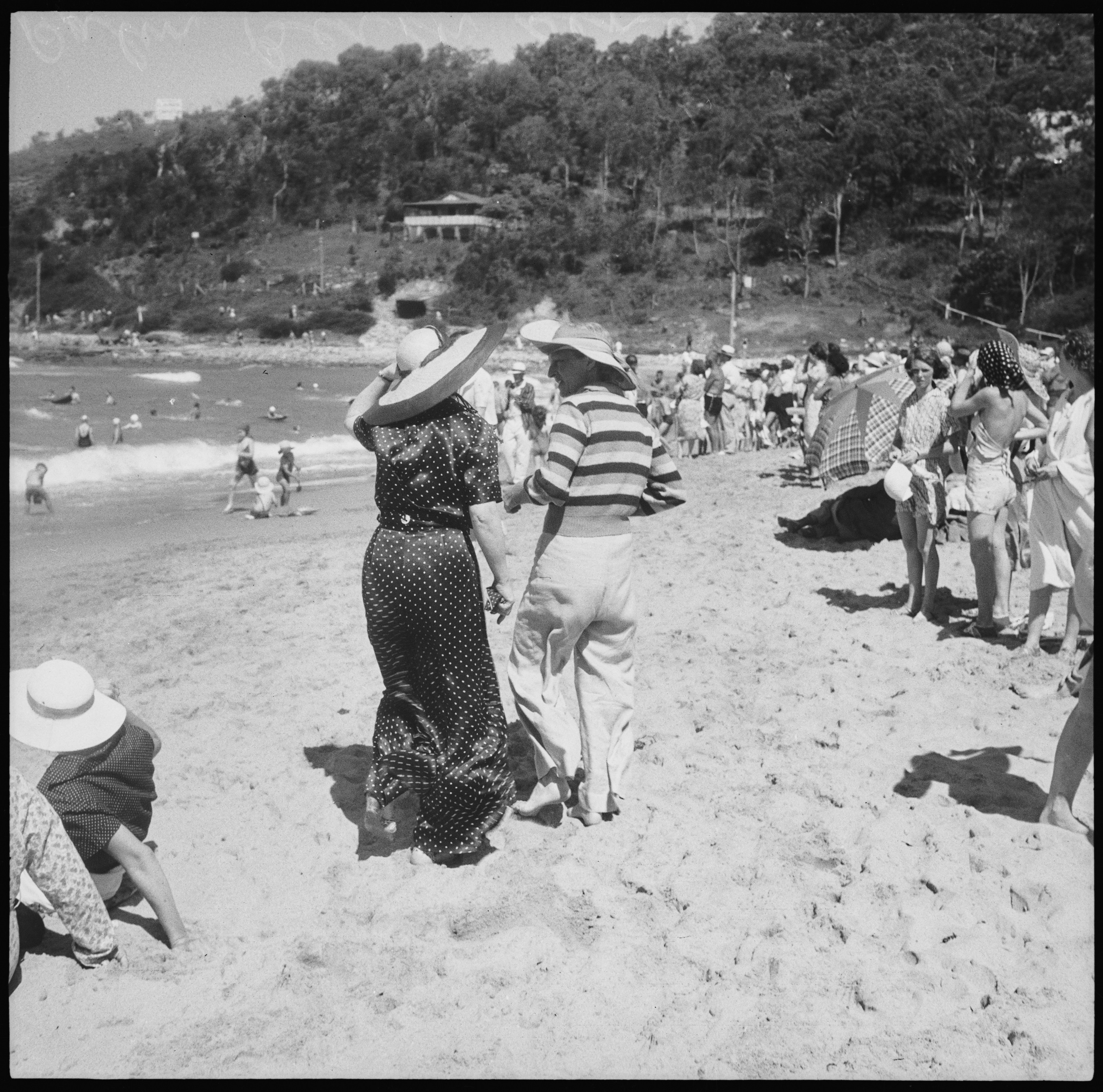
Photo taken January 6 1938 according to the State Library of NSW records - on Palm Beach sands - photos from same album appear in a January 29, 1938 article in Pix. Item: SLNSW_FL9643984, courtesy State Library of NSW - from same album - on the estuary side from Palm Beach down to Taylor's Point:
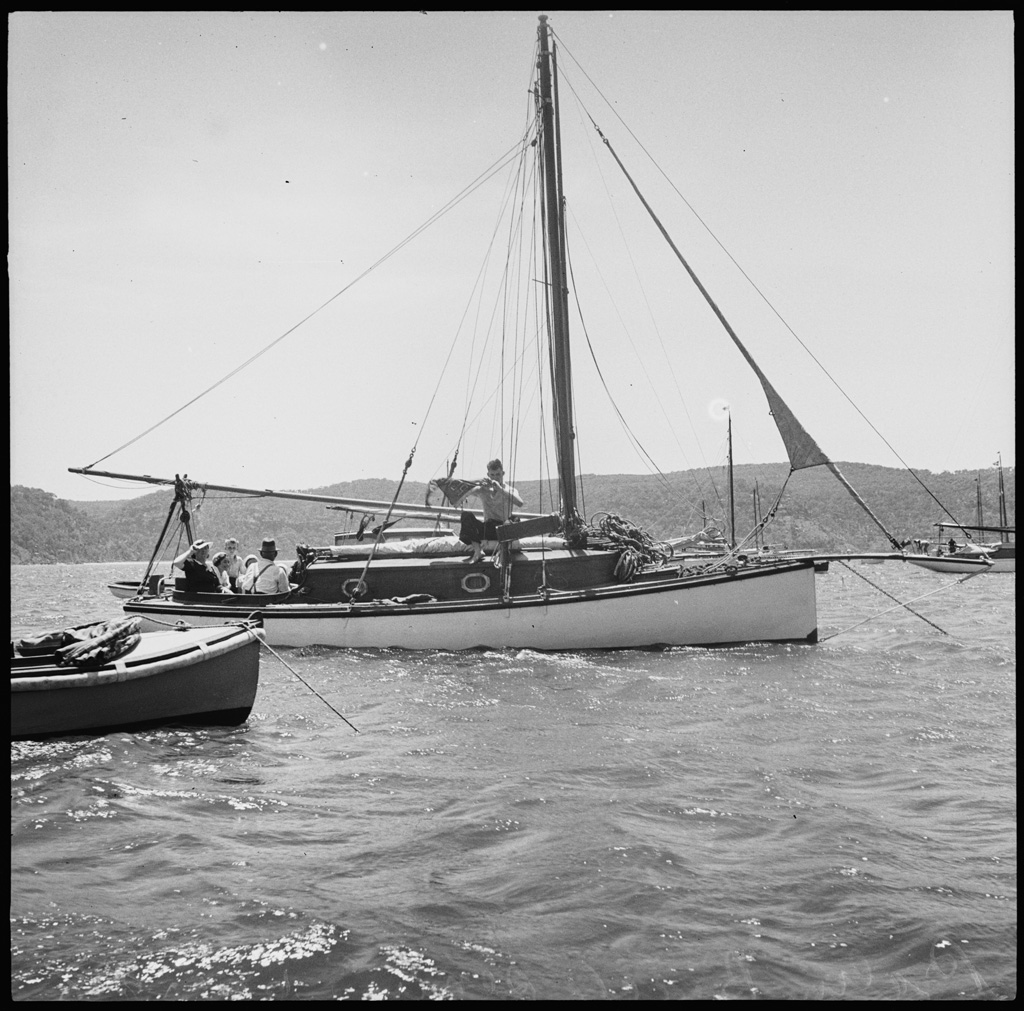
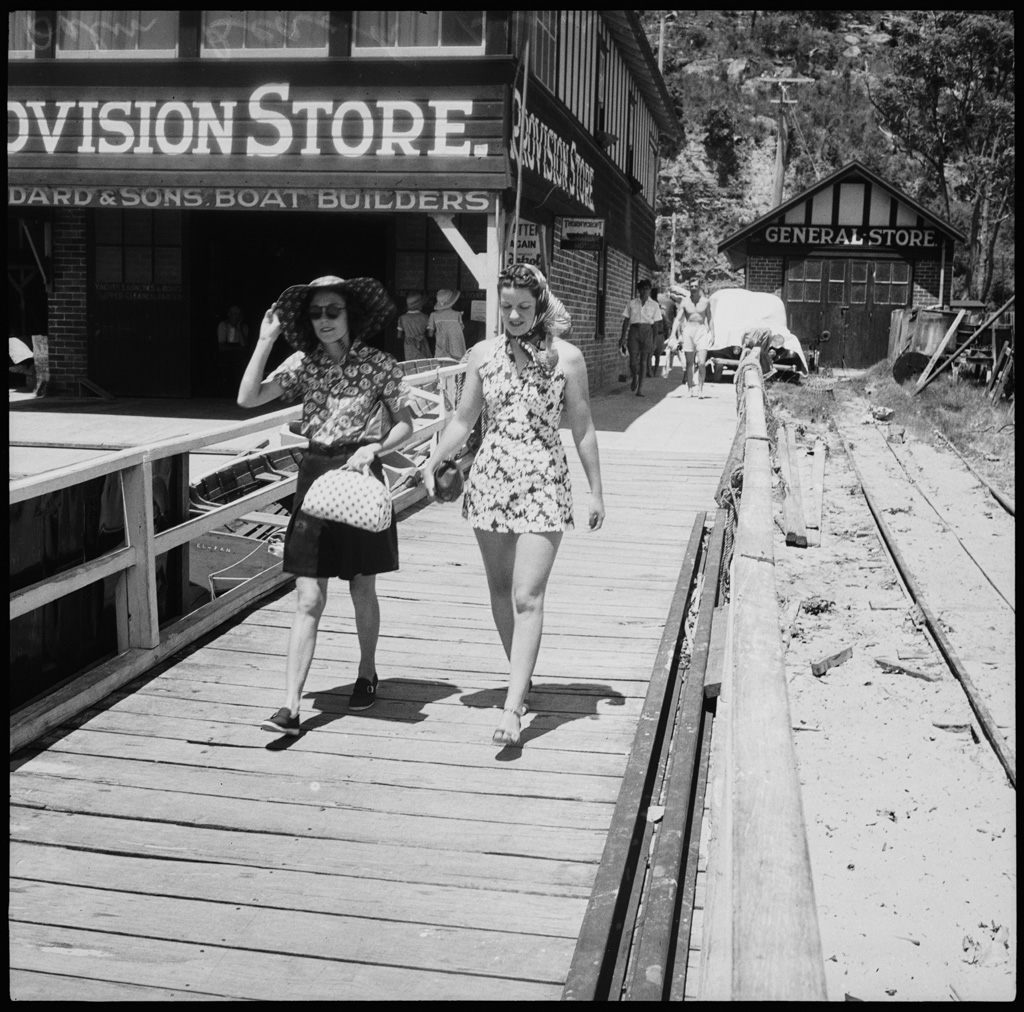
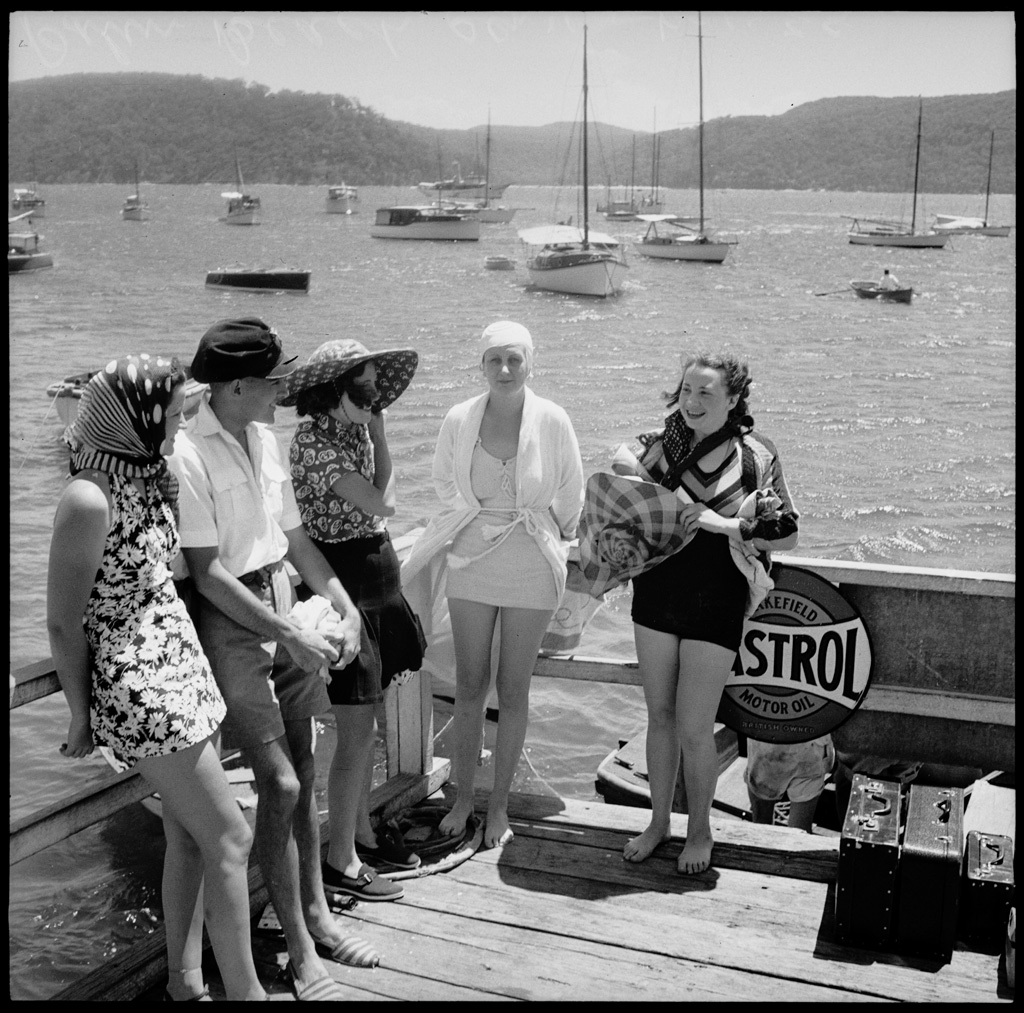
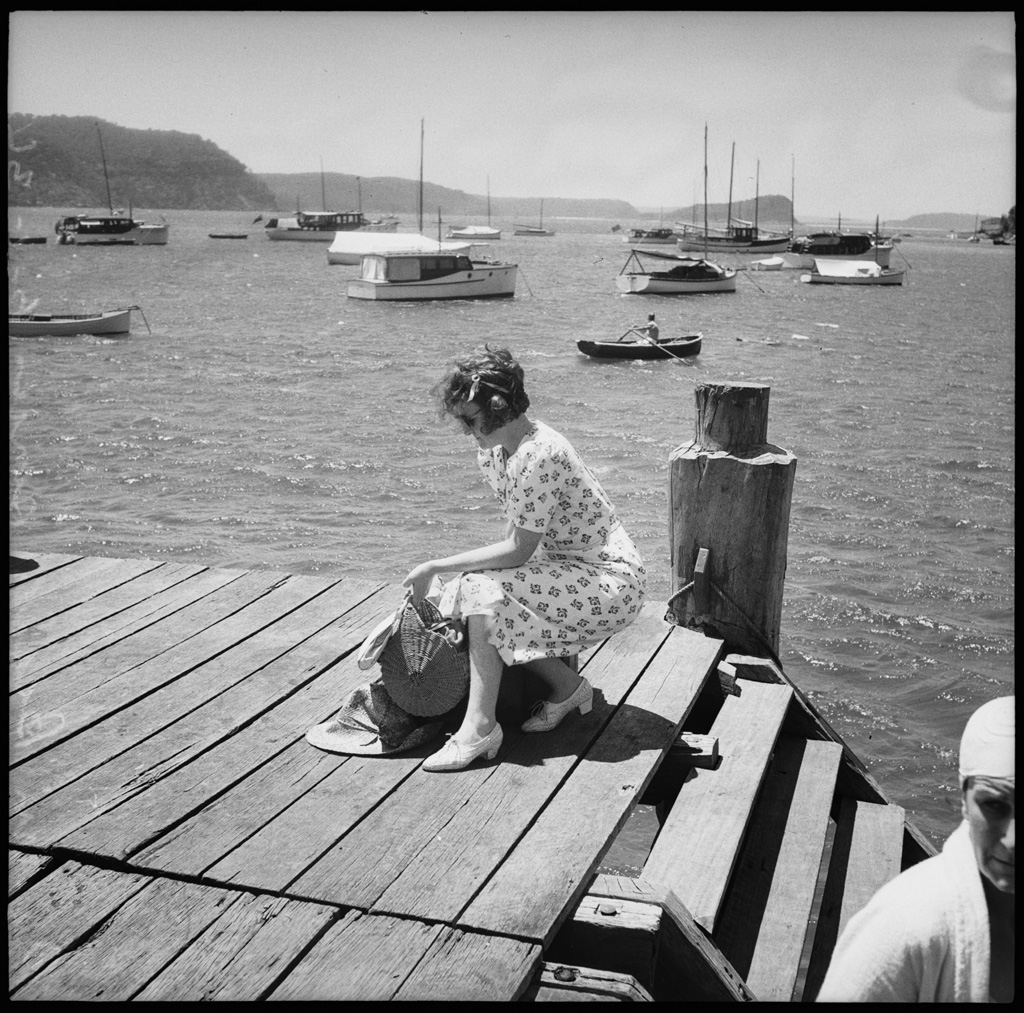
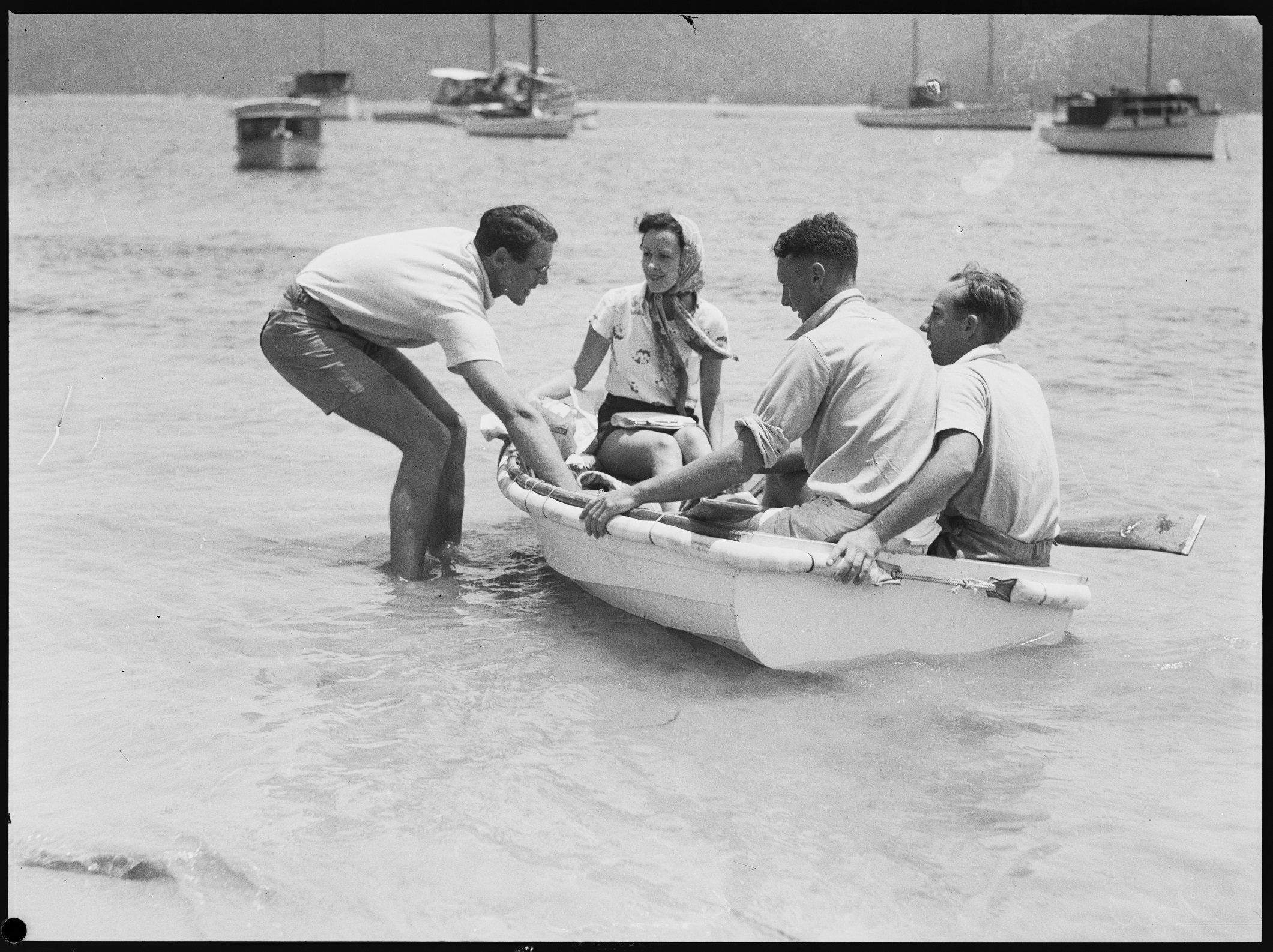
There were also some rather unusual ways to 'have fun' in the area turning up in the archives:
NEW SUMMER SPORT ON NARRABEEN LAKES
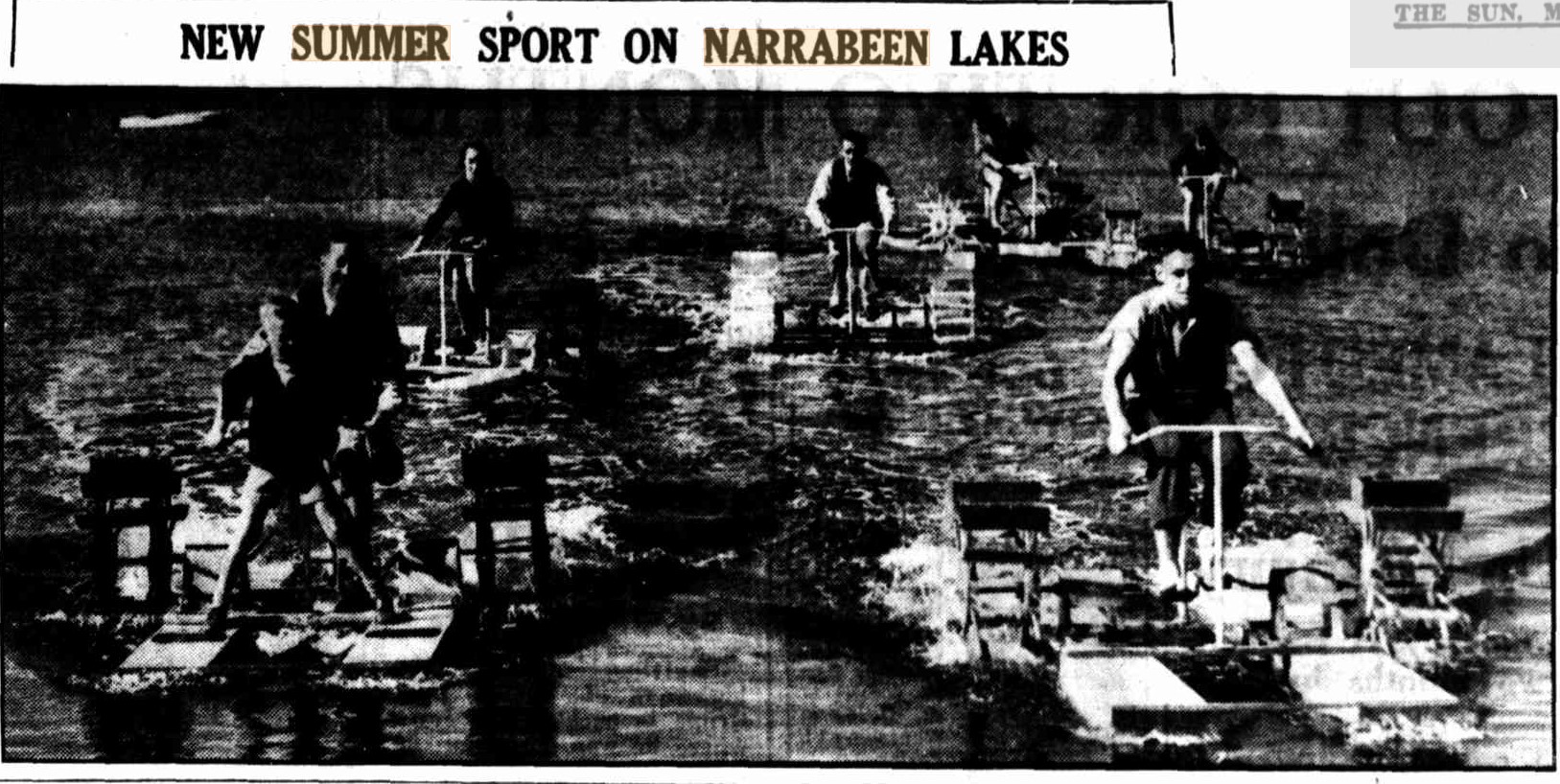
You can ride a bicycle on water now, but the machines must have floats like these. The water cycles provide a popular pastime at Narrabeen. NEW SUMMER SPORT ON NARRABEEN LAKES (1941, May 12). The Sun (Sydney, NSW : 1910 - 1954), p. 15 (LATE FINAL EXTRA). Retrieved from http://nla.gov.au/nla.news-article231446273
With the warmer weather also came the possibility of bushfires, with every suburb from Narrabeen to Palm Beach having experienced these. Here too people raised funds to help those who lost everything in these fires.
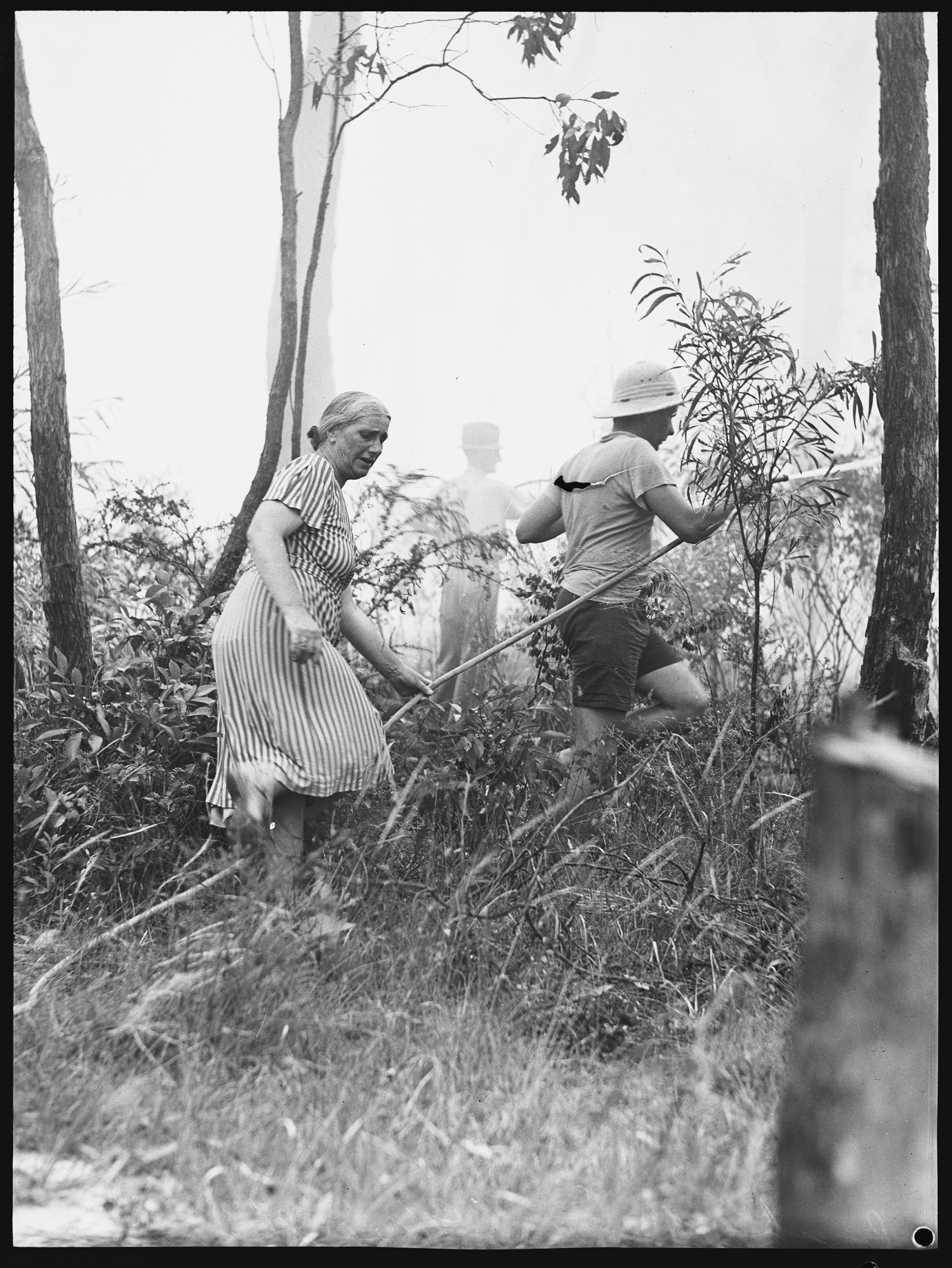
Bushfires at Avalon and Palm Beach 9 December 1938 SLNSW_FL19127576, courtesy State Library of NSW
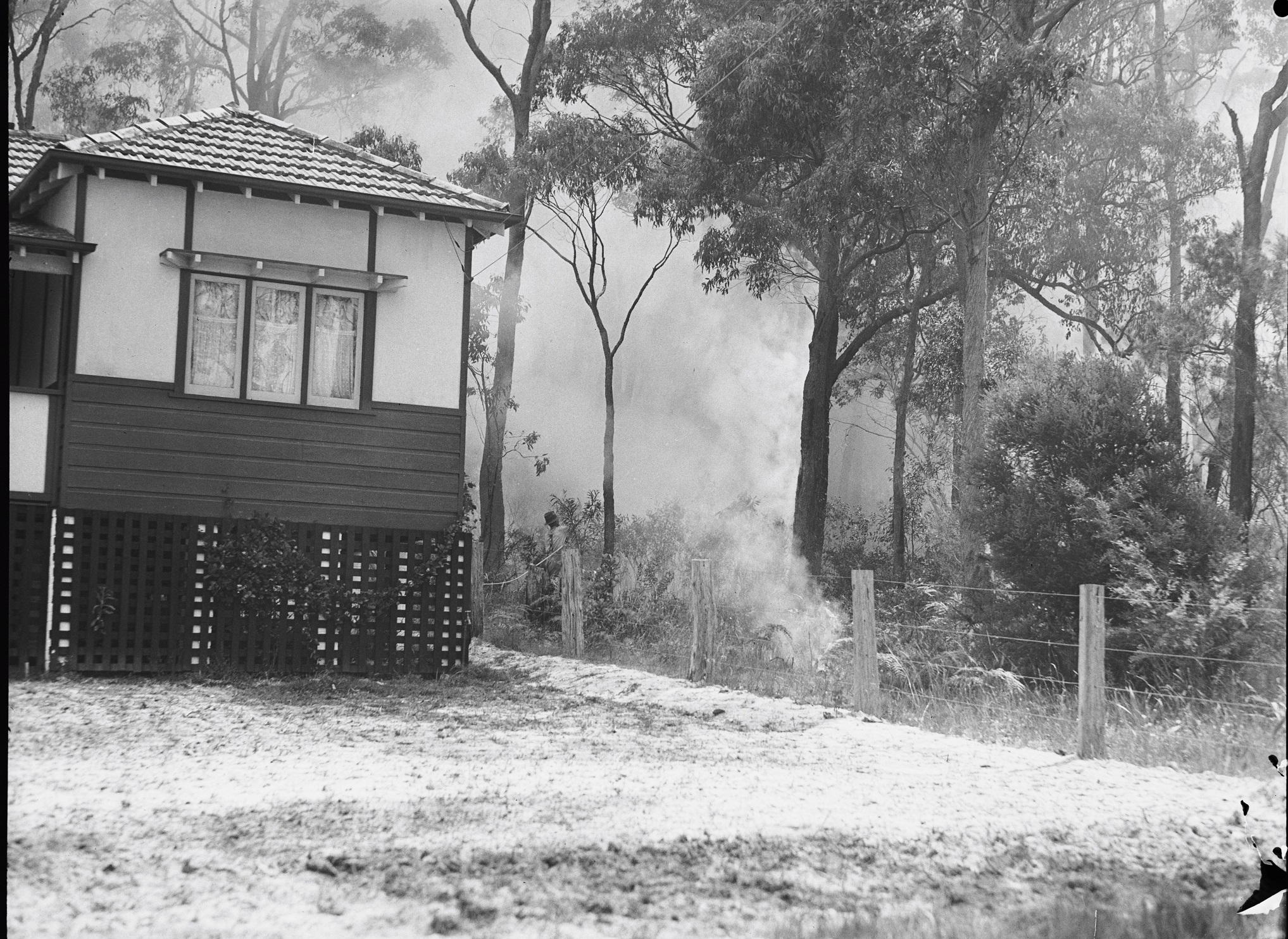
Bushfires at Avalon and Palm Beach 9 December 1938 SLNSW_FL19127582, courtesy State Library of NSW
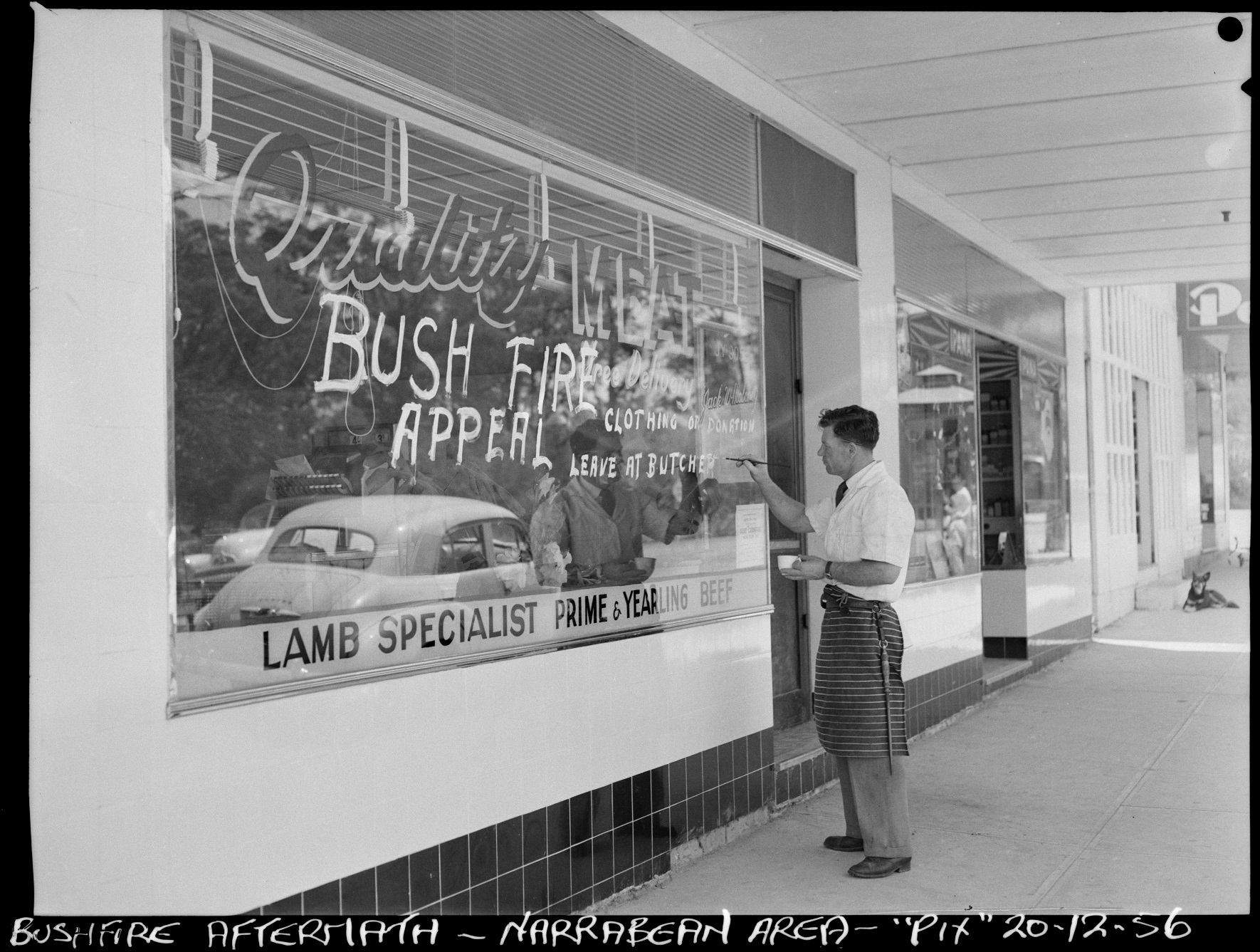
Bush fire appeal - post Narrabeen 1938 fires. Item: SLNSW_FL15662872, Narrabeen and Frenchs Forest area, 20 December 1956 / photographs by Lynch, courtesy State Library of NSW
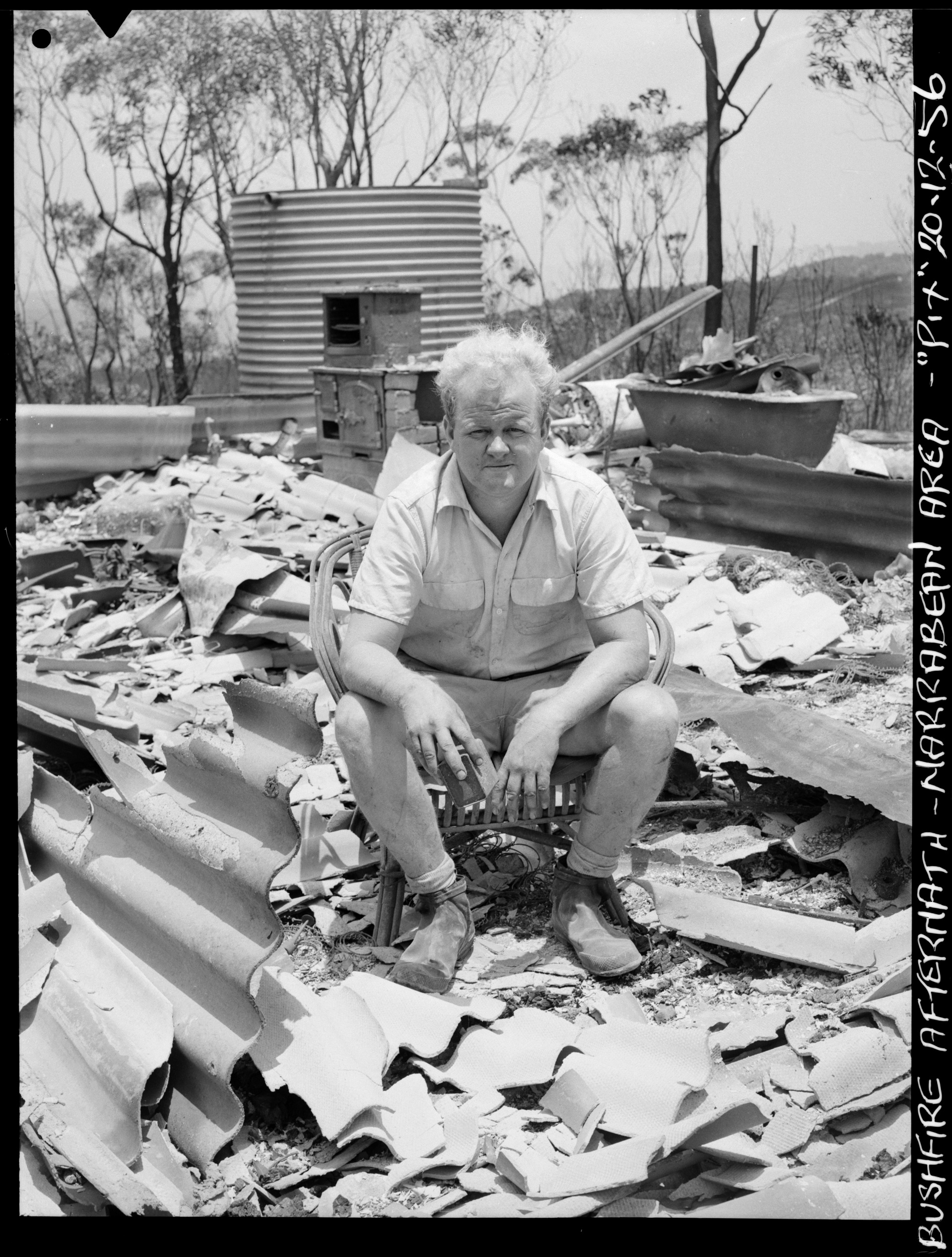
Bushfire aftermath - Narrabeen and Frenchs Forest area, 20 December 1956 / photographs by Lynch
Bushfire at Mona Vale
SYDNEY, Sunday: The first serious bushfire this summer broke out today near Mona Vale, north of Sydney. Fanned by a strong westerly wind, the blaze at one stage threatened four houses at Warriewood, a tiny beach resort.
The fire burnt through thick scrub on a three miles front, and Jumped several roads before being brought under control. Bushfire at Mona Vale (1952, November 3). Daily Advertiser (Wagga Wagga, NSW : 1911 - 1954), p. 1. Retrieved from http://nla.gov.au/nla.news-article145509364
Ultimately, as instanced in the sales brochures for the first Palm Beach land sales of January 12 1912, and from all permanent residents and those who visit us during the warm months still, this was about getting away from the dust and heat of the city to connect with the beauty of the bush and water amid cooling sea breezes.
They were all ‘running into the arms of God’ where it doesn’t matter how rich or how poor you are because all that has been gifted is yours to have simply by standing in this place, dipping your toes in the waters, climbing that hill for that view, and finding a quiet corner where you can exhale until the song being sung within the landscape acts as a balm within you, restoring your soul.
This was and remains about becoming part of the green and the blue until you are letting those songs sing out from you.
Is there anything better than a Summer in Pittwater?
How lucky we are to get to live here every single day!
A few closing words from a clear fan of a Summer in Pittwater:
NARRABEEN
Miles of sapphire lake and forest,
Miles of sky and jade sea mist,
Sandy beaches where grass rushes
Rustle, wind and water kist,
Till the lake's fair face is hidden
In a veil of amethyst.
Miles and miles of summer glories -
Christmas bells and bush ablaze -
Miles of seashore, red and golden,
Drifting into purple haze,
Where the gum trees' scented vapors
Perfume Narrabeen's sylvan ways.
— LOLA CORNALL
NARRABEEN. (1924, December 6). Evening News (Sydney, NSW : 1869 - 1931), p. 4. Retrieved from http://nla.gov.au/nla.news-article117977980
References - Extras
- TROVE - National Library of Australia
- The Mitchell Library, State Library of NSW
- Clareville Public Wharf: 1885 to 1935 - Some History
- Pittwater Summer Houses: Rocky Point and Elvina Bay Peninsula - A Place Of Holiday Songs and Operas In Ventnor, Fairhaven, Trincomalee and Maritana
- The First Scotland Island Cup, Trophy and Race and the Gentleman who loved Elvina Bay
- A Tent at The Basin
- A Tent Or Hut At The Basin During Holiday Times
- Camping at Narrabeen – A Trickle then a Flood
- Avalon Camping Ground
- Stokes Point To Taylor's Point: An Ideal Picnic, Camping & Bathing Place
- Camping At Palm Beach - 2021 refreshed version
- Pittwater Summer Houses: A Tent At Palm Beach's Governor Phillip Park 'Neath Barrenjoey
- How Camping and Campers At Whale Beach Helped The Whale Beach SLSC Save Lives
- Bilgola Beach - The Cabbage Tree Gardens & Camping Grounds + Bilgola The Story Of A Politician, A Pilot And An Epicure by Tony Dawson and Anne Spencer
- Collin's Retreat-Bay View House-Scott's Hotel
- The Oaks - La Corniche - Mona Vale beach
- Pittwater Summer Houses: Ocean beach House - The Combers, Newport beach
- Pittwater Summer Houses: 'Billabong' + 'Ocean House', Ocean Street, North Narrabeen - The House At The End Of The Road - Became Site Of North Narrabeen SLSC's 'Batchelor Club - 2023 refreshed version with more research added
- 'Billabong' and 'Ocean House', Ocean Street, North Narrabeen - 2012 original
- Summer Houses In Pittwater: A Cottage Of 1916 and Palm Beach House - 1916 To 1929
- Pittwater Restaurants You Could Stay At Barrenjoey House – Palm Beach: 100 Years Young In 2022
- Florida House, Palm Beach
- The First Pittwater Regatta
- Pittwater Regattas of 1907 and 1908
- Some Recollections Of Early Bayview - a chat with Don Taylor and Margaret Tink
- Bellemere-Melrose + The Green Frog at Church Point: Pittwater Summer Houses
- Pittwater Restaurants you could stay at Pasadena Road House – Church Point - 2015 original version
- La Corniche, Bayview
- Stokes Point Careel Bay: The Shift From Warner's Hut In 1813 To Finisterre In 1924; 1934 Additions Probably Designed By Australia's First Female Architect, Beatrice (Bea) May Hutton - A Pittwater Rendezvous Site For Royal Sydney Yacht Squadron Members Is Still A Home With A View For Those With A Passion For Sailing
- Avalon Beach Golf Links: Pittwater Fields of Dreams II
- Daniel Gordon Soutar's Influence On Local Golf Courses: Some History Notes
- Royal Avalon Golf Links: Geoff Searl OAM's Presentation - Film By Pittwater Pathways (John Illingsworth)
- The Black Swamp Camping Reserve Becomes Kitchener Park, Beeby Park & Mona Vale Golf Course - Pittwater Creeks series opener
- Palm Beach Golf Course 1924 To 2024: Some 100th Year History Celebratory Insights
- The Palladium Palm Beach (1930 to 1974) + Palm Beach Studio (1976 to 2024)
- North Narrabeen Rock Pool: Some History
- The Old Road To Narrabeen - The Unspoilt Days Of 100 Years Ago When You Could Still See the Sea
- National Fitness Centres at Broken Bay, Mona Vale, Narrabeen: Local History shows we like to move it! Move It!
- 'Longa Linga' At Church Point - The John Lander Browne Pre-WWII Designed Linear Home For An Aunt
- First to fly in Australia, Sunday December 5th, 1909; George Augustine Taylor and Florence Mary Taylor
- Pittwater Regatta Air Race Trophies: from 1934 and 1935 and The Pilot Who Saved William Hughes
- Landing in Pittwater: That Beach-Estuary-Lagoon looks like a great place to touchdown!
- Pittwater Aviatrixes on the eve of the RAAF's 100th: A NSW Women's Week - Women of Aviation Week Celebration
Pittwater Roads II: Where the Streets Have Your Name - Church Point
FOR SALE. — A Splendid 1 Allotment- of .Land, 3 1/2 Acres. At Bayview, next to the Post-office and G. Wharf. Splendid Position for a Boarding house. Apply, Boatshed, Bayview, Pittwater. Advertising (1906, November 4). Sunday Times (Sydney, NSW : 1895 - 1930), p. 3. Retrieved from http://nla.gov.au/nla.news-article126564889
CLOSE to the OCEAN BEACHES and ATTRACTIVE WATERING PLACES in the picturesque District of PITTWATER, NEAR MANLY.
RAPIDLY COMING TO THE FRONT AS A FAVOURITE HOLIDAY RESORT.
1. THE ROCKLILY HOTEL,
A WELL-KNOWN HOLIDAY HOUSE, standing in its ovvn grounds, having trontagcs of 170 feet to the PITTWATER-ROAD, and 205 feet to VINEYARD STREET, also the Recreation Reserve opposite, having 112 foot frontage to the PITTWATER-ROAD, with an average! depth of 275 feet, situate close to the Junction of BAY VIEW and NEWPORT ROADS.
The House Is built of brick, on brick foundation, with verandah in front, and wide verandah and grape trellis at side, and containing hall, bar, 2 dining rooms, 4 private dining rooms, sitting room, parlour, servants dining room, 5 bedrooms, 2 servants bedrooms, ???? room, 2 lavatories, kitchen, wash house, cellar in basement, detached bathroom.
IMMEDIATE POSSESSION.
The LICENSE and GOODWILL go with the Property.
THE TRAFFIC to and from Pittwater at WEEKENDS and during the HOLIDAY SEASON is very CONSIDERABLE, and as the drive from Manly is comfortably undertaken by MOTOR OMNIBUS or by UP-TO-DATE COACHES, MANY" VISITORS are ATTRACTED to the DISTRICT.
As a SEASIDE RESORT in the hands of an ENERGETIC MAN the R0ÇKLILY HOTEL might be made one of the FIRST SEASIDE HOUSES north of Sydney.
2. EXTENSIVE COACHING STABLES, occupied by Messrs. Cooper and Co., Coach Proprietors. They comprise stable (24 stalls), coach-houses, Manager's Cottage, shelter sheds, feed rooms, etc.
THE LAND abuts on to the Hotel site, and has 824 feet frontage to VINEYARD-STREET, with a depth of 180 feet.
A complete and inexhaustible water supply to each of above properties.
3. NEWPORT.
A WATERSIDE PROPERTY, comprising Lots 4 to 7, Section E, Newport Township, having 264 feet frontage to BEACONSFIELD-STREET, with a depth of over 200 feet, extending to the WATERS of PITTWATER, together with the Weatherboard COTTAGE and UNFINISHED STONE RESIDENCE thereon.
By' Order of the Executrix of the late LEON HOUREAUX.
RICHARDSON and WRENCH, Ltd., will sell by auction at the Rooms, Pitt-street, on FRIDAY, 27thSEPTEMBER, at 11 o'clock, The above attractive properties at PITTWATER.
E. TREVOR JONES, 5 Bond-street, is Solicitor to the Estate. Advertising (1907, September 14). The Sydney Morning Herald (NSW : 1842 - 1954), p. 23. Retrieved from http://nla.gov.au/nla.news-article14881122
Although advertising itself as a hotel, the 'license' to serve alcohol had been withdrawn for the Rock Lily - reeking of a political favour cashed in, it was decided to reduce the number of licences to serve alcohol in the district and Newport won and Mona Vale lost.
Worth noting is Leontine, Leon's daughter, passed away at the Rock Lily a few decades later.
Also advertised a few columns over was another 8 Hour Day Sale on Mona Vale Beach - The Brock Estate - which had been taken by the government for a song
PRINCE OF WALES' BIRTHDAY.
MONDAY, NOVEMBER 12, 1900.
POPULAR EXCURSIONS TO THE
HAWKESBURY RIVER
and
PITTWATER,
Weather permitting, from Wharf, foot of Market street, at 10 a.m., sharp.
S.S. NAMOI, 1414 Tons,
To COWAN BAY, HAWKESBURY RIVER.
S.S. SYDNEY, 634 Tons,
To NEWPORT, PITTWATER,
Excursionists will be landed for about THREE HOURS, arriving in Sydney on return about 6 p.m.
LUNCHEON (1/6), provided by the Company.
Refreshments at Moderate Rates.
BAND ENGAGED for each Steamer. .
3/ RETURN FARE 3/
(Children Hali-price.)
F. J. THOMAS, Manager.
THE NEWCASTLE and H.R.S.S. CO., Ltd.
Offices, 147 Sussex-street. Advertising (1900, November 11). Sunday Times (Sydney, NSW : 1895 - 1930), p. 1. Retrieved from http://nla.gov.au/nla.news-article126283028
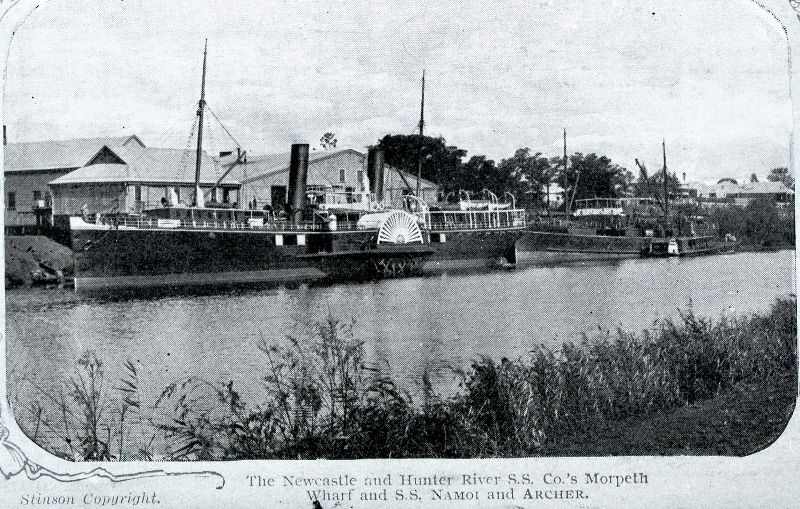
The Narrabeen Camp
With two professional cooks, abundance of food, a fleet of rowing boats, a safe bathing pool, and the primeval bush of Deep Creek, the 120 O.K. lads who entered camp were bound to have a glorious time over the Easter vacation. Rain fell at the beginning, but that provided delightful sticky mud for certain interesting rites, which occurred during the nights, and obviated a more liberal use of boot polish. But when the days were fine and warm youth came into its own, and 'Deep Creek, 1928,' is voted the best camp we have ever held. Praise is due in highest measure to the 'Heads,' who found their joy in service to the lads.
And the devotional ideals of our Order were not forgotten. Who can estimate the blessing which came to us as we united in daily prayer, and, on Sun- day, participated in the services conducted by the Y.P.D. Director? Many will enter upon life again with clearer vision and deeper consecration, be-cause of our fellowship in worship. The Narrabeen Camp (1928, April 21). The Methodist (Sydney, NSW : 1892 - 1954), p. 8. Retrieved from http://nla.gov.au/nla.news-article155299107
Prawning
Although Narrabeen residents would harvest the prawns running to sea in mid-Winter from the Lagoon when that was opened to stop flooding due to rains, their migration to the sea or ‘prawn run’ usually takes place at night during the warm Summer months, depending on the rainfall and moon cycle. The prawns make their strongest run during the dark period of the lunar months. This is the peak time when amateur and commercial prawn fishermen take the best catches as the prawn’s crowd into estuary channels that lead out of lakes and rivers to the sea. Heavy rainfall seems to enhance the migration at any time.
Summer in Pittwater: Places to Stay, Ways to Play - some History, threads collected and collated by A J Guesdon, 2025
